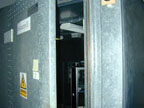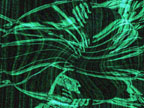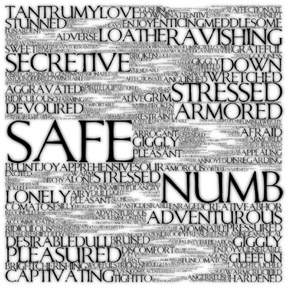« September 2005 | Main | November 2005 »
October 31, 2005
A conversation between...
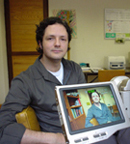
José Luis Barrios and Rafael Lozano-Hemmer
* This is the edited transcription of a teleconference which took place in the Sala de Arte Público Siquieros (SAPS), Mexico City, on the 20th of April 2005, and which was moderated by the director of SAPS, Itala Schmelz. Translation from the Spanish original by Rebecca MacSween.
JLB: The distinguishing factor that defines modernity has to do with self-awareness, or the ability of the subject to both represent and represent self-reflexively his activities and relationships with the world. An important aspect of this is expressed in the Foucaultian concept technologies of the gaze. Throughout the history of art and visual culture various strategies of the gaze have existed. How do you distinguish and conceptualize those strategies that belong to the present and how are they manifested in your work?
RLH: New visual experiments have always been aided, or even initiated, by technological advancements. For example, perspective during the Renaissance, anamorphosis as part of Mannerism, or Eugène Chevreul's color theory for the Impressionists. In this context my contribution is the following: Walter Benjamin spoke with great clarity about the birth of modernism. For him the image is that which can be reproduced mechanically, a condition that eliminates the aural quality from a work of art. Mechanical reproduction democratizes art, popularizes it, and takes away that privileged point of view born of singularity. However, with digital technologies I believe that the aura has returned, and with a vengeance, because what digital technology emphasizes, through interactivity, is the multiple reading, the idea that a piece of art is created by the participation of the user. The idea that a work is not hermetic but something that requires exposure in order to exist is fundamental to understand this "vengeance of the aura".
Today digital art, -actually all art-, has awareness. This has always been true, but we have now become aware of art's awareness. Pieces listen to us, they see us, they sense our presence and wait for us to inspire them, and not the other ay around. It is no coincidence that post-modern art emphasizes the audience. In linguistic theory Saussure would say that it is impossible to have a dialogue without being aware of your interlocutor. Exactly the same thing was said, almost 100 years ago in the art world by Duchamp, for example, when he said, "le regard fait le tableau" (the look makes the painting). What we see happening is that this concept of dependency is reinforced by digital technology. Pieces of art are in a constant state of becoming. It's not that they "are" but that they are "changing into". I think the artist no longer has a monopoly over their work, or an exhaustive or total position over its interpretation or representation. Today, it is a more common idea-an idea that I defend-that the work itself has a life. The work is a platform and yes the platform has an authorship, but it also has its points of entry, its loose ends, its tangents, its empty spaces and its eccentricities. In this sense, artworks tend to be eclectic which for me signifies the liberation of art, the freedom to reaffirm its meaning.
In contrast to the idea of creation through the gaze of the public, the other side of the coin should also be mentioned; the panoptic computerized gaze. Artistic interest in criticizing the predatory gaze of the surveillance camera is nothing new; there is for example the work of Dan Graham, Bruce Nauman or Julia Scher, to mention a few. What is new is the degree of computerization that the new surveillance systems, which invade our public and private spaces, possess. Stemming directly from the American "Patriot Act" is a wide variety of computer-vision techniques that, for example, are intended for identifying suspicious individuals or classifying them based on ethnic traits. It is literally about technologies designed to discriminate based on a series of innate prejudices. This new intensification of surveillance is extremely problematic because, in the words of Manuel DeLanda "it endows the computer with the power of executive decision making". What is also new is the amount of memory that these systems have thanks to ever-smaller storage units and increasingly efficient compression-decompression algorithms (codecs) that allow for the recording and reproduction of events from the distant past. Lastly, the widespread popularization of cameras by reality shows and the penetration into public and private spaces by means of things like web cams should be mentioned. I have no doubt that a new type of art is emerging in order to confront these technologies of the panoptic and post-optic gaze. The Institute for Applied Autonomy, Harun Farocki and the Bureau of Inverse Technology are some examples of this new line of inquiry.
JLB: A fundamental aspect of the connection between technology and language is that which is linked, and this is particularly important in your work, to society. If the machine is language and a space for play, how can we understand its function or connection with social bodies? Let me clarify; in a large part of your work, interventions into the space of the subject are obvious, whether these spaces are public or private. This is interesting because at the same time that you link technology with language (society), you also introduce a type of "principle of intrusion of technology" to both the subject and their space. What imaginary social space do you believe your work opens? Above all I am asking about those pieces that have a direct link to public spaces.
RLH: It depends on the project and how it is received. Often the response to the work is very different from what I had imagined. For example, my installations using giant shadows; the first time I used the projected shadows of pedestrians in a public art piece was when transforming the fa?ade of a military arsenal in the Austrian city of Graz. It happened that in the arsenal there was a painting entitled "The Scourges of God" depicting the three primary fears of the people of Graz in medieval times: a potential Turkish invasion, the Bubonic plague and infestation by locusts. For this installation I invited dozens of artists and thinkers from all over the world to participate in an on-line debate on the transformation of the concept of fear. Perhaps the Turkish threat had been replaced with a fear of an invasion of Yugoslavian war refugees, or instead of Bubonic plague, the current day AIDS epidemic. The debate was projected in real time onto the facade, but I thought I could use the shadows of the pedestrians as a kind of "window" or "scanner" linking the public to the text. I assumed that the shadows would give an expressionistic and lugubrious touch to the piece-I was thinking of Murnau. Also, I wanted the shadows to function as metaphors for fear: for instance fear of the Turkish invasion that never happened but was only a menacing specter. I was totally wrong! As soon as people passed by and noticed the installation they would start to play with their shadows and perform humorous pantomimes. The huge dimension of the shadows allowed, for example, for school children to step on their teachers, or that a man in a wheelchair could roll his twenty-five-meter-high shadow over the others deriving great pleasure from squashing them with his giant wheels. The installation was converted into an ad hoc carnival and nobody thought for one minute about fears, plagues or invasions. This was one of the most entertaining errors of my career. The piece, which was called "Re:Positioning Fear", opened a Bakhtinian carnavalesque space where the environment was artifice and game, an environment that was completely outside of my control, literally and poetically.
My projects with shadows since then have benefited greatly from this lesson. "Body Movies", the piece in which shadows reveal enormous photographic portraits, precisely invites people to play with their representations in a public space and to play at being the "other", like a kind of inverse puppetry. The plastic potential of the shadow is used not as an absence, loss or darkness, but as a window to an artificial reality. We were trying to interrupt convention, routine, the predominant narratives of power that the buildings represented. Cicero said, "We make buildings and buildings make us". Our situation in the globalized city says the opposite: the urban environment no longer represents the citizens, it represents capital. Architects and urban developers build with the priority to optimize cost, and from there to the homogenization of globalization, and from there to the unfortunate reality of contemporary architecture which fetishizes the modular, the formula. It has reached a crisis of representation that carries with it a tremendous avidity of connection. In my work I try to encourage exceptionalism, eccentric reading of the environment, alien memories (meaning, those that don't belong to the site). don't want to develop site-specific installations but rather focus on the new temporal relationships that emerge from the artificial situation, what I call "relationship-specific" art.
JLB: In understanding public space as a carnivalesque space it is also understood why communities developed where-and this also happens with Relational Architecture-there is no subject identified as autonomous and independent. Bakhtin explains in his text on the forms of the carnivalesque in the Middle Ages and the Renaissance that in order for the carnival to succeed there has to be an overflowing beyond the limits of the subject's identity and body. It seems to me that in the examples you provide you reconstitute the carnivalesque condition by means of shadows, not as theatre but as pantomime. What you do is create a carnivalesque space in which the user can intervene and symbolically create a collective body. This is noticeable, for example, in the fact that you intervene facades or the Z?calo Square in Mexico City; by doing so certain symbolic connections to power are deconstructed. In this manner you open a ludic space and deepen the potential of the social body, but you do this via interactive technological supports, reinforcing the imaginary-fantastical aspect of the game. Seen this way, and to delve more deeply into the relationship between the public space and that of the carnivalesque, what place does the orgiastic body have in this game?
RLH: My projects vary so it is difficult to generalize. There are pieces where the body is amplified on an urban scale (Displaced Emperors, Body Movies, Two Origins), others where the body is the canvas (Subtitled Public), and others where it becomes the target of extremely predatory electronic detection (Surface Tension, Standards and Double Standards). There are also others in which the body plays no highlighted role (Amodal Suspension, 33 Questions Per Minute, Vectorial Elevation).
I'd like to make a clarification on a term you used and that is the idea of the collective. I run away from this idea. In the world of electronic art there are two competing trends. On the one hand the unbearable utopian vision of Pierre Levy, amongst others. He proposes a "collective intelligence", virtual communities that form a global village, the idea that we are facing the emancipation of the human race all thanks to inter-connectivity. To me this vision, which is promoted by publications like Wired, is corporative, colonial and naive. I am amongst the ranks of those that reject the notion of community and the collective when it comes to acts of interpretation or perception. I think that we have seen truly disheartening agendas produced in the name of collectivity. In contrast, I really like the concept of the connective -a much less problematic word because it joins realities without a pre-programmed approach. What's interesting is that this concept doesn't convert realities into homogeneity. What Derrick de Kerckhove calls "Connective Intelligence" seems more useful as a concept for linking planes of existence that may be extremely disparate even if they coexist at times. I would even go so far as to define the connective as those tangents that pull us out of the collective.To return to the connection between carnival, body and public space, "Body Movies" is a piece that inspired different behaviors depending on where it was presented. When it was to be shown in Lisbon I thought of the stereotype of the "Latino" who loves to be out on the streets, partying and hugging affectionately so I expected a lot of this type of interaction with the piece. However what we saw was people trying their best not to overlap or interfere with another person's shadow. In contrast, when we presented the piece in England, where I had thought we would see considerable modesty and moderation, people got drunk, took off their clothes and acted out a variety of orgiastic scenes, which was a lot of fun to watch. This anecdote points out the difficulty of making generalizations about the body in a public space, which seems to me like quite a healthy difficulty.
JLB: In your work you make a distinction between "Relational Architecture" and "Subsculptures". Does this distinction correspond to certain connections that you maintain or establish with specific aesthetic systems-architecture or sculpture-or perhaps to formal concepts, for example, scale, or is it more about two arbitrary concepts that allow you to explore diverse issues?
RLH: They are more about arbitrary concepts. They are neologisms designed precisely to avoid being classified with other existing concepts. I first used the term "relational" in 1994 in describing my telepresence installation "The Trace". I found the word in the neurological essays of Maturana and Varela, although I was also aware of pioneering artists like Lygia Clark and Helio Oiticia and their work with relational objects. As well, I was interested in the relational functions of database programs that wove multi-dimensional webs for connecting various fields, a valuable concept when applied to the word "architecture" that for so long has signified solidity and permanence. Lastly, it was a good word in counterpoint to the term "virtual", which emphasizes the dematerialization of experience and asks us to create in simulacra. "Relational" emphasizes the dematerialization of the real environment and asks us to question the dissimulation. Today the term is already dated, partly because of the popularization of the term "relational aesthetics" by Nicolas Bourriaud, which by the way has little to do with my work and was published a number of years after I used the term. For the sake of coherence with my earlier work, I will probably continue to make Relational Architecture pieces maintaining the two grotesque definitions that I gave to the field: "technological actualizations of urban environments with alien memory" (1994) and the newer "anti-monuments for public dissimulation" (2002).
I started the series of Subsculptures in 2003 with the motorized belt piece "Standards and Double Standards". I have already added another three to the series: the kinetic sculpture "Synaptic Caguamas", the interactive screen piece "Glories of Accounting" and the neon piece "Entanglement". It's true that in the majority of cases these are more portable and nomadic pieces than the Relational Architecture installations are, -however I think that at some point I will make huge Subsculptures... so, the scale isn't the difference. I don't yet have a definition of what "Subsculpture" is but I think it has to do with contagion matrices. All of the installations consist of two or more interconnected robotic or virtual entities. The rules of behavior for these entities are relatively simple, but they are dependent on and influenced by the status of neighbouring entities or other inputs, for example the surveillance of the public (my installations almost always "watch the watchers", as Daniel Garcia And?jar would say). In this way, they achieve an unpredictable and emergent global behavior, where turbulence and other phenomena that are products of non-linear processes are found. For example, in "Standards and Double Standards" there are between 10 to 100 buckled belts hung from interconnected robots. A computerized camera system detects a visitor and instructs nearby belts to rotate on their own axis until the belt buckle faces him or her. This local movement then spreads in a process of chain reactions that travel throughout the matrix until the entire field of belts has been affected. If a second visitor enters, then those belts closest to this second presence will be influenced and begin to rotate in the same manner described spreading and influencing the orientation of the entire field. The resulting effect are patterns of interference very similar to those that can be seen, for example, in a tank of water into which various drops fall; some belts remain still, others turn constantly (eddies) and others follow the spectators.
Another aspect of Subsculptures is my interest in Barbara Liskov's "Substitution Principle" that says, in object-oriented programming, that an object of one class can be substituted for another in an inherited class without changing the properties of the program. It's something like the concept of metonymy in psychoanalysis or linguistics and like the categorical syllogism in philosophy called the "minor premise" or "subsumption". Liskov's Substitution Principle is, for me, extremely useful when it comes to making symbolic transferences between disparate or copresent realities. For example in "Standards and Double Standards" the belt substitutes the figure of masculinity, the father, authority. I'll give you other examples: in "Synaptic Caguamas" beer bottles play at being neurons in an algorithmic simulation of cerebral connections; in "Glories of Accounting" the raised hands are both metaphors of the Fascist salute and of the Spanish anti-terrorist gesture of "manos blancas" ("white hands"), -the hands also simultaneously signify distance (as in a "stop" gesture) and inclusion (as in the expression "show of hands"); and a last example, Entanglement, in which the neons connected to the Internet substitute for the photons linked by quantum mechanics.
Contrary to what the Substitution Principle asks for, in my Subsculptures substitution has a formal impact: it leaves a symbolic residue and destabilizes equivalencies. This residue is the strength of the piece, its poetry and its absurdity. For this reason I propose anti-modular strategies for artwork. I like breakdowns, the remainder in a division, and rounding errors. I find modularization boring and homogenizing. Modularization is promoted by:
* Computer science, through object-oriented programming, or plug-ins
* The art world, through the idea of authorship and bienialism
* Capital, as an instrument of control and quantification
* Architecture, using the formula as a solution (see Norman Foster)
* Education, through the modernist idea of specialization
No doubt my work is often quite modular, above all in its fabrication and sale, and it's better to confess it even though it is a contradiction, because one cannot live outside of the zeitgeist.
I think that Relational Architecture, like Subsculpture, can exhibit the anti-modular, symbolic inequalities or develop itself in the matricial space of rules of contagion. So there is no definite line that separates the two series. It is true that the Subsculpture series is slightly more personal; perhaps it is more an investigation of psychological spaces than of urban ones. I have been doing psychotherapy for four years now and maybe that explains that!
JLB: I would like to go back to the problem of non-linear mathematics and its relationship to "Synaptic Caguamas". When information is flow, a multi-perspectival flow that unfolds in various dimensions, it introduces the notion of "possibility" as a form of construction. It's interesting to me that this piece is not built on random relationships but that it is more about variables and vanishing lines configuring the system of representation. Keeping this in mind, I would like you to explain how this flow of information operates aesthetically as a system of self-management and self-configuration.
RLH: Recursive algorithms, chaos theory, cellular automata, digital genetics and other descriptions of complex dynamic processes are fascinating because they appear to be alive, to have life. Some exhibit evolution, others morphogenesis, and still others management and self-control. Mathematics associated to this field originate from various places, one of them being Weiner's postulation of the theory of Cybernetics in Mexico City in 1946, -it's definitely not something new. If during the Renaissance perspective and Fibonacci's series were used as media to legitimize the production of representation, today we can and should make dynamic mathematics our media. The Renaissance subject emerges precisely from the privileged vision of the vanishing point. What might be the equivalent impact as we contemplate, say, a fractal pattern? These mathematics shatter humanism, fortunately. They allow artists to design work that disobeys us (and the critics).
Until these mathematics reached the art world one of the only strategies that the artist had to create unexpected processes, for example a kinetic sculpture or automatic poetry, was chance. The people whom I most admire worked with chance in a very serious way -like John Cage or Marcel Duchamp- but I think that randomness is not that interesting anymore. Not even the greatest computer in the world could generate numbers that are truly random. Today we accept that the occurrence of a hurricane isn't due to bad luck but due to the consequences of a non-linear system of energy distribution (Lorenz's famous "fluttering of the wings of a butterfly on the other side of the planet"). Of course this doesn't mean that there is a destiny or that everything is predictable, it's exactly the opposite. These mathematics show us that uncertainty is inseparable from the system being observed, and artists love to work with uncertainty.
Today it is possible to create art from seeds, which actually is called "seeding the initial conditions" for a process, and then the work unfolds via mathematics in ways that you cannot control. You'll notice that every three minutes the bottles in "Synaptic Caguamas" line-up and reset themselves. This is done to give new initial conditions and to generate a variety of behaviors because on occasion the emerging patterns are boring or the bottles remain locked in what is referred to as "dynamic equilibrium".
Complexity describes processes like neuronal connections, genetic mutations, and the variegation of leaves. There is an infinity of examples of how non-linear mathematics permeate almost all of our natural and social history. Manuel DeLanda writes about how this dynamic flows can be used to understand history in a non-linear way, - -it's not about the selective recording of facts, dates and heroes, but rather it's about understanding history in terms of fields of attraction, of isobars, of influences, which is how non-linear math works. We want to visualize these flows, animate them, and evoke them so that they can help us give shape to our work.
JLB: "Subtitled Public" is a piece that isolates chance. When we were speaking about the piece a while ago, you said that it was a little like Mallarme's roll of the dice. One roll of the dice, as in this piece, puts in motion a mechanism where poetry, theatricality, technology and non-linear mathematics construct a complex space of meaning. A space where language names me and, at the same time, the body is interpreted as a shadow. How do you explain the connection between intrusion and evasion in this piece when it is a metaphor for the society of surveillance? What importance does the interaction of the spectator have with the piece as a sort of "subversion" of the fact that in the contemporary world "I am named"?
RLH: Chance is present in "Subtitled Public": A visitor is detected by a computerized surveillance system and the computer randomly selects a verb, conjugated in the third person, and is then projected onto the visitor's body. The visitor cannot get rid of the word that will follow him or her throughout the entire exhibition space, unless physical contact is made with another visitor, in which case they swap verbs. The use of chance in this piece has an important ironic component. Here we have a display of surveillance technology detecting the public's presence with great precision. The system pretends to have the ability to identify moods, gestures, desires and actions, but in the end it is chance that takes this to an absurd level. It's a comment on identification technologies that I spoke about in the beginning of this interview. I use chance, a throw of the dice, when criticizing the ridiculous systems used for example by the Department of Homeland Security in the USA that are trying to identify suspicious individuals.
Surveillance never tires of taking possession of our words and images. In my recent work I ask what would happen if all the cameras became projectors and gave us words and images rather than take them away from us?
In a piece such as this one I like the public's rejection to "being named". When we enter a piece of art or a public space, we all have certain values that are given to us by what we read, who we know, who we have seen etc. What I want is to shake up those values and create something dysfunctional, a moment of resistance and of rejection of those preconceived mantras. I look for the "special defects" that allow me to activate the imperfections, the disruptions; "to disrupt" seems to be the most precise term for describing what I want to do. The system projected the words "se mea" ("she urinates") onto a friend of mine who came to the opening and the words chased her through the exhibition space until I finally showed her how to rub them onto someone else. For me it's valuable that there is a moment of resistance to the assigned label, that people don't accept the subtitle nor see it as an oracle, that they are always conscious of the lie. I loved the comment of one visitor who said, "I got the word 'inv?lido' (handicapped), and maybe I am handicapped but I don't exactly know in what way" and there was another person who said, "you put on a psychological outfit depending on the word you get".
I think we are not done with exploring the culture of paranoia. I don't feel happy having to make art that works on that level, however I think it is extremely important to do so. What has been happening since September 11th is very, very serious. The authorities believe in the huge fallacy that the solution to terrorism should be technological. I react against that. We must use the distortions of the camera, and underline the innate prejudices of our media, of ourselves. Next time a person stops in front of a surveillance camera they might expect to have words projected on his or her body, and know that it is highly likely that they will not agree with the subtitle assigned to their public body.
Posted by jo at 02:22 PM | Comments (0)
MobLab
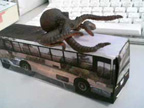
Origami Bus Pattern
For the MobLab [Related] bus adventure (a bus-gallery with on board artists-Mobnauts who challenge conceptions of public space), Kensuke Sembo and Yae Akaiwa from exonemo are filming sceneries from the window of the traveling bus. The Road Movie is made available for visitors to download from the internet.
Downloaded frames from the Web cam, which change every three to five minutes on the Web site, are complete with dotted lines for cutting and folding, and can be printed out and transformed into a paper sculpture of the Moblab bus with windows showing the captured images.
It's a way of bringing public space into private homes and computer cubicles, says Sembo. "We think using paper craft in this way is a sign of other space invading your own space."
Part of the MobLab project, touring Japan, Tuesday 18 October - Sunday 6 November. There's a report on what's going on at MobLab in Asahi and on the MobLab blog. Image. Also by exonemo: Shikakunomukou. [blogged by Regine on we-make-money-not]
Posted by jo at 12:23 PM | Comments (0)
Electrical Walks
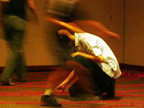
Amplified Currents
Electromagnetic induction is based on the sounds resulting from the mutual interaction of magnetic fields. Audio artist Christina Kubisch developed magnetic headphones with magnetic coils that respond to electrical fields in the environment. At first she tried to filter the hum of the electrical wires out of the headphones. But the increase and spread of "unwanted" electrically-produced sounds inspired Electrical Walks. With special, sensitive headphones, the acoustic perceptibility of aboveground and underground electrical currents is thereby amplified.
The palette of these noises, their timbre and volume vary from site to site. They are ubiquitous. Light systems, transformers, anti-theft security devices, surveillance cameras, cell phones, computers, elevators, antennae, navigation systems, automated teller machines, neon advertising, etc. create electrical fields that are otherwise undetectable.
With the headphones and a map of the area, upon which the especially interesting electrical fields are marked, the visitor can set off for a special kind of stroll in cities. The perception of everyday reality changes when one listens to the electrical fields; what is accustomed appears in a different context. Nothing looks the way it sounds. And nothing sounds the way it looks.
Electric Walks is part of Her Noise, an exhibition featuring 5 installations by artists who use sound as a medium to investigate social relations, inspire action or uncover hidden soundscapes, at the South London Gallery, 10|11|2005 - 18|12|2005. See also the interview of Christina Kubisch in Audiohyperspace. Related: aetherspace, Electroprobes, the Amazing All-Band Radio, etc. [blogged by Regine on we-make-money-not]
Posted by jo at 12:20 PM | Comments (0)
Project Entropia
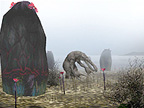
Gamer Buys Virtual Space Station
"A virtual space resort being built in the online role-playing game, Project Entropia, has been snapped up for $100,000 (£56,200). Jon Jacobs, aka Neverdie, won the auction for the as yet unnamed resort in the game, which lets thousands of players interact with each other. Entropia also allows gamers to buy and sell virtual items using real cash.
The space station is billed as a "pleasure paradise". Last year, a gamer bought an island for $26,500 (£13,700). The space station is described as a "monumental project" in the "treacherous, but mineral rich" Paradise V Asteroid Belt and comes with mining and hunting taxation rights. With the price tag also comes mall shopping booth and market stall owner deeds, a land management system, a billboard marketing system, and space station naming rights. Neverdie is a popular and well-known in-game character. He and another character, Island Girl, appeared in a 2003 dance music movie Hey DJ!, which starred Jon Jacobs, Charlotte Lewis, and Tina Leiu..." From Gamer buys virtual space station, BBC News. [Related]
Posted by jo at 11:01 AM | Comments (0)
sisterO mauro-flude

All Of Us (girls) Have Been Dead For So Long...
A girl pays homage to damned but beautiful women with bad habits & links these to myths having survived in sagas & fairy tales. She undertakes a journey into the land of the dead in order to become free. She loves the land of the dead. It has as a kind of opiate oblivion beauty, but she resists death. She refuses death on behalf of all the dead girls and also rages at the emptiness of life. Surviving in life despite its inadequacies and infuriating restrictions. She has returned with a powerful force, back into the land of the living. Survives as a fugitive, eluding the authorities that would attempt to transform her into death again.
Wednesday Nov. 16: premiere at 20h30; Thursday Nov. 17: performance ar 20h30; Melkweg Theatre, Lijnbaansgracht 234A, Amsterdam; Reservations: 020 531 8181. Price: 8/7euros. Related website; Images.
Concept/Performance/A/V: Nancy Mauro-Flude
Text: Kathy Acker - extracts from Novel 'Pussy King of the Pirates'
Sound: Lisa Gerrad, Golden Retriever, curseovdialect, The Gits
Dramaturgical Advice: Edit Kaldor
Choreographic Advice: Rose Akras
Technical & Artistic Support: Duro Toomato, Linda Dement, Kristina Anderson, Fiona Tan.
Production Manager: Alexander Godschalk
Thankyou: Theatre Platform Pick Up, DasArts, Pete Zwart Media
Posted by jo at 10:47 AM | Comments (0)
PDradio
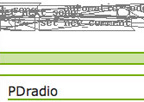
A Self-Regulating Virtual Radio Station
PDradio, transmitting computed sounds in Pure Data format. The definition of streaming 'radio' involves a fundamental difference with respect to traditional radio, that is, the possibility to organize a deterritorialized and computable flow of sound data. The PDradio project, by Winfried Ritsch and Georg Holzmann, makes this possibility concrete. This radio station transmits Pure Data files uploaded by the audience and selected by a software-dj compiled in the code. This artificial entity also announces the pieces using voice synthesizing functionalities, telling the file name and the associated metadata, sprinkled with impromptu communications. If a user shows his appreciation for a piece, the dj will generate a personalized playlist. PDradio runs on a Linux server with the programs Zope and Plone and the calculated music follows the composition scheme, that is, the rules of this ductile tool, aesthetically reflecting them in the loops used in its compositions. It's pure electronic music with a wide range of styles, but which can't detach itself from machinic frequencies. If we may talk of 'genre', it abstracts the usual musical style categories to trascend into a style of composition, recursively widening its concept. [via neural.it]
Posted by jo at 10:38 AM | Comments (0)
DATA Browser
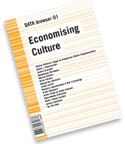
The Truth About Networks
The Truth About Networks: Between the total hell of networked, salaried labor and the promises of the commons by Trebor Scholz
In short succession the first two in a series of publications called DATA Browser were just released. Both start out with historical texts to search for effective contemporary models of cultural production that merge socio-technological with artistic critique. 'DATA browser 01' takes Theodor Adorno's and Max Horkheimer's notion of the culture industry (1944) as a departing point. 'DATA browser 02' links to Walter Benjamin's essay 'The Author as Producer' (1934). Let's start with Brian Holmes' essay 'The Flexible Personality,' which contributes a rare meditation on today's network society and sketches out an intellectual history of anti-systemic movements that becomes the critical backdrop for both volumes of 'DATA browser.' Here, the Paris-based art critic, activist, and translator Holmes leads us into a social landscape of total network hell.Together with the social theorist Maurizio Lazzarato, Holmes is not on board when it comes to the techno-utopian celebration of the networked life style. Lazzarato thinks that new networked techniques are even more totalitarian than the assembly line.
Brian Holmes includes a reference to Adorno's notion of the authoritarian personality (1950), which is defined by its rigid conventionalism, submission to authority, opposition to everything subjective, stereotypy, an emphasis on power and toughness, destructiveness and cynicism, and an exaggerated concern with sexual scandal. Holmes criticism of networked labor is sharp - he argues that distributed, casualized labor is based on the ruthless pleasure of exploitation and soft coercion that the laptop as portable instrument of control affords. The Italian philosopher Paolo Virno places questions about idleness, leisure and the refusal to work at the center of the discussion about contemporary production.
Brian Holmes points to the 'de-localized' production of the 'networker' or 'connectivist' that helps today's firms to eradicate social programs. In 'flexible capitalism' networked, salaried labor can be easily monitored and leads to ever more surplus that can be extracted from the laborer to the rhythm of the mouse click. Holmes uses the term 'prosumer' for a consumer who becomes an amateur producer within the networked enterprise. According to Holmes the networker as satisfied individualist and hyperactive single is always ready to jump and take advantage of every opportunity and is left unmoved by all the data mining and acceleration of consumption. In his essay 'The Producer as Power User' Pit Schultz, who describes himself as 'social media architect' also talks about the marketing term of the prosumer and introduces the 'power user' (neither amateur nor professional). Dependent on the participation in the global communication apparatus everyone is a power user. According to Schultz, the workplace becomes a state of mind for the power user aiming for total productivity. The power user comes in different degrees of machine addiction and is an advanced user with administration and customization skills. Her unpaid labor mainly pays off through the social reputation economy created from social capital gained from contributions to the gift economy of the public domain. The power user follows the 'I post therefore I am' so that more links go to and from her name and URL. And when she publishes in books and journals, she references her ephemeral online materials. The power user produces ever more redundant work that inevitably Leads to radical mediocrity and 'panic publishing.' Power users love free content and are passionate about the growing open archives.
Other 'DATA browser' essays add a variety of examples that shed light on the hopeful potentials of network culture and open environments. The texts in these two volumes respond to the civic disengagement and decline of social Connectedness and look for ways to re-connect us with the anti-systemic oppositional culture of the sixties. How can new forms of solidarity emerge and help us to create a better society based on the desire for equality? How can collective projects, and communicative activism serve to foster distributed creativity, peer relations, openness and collaboration? Which case studies can be presented that dismount criticism of blind idealism when it comes to the commons? Today's culture-activists from Delhi and Pittsburgh to London operate through technology and networks that have the ability to reconfigure power relations through the creation of knowledge pools, free wireless networks, and sharing of information in open archives. Browsing through the texts in Db 01/02 theoretical threads lead from Paolo Virno's 'A Grammar of the Multitude,' and Manuel Castells' 'Rise of the Network Society,' to Michael Hardt, Richard Barbrook, Cornelius Castoriadis, Tiziana Terranova, and Naomi Klein. It is clear from these examples that theory here is not groomed in the academic observatory but conceived of as tool that is linked to practice. In fact, reading these texts I felt like going through a transcript of a round table discussion in the sense that the authors have much common theoretical ground.
In these two volumes theory, art and political action inform each other rather than being conflated with one another. While Holmes and Schultz demonstrate new typologies of the networked laborer, the Delhi-based group of media practioners 'Raqs Media Collective' points to an alternative reality. In their essay 'X Notes on Practice' the group points to Argentinean workers, who faced with a failed money economy, developed their own exchange system based on self-regulation and free interchange outside of the circuit desired by capital.
Within the cooperation commons people create and distribute content. This overwhelms traditional companies that cannot match the massive amount of free content created by a multitude of user communities. These cultural reservoirs and much of cooperation-enhancing technologies allow the like-minded to connect and share knowledge. This has the potential to undermine the content hegemonies of universities, museums, companies, and the military.
Knowledge pools put in place unorthodox knowledge economies. They are communal, exchange spaces that allow anyone to re-use/share and edit content. Users move away from systems of production and distribution that are based on market relations. The London-based writer, artist and curator Armin Medosch emphasizes that the most important property of the internet is its capacity to promote the creation of social communities. He reminds us of the slogan 'Under the cobblestones, the beach!' which was used during the imaginative student protests in 1968. As example for the formation of groups in the internet Medosch describes the ad hoc mode with which the democratic globalization movement approaches spontaneous organization and mobilization. Medosch makes us also aware of the opportunities afforded by ubiquitous, unwired networks such as the free wireless network groups Consume.net in London, Freifunk.net in Berlin and Funkfeuer.at in Vienna, that all follow a decentralized, self-organizing network model. In a similar search of new modes of cultural production The Institute for Applied Autonomy and The Bureau for Inverse Technology both infiltrate and critique the culture of engineering from the inside.
This series of "DATA browser" books is published by Autonomedia in New York. Its overall goal is to link emerging cultural practices to the socio-historical context out of which they evolved. Data that are sent through the physical networks of the internet are mostly interfaced through a screen and interpreted by a browser. Browsers such as Firefox display these data packages that they receive from hosting servers. In a similar manner, this series of publications frames and interprets cultural practices that bring together social, technological, and artistic critique. In a third volume that will come out early 2006, the editors will follow the conference 'Curating, Immateriality, Systems' at TATE Modern (London, June/July 2005). This event investigated a range of positions currently occupied by curators in the context of digital media and immaterial production. This upcoming volume 'Curating Immateriality' will examine ways in which new media artworks are curated taking into account their ephemeral and collaborative nature. Theory in all volumes of 'DATA browser' is not seen as a final word on the topics that it engages - with most essays adding to a collaborative flow of ideas about networking, and current modes of cultural production. http://www.data-browser.net
ECONOMISING CULTURE: ON THE (DIGITAL) CULTURE INDUSTRY
edited by Geoff Cox, Joasia Krysa & Anya Lewin
contributors: Carbon Defense League & Conglomco Media Conglomeration | Adam Chmielewski | Jordan Crandall | Gameboyzz Orchestra | Marina Grzinic | Brian Holmes | Margarete Jahrmann | Esther Leslie | Marysia Lewandowska & Neil Cummings |Armin Medosch | Julian Priest & James Stevens | Raqs Media Collective | Mirko Tobias Sch…fer | Jeremy Valentine | The Yes Men Published by Autonomedia (DATA browser 01) 2004, ISBN 1-57027-168-2, 256pp.
ENGINEERING CULTURE: ON 'THE AUTHOR AS (DIGITAL) PRODUCER'
edited by Geoff Cox, Joasia Krysa
contributors: The Institute for Applied Autonomy | Josephine Berry Slater | William Bowles | Bureau of Inverse Technology | Nick Dyer-Witheford | etoy | Matthew Fuller | George Grinsted | Harwood | Jaromil | Armin Medosch | Raqs Media Collective | Redundant Technology Initiative | Pit Schultz Published by Autonomedia (DATA browser 02) 2005, ISBN 1-57027-170-4, 240pp.
Posted by jo at 10:05 AM | Comments (0)
Res Publica
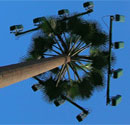
netPublics
During 2005-2006, The Annenberg Center for Communication at The University of Southern California is sponsoring a research group on “Networked Publics."
netPublics explores the roles of audiences, activists, citizens, and producers in maturing networked media ecologies. These changes include but are not limited to the changing relationship between production and consumption, viral and peer-to-peer distribution, and networked lateral political mobilization. Although the Internet is clearly a central player, we consider media forms both old and new as part of a much broader media ecology undergoing profound social, technical, and cultural transformation.
Posted by michelle at 09:53 AM | Comments (0)
Free Soil's F.R.U.I.T.
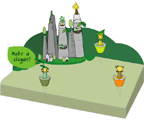
Exploring your City and its Connection to the World via Fruit!
Join an online demonstration. Your words will be part of a two year traveling exhibition. Remember to fill out the survey and add your urban plan dreams!! F.R.U.I.T. takes up the challenge of elevating the ecological knowledge of consumers and encouraging a way of life that is friendly to the environment. We want consumers to be conscious of the entire life of a product, from production to utilization, and not just what they see in the stores. Consumers must be aware that every phase of a product's life influences the environment and ourselves.
Free Soil has produced a run of F.R.U.I.T wrappers, a website, and a traveling installation as part of an initiative to inform people about alternative food systems and local food movements. The wrappers are disseminated throughout the food chain by piggybacking on oranges. Information will be carried through the food system and into the hands of consumers. The wrapper holds information on a variety of aspects concerning food movements, transport and urban farming. Get your daily dose!
Posted by jo at 09:50 AM | Comments (0)
Digital Storytelling Festival
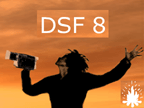
Scape the Hood
Just wanted to let everyone know about the 8th annual Digital Storytelling Festival in San Francisco Oct 7-10 hosted by KQED, public broadcasting. There will be a large locative media presence. The opening night party is the launch of the 'Scape the Hood mediascape, Using GPS-enabled HP iPAQs and software developed by HP Labs, participants will walk the streets and listen to the neighborhood stories, taking in the sights, sounds, and smells from both the physical and virtual worlds.
Peel back the layers of the neighborhood and explore narrative archeology with us. Hear the stories of Project Artaud, once the American Can Company, now transformed into a dynamic live/work space for artists. Experience the Mission Village Market, a bustling flea market on Saturday, but just a ghost of itself on Sunday. Transport to the environs long since erased by the overlay of the city.
Join us for food, fun and the release of the Scape the Hood mediascape, an experiment that combines storytelling and emerging technology by overlaying a digital landscape on the physical world.
The Digital Storytelling festival also includes a session on Situated Storytelling with panelists Nick West, Hana Iverson, Jo Reid, as well as a gaming session discussing place-based tools and techniques.
For more information on the mediascape: lrule[at]kqed.org
Leslie Rule
Project Supervisor
Digital Storytelling Initiative
KQED, Public Broadcasting, San Francisco
(cel) 415-225-1925
New website is up: www.kqed.org/dsi
Posted by jo at 09:29 AM | Comments (0)
NODE.London
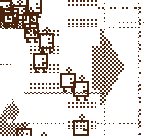
E:vent Collaborative Residency
NODE.London [Networked, Open, Distributed Events. London] is a season committed to building infrastructure and raising visibility of media arts practice in London. Working on an open, collaborative basis, NODE.London will culminate in a month long season of media arts projects across London in March 2006.
As part of the season, E:vent will host a month long collaborative residency for London-based electronic musicians, media artists and architects. Threshold will set a conceptual thread around ideas of threshold, topology, landscape and borders, with the objective of transforming E:vent's lower warehouse space into a dynamic and interactive environment.
To apply or for further information, please send statement of artistic practice, CV and URLs for existing & past projects and additional supporting information to residency[at]eventnetwork.org.uk. Closing Date for applications: 1st December 2005.
Posted by jo at 09:19 AM | Comments (0)
Architecture of Interaction
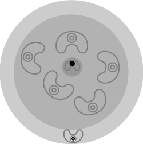
Standard Vocabulary, Generic Models >> Toolkit
Architecture of Interaction [AoI] is a project initiated by a group of artists and theorists who are collectively aiming to create a toolkit which can be used to describe the processes and effects of interactive work. This toolkit will consist of a standard vocabulary which can be used by individuals from different artistic backgrounds, as well as a set of generic models that describe six different critical dimensions of interactive working methods. The editors of this site want to connect vocabularies and ideas about art and interaction from various disciplines, namely theatre, visual arts, performance and new media.
Why?: The initiators--Klaas Kuitenbrouwer, Yvonne Dröge-Wendel, Lino Hellings, Anna Best, Mina Kaylan, Nikolaus Gansterer--have several reasons to do this. The interest in interactive artistic work methods continues to grow among makers, curators and commissioners. Yet, each discipline (and often each individual artist) has an independent language for describing interactive works. These languages don't mingle well at all. There is therefore currently too little scope for communication between artists from different disciplines. This often means that the nuanced and vital elements of interactive art works are overlooked.
So?: The main goal of making this toolkit is to make interactive work methods more transparent for makers, commissioners, curators, critics and more general audiences. In doing so, we hope to contribute to both artistic development of interactive works, and to a more sophisticated criticism in the practice and discourse of interactive works.
What works do we (the editors...) call interactive? We see interactive work methods as a kind of meta-discipline, as a disclipline that informs other disciplines. Interactive work methods can be applied to any artistic discipline. Yet, at the same time, these methods have qualities and notions which are entirely their own. From the standpoint of the maker, an interactive work begins when a maker designs the form of the work, the context of the work, AND possible experiences or perceptions for the others that come in contact with his work. In other words, we begin to speak about interactive works when a maker considers the intelligent context as an intrinsic part of the work.
Posted by jo at 09:00 AM | Comments (0)
October 29, 2005
Mood Swings
![]()
Inciting Responses to Transmutations
Victoria Vesna's interactive installation, Mood Swings, creates states of emotion and perception by translating the viewer's body into a swarm of moving particles that change "moods" from one extreme to another. As the visitor's image is captured on a live video camera, radical shifts in color and sounds occur in the projection while particles and poetic texts emerge and dissolve in response to the viewer's movement. The seven colors change with audio shifts, moving from irritating and disturbing to peaceful and calming. The use of new technologies in Mood Swings creates an interface between virtual and real worlds and engages the viewer by inciting responses to the audio and visual transmutations.
Media and Medicine for Communities partner Victoria Vesna developed the interactive exhibition "Mood Swings" for the Inside Out Loud exhibit, the first significant survey of contemporary American art to explore critical issues related to women's health.
Posted by jo at 06:38 PM | Comments (0)
Mobicasting

Let 1,000 Machines Bloom
Mobicasting. Let 1,000 Machines Bloom by Stevphen Shukaitis, Sophea Lerner, and Adam Hyde
Let us suppose that life is a dance, a chaotic unfolding of bodies in motion, repeating but utterly unique gestures tracing lines of flight over the unfolding of the new earth these steps create: the resistance of fleshy bodies and their collisions embodying the limitless nature of human experience, from the antagonism of the unexpected blow to the warmth of the gentle caress. Each interaction always exceeding our capacity to enunciate its experience but paradoxically embodying the very basis from which we come to communicate, to relate, to describe in common.
Stepping back from the metaphor consider: is the art of political communication all so different from this? Moments of creation, resistance, and expression--from the collaboration of gardeners growing a patch of vegetables in a community garden to mass actions in the streets--are constituent elements in an on-going process of creating new forms of sociality and community, new forms of life. But in the same way the experience of motion always exceeds our ability to express them, forms of political communication stumble on the gap between an ever present sensation of movement and our attempts to describe it. The intricate weaves of affective bonds, experiences, and memory tatter and fray from their immediacy in the shaping of representation. And all too often attempts to describe become methods of capture, transforming vibrancy into pallid reflection.
The tension between the inside and outside of experience, between the emic and the etic, has long frustrated attempts to communicate the immediacy of experience beyond itself. From the bodies in streets proclaiming their collective desires to busy hands of artists and philosophers shaping singularities with creative technics, we find ourselves caught in a dynamic where the description of an experience or event forces one to step outside of it into the logic of removed narration. When asked "so what happened" one can attempt to piece together a sense of the event through collections of its bits and pieces or to attempt to grasp the whole through description, binding oneself away from the event through the separation of inscription. Such dynamics find themselves seeping into even the most earnest forms of independent media where all too often logics of professionalization and attempts to gain legitimacy lead to communication constrained by format and expectations.
Mobicasting is a new platform of media technology by Adam Hyde and Luka Princic developed for "Capturing the Moving Mind" that provides possibilities for addressing these dynamics. It is at once two ideas. The first is technical: build a system to deliver 'pseudo-live' video from any device capable of delivering images by email. The second is tactical: build a system that enables the production of video reports positioning the mobile phone as a networked 'outside broadcast' studio. The first goal is an exercise in developing models of 'broadcasting' that employ the simplest technologies possible. Simple technologies are the ones we already know how to use. So simple is the idea: send a sms or an email with attached images, sound, text or video. In the subject line of the email put the name of a video program. This is your new 'program.' This, material is then compiled into a video as either a 'live' stream or as a downloadable video file. That's the tech, but the pay-off is the tactical side, for which the tool was built. With this mechanism it is possible from any device capable of sending email to make collaborative online video content. This can be used for capturing moving minds, or it can be directly used as a device for reporting on events that are normally out of the reach of wired or wireless internet connections.
Sitting in tension between the fragmentary ingestion of experience and the formation of a narrative flow, this represents an attempt to move beyond the logic of post-production. As a pragmatic solution to challenges around limited bandwidth, instead of a smooth stream, which always represents an almost-recent-now over a fragile connection, fragments of media can be aggregated from numerous sources into a continuously flowing output subject to repetitions, sporadic updates and an ad hoc alphabetical editorial algorithm. It is both processed and raw at the same time. An open archive of media materials formed from the multiple experiences and perspectives embodies of a wealth of ingredients that can be creatively redeployed, mixed, interspersed, and scrambled proliferating into journals, art exhibitions, films, manifestos, and forms of media art. Not knowing what others will be contributing or what they are intended for Mobicasting is a platform designed with a high degree of user hackability; it creates an interface for the flexible shaping, reshaping, and ordering of media materials for creative uses, many of which may not have been anticipated beforehand.
Rather than shaping the description of an event afterwards into an accepted narrative framework, Mobicasting allows for the on-going modulation of an event representation as part of the production of relations and interactions that construct the event itself and networks of relations formed out of it. As a social technology of dispersal and transmission Mobicasting exists in their interstices between the technical apparatus of media production and corporeality and immediacy of experience. It creates a space and method where an emergent collectivity and the flesh of the event can construct and shape its representation in a process immanent to its own unfolding.
The goal is not to construct a high tech other within the created social space, but rather to open up a space for the collective shaping of self-representation and narration as a part of the unfolding event whether a conference on a train making its away across Siberia or any other gathering at which Mobicasting could be useful. It is a platform for the enabling of emergent narratives, an indeterminate media form in that the frameworks, structures, and memes generated are open to the situation in which they find themselves created and are shaped out of them. It allows for forms of media production that are enmeshed within the aesthetics and affective conditions of their creation. Things like Mobicasting in this sense could not just be one more trick up the sleeve of media activists but potentially offers a format and for collective mediation shaped through the technological environments we find ourselves in. By enabling collective participation in the shaping of an event?s representation and the technology through which this is done it transforms the dynamics of attempting to capture experience into those of creation beyond and through the collectively created experience.
This is not to say that tension between capture and representation, between experience and articulation, has been finally and successfully addressed through the promises of yet another piece of high tech gadgetry. Far from it. And perhaps the very dynamic that new forms of independent media attempt to address the ones that are the most important are the hardest to handle: why does one want to capture a moving mind in the first place? What fuels this desire for mobile communications to transcend distance as if they could become transparent and now for the first time create an ideal speech situation and democratic public sphere? Emerging from today's cybernetic salons develop new privileged forms of mobility that desire constant connection with distributed forms of community created by their owns movements; these traces and reflections, recorded through mobile media forms, often constitute its own self-referential and self-contained audience. The dividing line between reality TV style titillation and collective documentation, between the corporate media logic of rolling news coverage and grassroots media, increasingly blurs and breaks down. It very well may be in that trying to capture a moving mind we are captured by our very desire to form coherent forms of self-representation; have we formed a polyvalent and participatory media panopticon where the inmates all watch each other, recording every motion, utterance, and moment from multiple angles and modes of inscription? Mobicasting by building itself on a open platform suggests possibilities for reshaping its usage and deployment in new forms that are open to the multiple and fluctuating forms of desire, motivation, and connections we bring to media communication.
The multiplication and expansion of new forms of movement, experience, and life must find ways to escape, to move through and beyond a logic of representation which confines them into updated versions of the same old story. It is a form of walking while asking questions, not only about the world and our shared experiences, but also questions about how we pose and represent these questions to ourselves. It may stumble awkwardly trying to find its footing, perhaps even tripping over its own immaturity at points, but is ultimately in strengthened within the molecular proliferations from which it emerges. Rejecting both uncritical techno-utopianism and na?ve Luddism the task is to seize upon possibilities for political communication by working from the social dynamics of technology and the technical forms extended across the entire social field. Let then a thousand machines of life, dancing, celebration and movement bloom across the endless fields of human experience.
The mobicasting system is free software, and is documented at
http://www.streamingsuitcase.com
The system was realized in context of the Transsiberia web documentation project produced by in collaboration with m-cult and Kiasma. http://www.kiasma.fi/transsiberia/stream.php
Stevphen Shukaitis is non-vanguardist social researcher and President of the Thomas M?nzer Fan Club. Sophea Lerner is a sonic media artist based in Helsinki and an avid fan of intergalactic underwater basket weaving. Adam Hyde is a new media artist working at the convergence of broadcasting and Internet technologies and is currently the Chinese Travel Scrabble World Champion. [Related]
Posted by jo at 02:08 PM | Comments (0)
Locative Media as Socialising and Spatialising Practices:
Learning from Archaeology
"Abstract: Pervasive computing and locative media are emerging as technologies and processes that promise to reconfigure our understandings and experiences of space and culture. With the critical hand of material and cultural studies, we start to shape questions about locative media representations of urban mobilities, and begin to unearth some of the struggles and tensions that exist within these fields of operation. By looking at archaeology’s constitutive processes of collection, ordering and display we highlight some of the problems found in mapping people and objects in space and time, and ask what kinds of social/spatial relations are made possible in particular locative media projects. Ultimately, we take archaeology’s critical focus on authorship and ownership, explain its relevance to locative media, and suggest questions to consider in the future research and design of locative media." From Locative Media as Socialising and Spatialising Practices: Learning from Archaeology (draft) (PDF), by Anne Galloway and Matt Ward.
Posted by jo at 11:32 AM | Comments (0)
October 28, 2005
Emerging Technology:
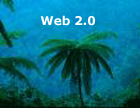
Web 2.0 Arrives
"Some technological revolutions arrive as revelation...Other revolutions creep up with more subtlety, built of tweaks and minor advances, not radical breakthroughs. E-mail took decades to gestate, but now many of us can’t imagine life without it. There’s a comparable quiet revolution under way right now, one that is likely to fundamentally transform the way we use the Web in the coming years. The changes are technical and involve thousands of individual programmers, dozens of start-ups, and a few of the largest software companies in the world. The result is the equivalent of a massive software upgrade for the entire Web, what some commentators have taken to calling Web 2.0. Essentially, the Web is shifting from an international library of interlinked pages to an information ecosystem, where data circulate like nutrients in a rain forest..." From Emerging Technology: Web 2.0 Arrives by Steven Johnson, Discover, Vol. 26 No. 10. [Related]
Posted by jo at 10:48 AM | Comments (0)
Psychovideography
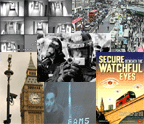
Fortress Urbanism
And so now New York City may attempt to install the total cinematic dream that has consumed London's private security firms for the past three decades, lost as they are in the Warholian ecstasy of filming every last centimeter of urban space, week after month after year, in what is surely the largest outright expenditure of cinematic ambition since... perhaps since film began. That dream is known as the 'ring of steel' – part of what I call 'military urbanism,' and what is referred to by Eric Lupton, in The New York Times, as 'fortress urbanism.'
'For more than a century now,' we read, 'winged dragons flanking a shield have guarded each entrance to the City of London. In recent decades, this coat of arms has been reinforced with an elaborate anti-terrorism apparatus known as the "ring of steel," consisting of concrete barriers, checkpoints and thousands of video cameras. City planners call the system, set up to defend against bombings by the Irish Republican Army, "fortress urbanism."'

It would be interesting to put 'fortress urbanism' into the context of utopia/dystopia, were that not 1) immediately obvious, and 2) less interesting than going further, into the realm of a generalized psychovideography of urban space. When Alison and Peter Smithson write that ‘today our most obvious failure is the lack of comprehensibility… in big cities,’ and that the very ‘aim of urbanism is comprehensibility’, we should perhaps reconsider the proclaimed purpose of public surveillance.
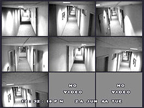
The 24-hour closed-circuit voyeurism we impose upon the voidscape of empty car parks and untraveled motorways all around us is already a response to the directionless sprawl of 21st century space. As such, security cameras are the next phase of an advanced urban sociology, a vanguard attempt at understanding the limits, contents and directions of our cities; these cameras have nothing to do with security – unless, of course, cognitive security is the issue at hand.
But to introduce a new term here, we would find ourselves discussing not *psychogeography* – that outdated fetish of a new crop of uninspired theses, from Princeton to the AA – but *psychovideography*, the videographic psyche of the city. If security firms are the new providers of our urban unconscious, a hundred thousand endless films recording twenty-fours a day, indefinitely, then we should perhaps find that the outdated methodologies of the psychogeographers have hit an impasse. The geo- is now in the video-, as it were, and the -graphy survives just the same. Throw in some 24-hour psycho-, and we begin to see the city through the lens of an unacknowledged avant-garde: a subset of the film industry whose advance front has taken on the guise of security.
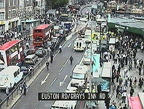
The security industry, in this case, finds itself a (presumably unwitting) heir to John Cage. As Cage himself wrote, 'There is no such thing as an empty space or an empty time. There is always something to see, something to hear.' London's private security firms could hardly agree more passionately – and that surveillant/cinematic enthusiasm now spreads to New York and Chicago.
J.G. Ballard: 'He had spent the past days in a nexus of endless highways, a terrain of billboards, car marts and undisclosed destinations.' Iain Sinclair: 'The landscape is provisional.'
The response: psychovideography. Endless filming. Install the umbrella of a total cinema and move freely into the next phase of urbanism: fortress urbanism. 'Security' is a red herring; we are witnessing instead the triumphal rearing-up of an unconscious cinematic fantasy.
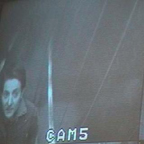
Accordingly, we find ourselves, everyday, living more fully than ever before in the utopia of someone else's inescapable, fortified film set.
The Department of Homeland Cinematics.

[posted by Geoff Manaugh on BLDGBLOG] [via space and culture]
Posted by jo at 10:11 AM | Comments (0)
SPECFLIC 1.0

Sousveillance Grid + Community Built Display
The Community Built Display enables a group of people with wireless laptops to create a modular, flat-panel, dynamically reconfigurable large-format display. For SPECFLIC, The Outsider Jeremiad will serve as a ringleader of a group of audience members who want to send high-impact visual messages to those on the Inside. Developer: Robert Twomey, UCSD MFA Candidate, Visual Arts; Advisor: Natalie Jeremijenko, Visual Arts Dept., Xdesign Studio.
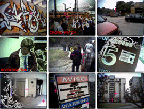
The Sousveillance Grid is a net-based interactive display which processes user-submitted camera phone images and displays them in a grid in a random fashion. Projected to the public SPECFLIC audience, it encourages bystanders to assist in documenting their surroundings with the efficiency and depth that only a populace armed with many, many cameraphones can provide. The display was created with PHP and JavaScript and can be viewed on any web browser. A proliferation of digital recording devices are leading us to a place where privacy will evaporate without any parallel efforts from the State — a community armed with compact, wirelessly-connected recording devices will record and police itself far better than any government could have hoped to. Developer: Andrew Collins, UCSD alum, ICAM’05, Calit2 Undergrad Fellow; Advisor: Adriene Jenik [Related 1, 2]
Posted by jo at 10:01 AM | Comments (0)
PLAN: Mikel Maron
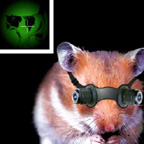
Locative Animals
Mikel Maron’s presentation of his contribution for the Open Plan workshop is very insightful and original. I like his ‘locative animal‘ concept very much:
"My [Mikel Maron] angle in my application to the Workshop was Locative Animals. Nothing much happened on this, but I did get to meet a researcher with similar interests, Shaun Lawson. Here’s the blurb I submitted on Locative Animals.
My interest in Locative Arts has been somewhat on the fringes of the predominantly urban, socially focused arts projects. The natural world is under ever greater stresses, and these technologies, usually employed to buffer nature, can and have been effectively used to raise awareness of the non-human world and give it a voice. The idea of over saturation of technology has been parodied by projects like "Augmented Animals," though in reality new communication modes are being employed by wildlife researchers to track elephants and reindeer by SMS and GPS. I’ve been gathering various resources on spatial technology and spatial understanding in animals under the moniker Locative Animals.
Nature is not separate from urban experience, though most city dwellers would not be that aware of the populations living in their midst. Sensing and tracking of wild fuana and flora in urban environments could raise awareness of wildlife in a tangible, positive way. Bird watchers are particularly active and independent; tools to bridge individual bird monitoring into larger situated databases and patterns could be another interesting application of the technology. Another interesting area is Porton Downs, site of much controversial chemical testing, but due to the lack of intensive human activity, also home to many rare species that have disappeared from the rest of the UK. If access is be attained, artistic investigations of nature on this site would be potentially very insightful.
This concept grows out of my interest in spatial models of ecosystems, and spatial niches. Birds may not be able to navigate human buildings that competently, but they can migrate to precise locations over 1000s of miles, with senses evolved for the purpose. In other words, a map is only one (and sometimes inferior) way to get around. The Nottingham Jubilee Campus was a pretty successful brownfield restoration, melding natural and urban fabric." [blogged by Nicolas on pasta and vinegar]
Posted by jo at 09:24 AM | Comments (0)
October 27, 2005
CTHEORY VOL 28, NO 3
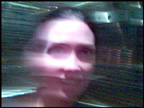
Infomobility and Technics: Some Travel Notes
"...With every step, I emit a smog of data; my journey is being archived too. Every few seconds, my device "pings" the network and receives a response; my location zone is then recorded in a log. I am conscious that I leave a trail of digital breadcrumbs for Maroc Telecom through the ancient city, that my position could be triangulated within metres based on my distance from nearby cell stations. I have become data "travelling through data landscapes" [5]; I have become a roaming subscription number. As my feet slide upon thousand-year old stone, I am at once travelling through networks and central servers back in Australia, my details handed on via invisible network handshakes across the globe, my trajectory recorded. I am not lost, I am identifiable; I am a string of information events..." From Infomobility and Technics: some travel notes, by Belinda Barnet, 1000 DAYS OF THEORY, CTHEORY, VOL 28, NO 3, Editors: Arthur and Marilouise Kroker. Also, Understanding Meta-Media by Lev Manovich.
Posted by jo at 06:05 PM | Comments (0)
Frozen Niki
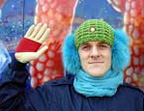
Thoughts on Ice
Nikolaj Osinin is a Russian Cosmonaut who is now a part of Zvezdastella crew. He is in a cryogenic box (he has to remain young and fit until the spaceship Zvezdostella reaches the Magellanic Clouds, to pilot the ship back to Earth) and his brain activity is monitored by the Central Mission Computer. Data is transmitted to the Bajkanur server and fed to Nikolaj’s personal blog. Frozen Niki is a story of this cosmonaut, organized in the form of a blog without text and has to be read from bottom up to follow his fragmentary thoughts and a detective love story.
By Dragan Espenschied (mostly known for being a part of Bodenstandig 2000) and Olia Lialina (author of early web narrations like My Boyfriend Came Back from the War and Agatha Appears). [blogged by Regine on we-make-money-not]
Posted by jo at 02:05 PM | Comments (0)
Tool for Armchair Activists

Shout it Out
Troika, the U.K. design firm that brought us the SMS Guerilla Projector, has unveiled their latest project: Tool for Armchair Activists. Where the projector displayed the text of an SMS message on a distant surface, the Tool for Armchair Activists will shout it out loud. The rig can be strapped to a lamp post and thanks to an embedded mobile phone, can vocalize messages from anywhere.
The Tool for Armchair Activists is currently located in Troika's studio. Give them a shout by texting here: +44(0)7790272804. [blogged by Josh Rubin on Cool Hunting]
Posted by jo at 01:49 PM | Comments (0)
2006 iDMAa + IMS Conference

code: HumanSystems | DigitalBodies
Call for Papers: The International Digital Media and Arts Association and Miami University’s Center for Interactive Media Studies presents the 2006 iDMAa + IMS Conference. The conference’s theme is built around an examination of the many codes that drive the digital media and arts world. The Conference will bring academics, artists, and industry representatives together to help define, refine and advance the leading edge of new media. This is the third annual iDMAa Conference and fifth annual IMS Conference.
The conference will include refereed paper presentations, panels, discussion workshops, gallery talks, and performances. Pre-conference, hands-on tutorials (free for iDMAa members) will begin on Wednesday, April 5th, 2006. The conference will begin on April 6th and end on April 8th. The conference will also include a juried exhibition and a vendor fair. This conference is sponsored and hosted in Oxford, Ohio by Miami University’s Center for Interactive Media Studies.
The Conference seeks submissions of papers for presentation and discussion. All papers will be refereed for acceptance and selected papers will be published in the iDMAa Journal. There will be an on-line proceedings, including all accepted work, as well. Submissions will be accepted in two categories: papers and notes. Papers will follow traditional academic writing standards and should not exceed ten pages. Notes are at most two pages long. Online and interactive supplements can be included.
Please send all submissions by November 23rd, 2005 to:
Prof. Peg Faimon, Program Chair
231 Hiestand Hall
Miami University
Oxford, OH 45056
faimonma[at]muohio.edu
Papers may be submitted for review in Microsoft Word or PDF format. Please follow standard academic paper formatting conventions.
Supplementary materials may be submitted in formats displayable by standard web browsers with freely available plug-ins (e. g. Flash, RealPlayer, Windows Media Player 10 or Quicktime). Authors will be notified of acceptance by January 6, 2006.
Your submission should include a cover letter indicating which conference track is preferred (See list below). Participants are also encouraged to propose panels or complete ‘paper sessions’ on topics of specific interest. Special conference rates are available to individuals who organize and bring complete panels for sessions.
We encourage the submission of panels. Panel submissions should include a brief description of the panel topic and list of panelists. Note that any panel chair submitting a panel with a minimum of four panelists who are full paying registrants to the conference will receive a discounted registration.
Conference Tracks
“We all have the extraordinary coded within us, waiting to be released”
– Jean Houston
The 2006 iDMAa + IMS conference is structured around the taxonomy outlined below. These categories are meant only to be broad groupings as an organizational tool. The suggestions included below each track are just that — suggestions. We encourage broad, creative, and radical interpretations of these tracks.
Track One: Art Code | Code Art: Sample Topics: Algorithmic Art, Software Art, Net Art, Installation Art, Physic Computing, Sonic Art, Interactive Design and Development
Track Two: Academic Code: Sample Topics: Curriculum Development, Promotion & Tenure, Program Development, Pedagogy, Technical Support and Funding, Inter-Institutional Collaboration, Digital Film Schools, Classroom and Lab Exemplars, eTextbooks
Track Three: Image Code: Sample Topics: Digital Photography, Digital Imaging as Art, 3-D Modeling, Digital Printing, Medical Imaging, Commercial Design, Installation, Digital Painting
Track Four: Time-Based Code: Sample Topics: Digital Video, Flash, Processing, Distance Collaboration/Performance, Animation, Film, Interactive
Track Five: Cultural Code: Sample Topics: Network Culture and Complexity/Change, Philosophy, Digital Identity
Track Six: Legal Code: Sample Topics: Copyright, Legal Issues for Artists, P2P File Sharing, Open Source, Creative Commons
Track Seven: Semiotic Code & Storytelling Sample Topics: Digital Narrative, Digital Asset Management, Still Image as Narrative, Semantic Web
Track Eight: Commercial Code: Sample Topics: Mobile Media, Emerging Technologies, Business Applications
Track Nine: Game Code: Sample Topics: Serious games, artistic games, commercial games, games as pedagogy, analysis of games
Posted by jo at 01:42 PM | Comments (0)
UpStage! This Week
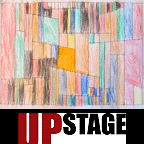
JeanRichard + Open Session
It's a busy week this week in UpStage: on Saturday 29 October we have a live public performance by JeanRichard; and on Wednesday 2 November we have the regular Open Session and walk-through.
LIFE2 performance by JeanRichard: This is the first public performance to be staged in UpStage by a group other than Avatar Body Collision (the creators of UpStage). JeanRichard is a Swiss family of artists who began using UpStage a few months ago, and they love it so much they've already reached the point where they are ready to give their first public performance. [Related]
To join the performance, you don't need to be logged in; just go to http://jeanrichard.ch/Life2/ where there will be a live link to the stage from one hour before the performance time. And the performance time is: 1am California; 4am New York; 9am UK; 10am Switzerland; 11am Finland; 6pm Australia (NSW/Queensland); 9pm New Zealand. See http://www.worldtimeserver.com/ for other local times.
UpStage Open Walk-Through: This session takes place on the first Wednesday of the month and is an opportunity for newcomers to learn about UpStage and for regulars to have an open jam session. To register for the session and request a log-in, email me (helen[at]creative-catalyst.com) - even if you're a regular, please let us know that you're coming.
As usual, we'll begin on the Introduction stage, http://upstage.org.nz:8081/stages/presentation. Depending on numbers, some may go to another stage for improv while newbies learn the basics on the Introduction stage. Those of you who are logging in will do so from http://upstage.org.nz:8081
The times this month are: 1am California; 4am New York; 9am UK; 10am Netherlands; 11am Finland; 7pm Queensland Australia; 8pm NSW Australia; 10pm NZ
See http://www.worldtimeserver.com/ for other local times; please note that European clocks have changed between these two events - if you are in any doubt over the correct time, find your local corresponding time for the Swiss time of 10am for the JeanRichard performance on 29 October, and for the New Zealand time of 10pm for the open session on 2 November.
Posted by jo at 01:33 PM | Comments (0)
Convergence 12.3:

Open Call for Papers
Convergence 12.3: After eleven years as one of the foremost international journals in new media studies, Convergence is undergoing some exciting changes, including a move to Sage publications from 2006. This will significantly extend the distribution and indexing services available to the journal and its authors, and we expect a large increase in readers and citations.
We are currently seeking papers for Winter 2006 (12.3). This is an open call for any research that addresses Convergences in the broad field of new media studies. For this issue, papers would need to be submitted by 31st January 2006.
Papers on in areas including the following are welcome:
Video games
Cable and telecomms
Mobile media/content
Internet studies
Digital/new media art
Digital photography
VR
Control and censorship of the media
Copyright/intellectual property
New media policy
New media industries/institutions
New media history
New media in cross-cultural/international contexts
new media products
Digital TV
DVD
Digital music recording, production, distribution, file formats/
file sharing
Cinema
gender and technology
Submission details: Electronic submissions are preferred via email or on floppy disk (Macintosh Word98 compatible). These should be sent to the editors with the following information attached separately: name, institution and address for correspondence, telephone, fax and email address. Papers should be typed on one side of the sheet with endnotes in accordance with Sage referencing style (see our website). Refereed articles should be between 5000-8000 words, Debates pieces should be between 1000-3000 words and Feature Reports should be approximately 4000 words. Authors should also enclose a 50 word biography and an abstract.
Proposals for articles or completed papers should be sent to:
convergence[at]luton.ac.uk
Jason Wilson
School of Media, Art and Design
University of Luton
Park Square
Luton
Bedfordshire
LU1 3JU
United Kingdom
T +44 (0)1582 489114
F +44 (0)1582 489212
M 07886508141
jason.wilson[at]luton.ac.uk
Posted by jo at 01:11 PM | Comments (0)
A Short History of Virtual Hiking
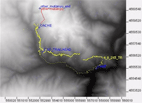
Algorithm as Hiker
A Short History of Virtual Hiking + video by Brett Stalbaum: A virtual hiker is an algorithm that produces computationally derived paths from data in such a way that allows them to be re-followed through the actual world. The virtual hikers that are included in the C5 Landscape Database, beginning with version 2.0, include various Least Cost Path hikers and a Slope Reduction hiker based on a natural selection algorithm.
The first attempt to follow a virtual hiker through a real landscape was performed by C5 on April 9th 2005 near Dunsmuir California as part of the quest to discover the *Other Path* of the Great Wall of China in California, or as it is now known, simply the Great Wall of California. After a rigorous insertion hike and facing both fading daylight and rapid waters flowing through necessary water crossings, C5 was only able reach the beginning of the Great Wall's other path. The visual comparison of the China terrain and its California other were satisfyingly documented, even through it was impossible to actually walk in the footsteps of the virtual hiker. (C5 personnel are Joel Slayton, Steve Durie, Geri Wittig, Jack Toolin, Brett Stalbaum, Bruce Gardner, Amul Goswamy and Matt Mays.)
The second attempts to follow a virtual hiker were performed by Paula Poole and Brett Stalbaum using C5-developed software in the Anza Borrego desert of Southern California. On May 28th 2005, we attempted to follow the stepwise 3 degree Least Cost virtual hiker from Agua Caliente Springs to the Inner Pasture. An earlier scouting mission had revealed that part of the LCP path dead ended in a box canyon, but some probative scouting revealed a saddle over which the canyon could be bypassed. Even though this would cause a small divergence from the course, we proceeded to try the full hike. Unfortunately, the virtual hiker's track also led over a steep talus slope. While the path was not impossible to traverse due of the severity of the slope alone, the combination of loose talus and the many agave plants, cholla and barrel cactus in the area presented painful safety challenges. The idea of following the LCP path to Inner Pasture was abandoned after Brett slipped and fell, spearing his arm on an agave.
Realizing that most paths in the area were probably untenable due to the floristic nature of the Anza Borrego desert and its many sharp plants including the beautiful ocotillo, jumping and teddy bear cholla, it was decided to follow the nominal foot path to the Inner Pasture known as Moonlight Canyon. While both the LCP hiker and Slope Reduction Virtual Hiker utilized parts of Moonlight Canyon, they diverged enough that the claim to have followed the virtual hikers could not be sustained. Interestingly, however the virtual hikers did traverse parts of Moonlight Canyon.
The desert mountain ranges of the Great Basin provide much less in the way of spiny botanical hazards than do the Sonoran desert. A scouting mission including Brett, Paula and Naomi Spellman was performed on June 18 2005 to evaluate the terrain, and During the Locative Media in the Wild Workshop at the White Mountain Research Station Crooked Creek Facility, July 22nd of 2005, Brett, Naomi, Kimberlee Chambers and Nico Tripcevich became the first to actually successfully follow the path of both a Three Degree Least Cost Path hiker and a Slope Reduction hiker. True to form, the LCP path followed a waterway, and the Slope Reduction Path discovered a surprising and unexpectedly easier path than the non-computational path that had originally been scoped out on June 18th. Experiments with virtual hikers are ongoing.
Posted by jo at 12:45 PM | Comments (0)
WebJam 09
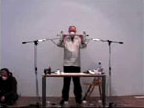
decentred | distributed improvisation
WebJam 09: Saturday 29th October, 8-11pm, Norwich Gallery, UK, FREE ENTRY. Live Webcast Online from 7.30 p.m. (performance starts at 8:00 p.m.). Connect at http://www.n0media.net. Live Sound/ Visual Performances featuring Phil Archer, Andre Bosman, Laura Cannell, Shigeto Wada, Tonesucker, Hermits' Squeal, BabyGrand, Hoofus, Dan Tombs, Tom Simmons, and Liam Wells.
Webcasts require QuickTime Player (version 6+): Download QuickTime Player for free. Directions/Gallery info at http://norwichgallery.co.uk
Posted by jo at 11:17 AM | Comments (0)
UNESCO Tutorial and Seminar

Creating a Simple Electroacoustic Piece in Easy Stages
Steps for a simple electroacoustic creation--A practical seminar with free online access from UNESCO’s DigiArts portal. UNESCO’s DigiArts project currently offers beginners a step-by-step approach to creating a short electroacoustic piece. This musical creation can be accomplished with the help of detailed software tutorials on the DigiArts portal.
Free access: The practical seminar on electroacoustic music, Creating a simple electroacoustic piece in easy stages, compiled by Bruno Bossis.
Minimum equipment required: Only the simplest material possible is required to access the practical seminar. Whatever the available configuration is, an external microcomputer will be preferable to avoid a too poor sound quality and disturbing background noises. An additional soundcard is by no means a necessity. The practical seminar contains numerous references to documentation on the freeware and to the theoretical seminar already available online.
Reference tools available on the DigiArts portal:
1. Application tutorials: Tutorials for the free music and sound applications were chosen for Mac and PC platforms.
2. Theoretical seminar on electroacoustic music (in French): The theoretical seminar looks at electroacoustic music from a historical angle, and explains its diversity and aesthetical evolution.
Credits: The seminar was compiled by Bruno Bossis, professor at the Universities of Renne 2 and Paris IV-Sorbonne, musicologist in the IRCAM (Institute for music/acoustic research and coordination) Hypermedia Analysis Group, and Doctor in Musicology and researcher at MINT (Music, Computer Science and New Technologies) at Paris IV-Sorbonne.
Contact: digiarts[at]unesco.org
Posted by jo at 11:14 AM | Comments (0)
FAQ:
Postcoloniality, Transculture, and Dance Performance in Asia Pacific
[posted by Yukihiko YOSHIDA] FAQ: Postcoloniality, Transculture, and Dance Performance in Asia Pacific has been released. This list is written and managed by contributors. If you add research material, such as URL, name of document, etc., you will be added to
the contributor list.
Contributors: Ya-Ping Chen (TNUA, Taiwan), Yatin Lin (TNUA, Taiwan), Hsin-Chun Tuan (PhD. UCLA, USA), Yukihiko YOSHIDA (PhD. Candidate, Graduate School of Media and Governance, Keio Univ, Japan), Yuji Sone (Vice-Chancellor's Postdoctoral Fellow, School of Media, Film and Theatre, The University of New South Wales, Australia-Japan), Mariana Verdaasdonk (66b/cell, Australia-Japan), Julie Dyson (Ausdance National, Australia), Teresa Pee (researcher/educator, Singapore), and Urmimala Sarkar Munsi (WDA Bengal, India).
Posted by jo at 11:13 AM | Comments (0)
October 25, 2005
The Starbucks Challenge
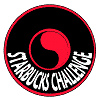
Join the Fair Trade Challenge
Regardless of politics, most of us agree on one thing: If a company makes a promise, it should stick to it. According to its own policy (PDF), Starbucks will make fair trade coffee for you, any day of the week, in the 23 countries it is licensed to including: Australia, Austria, Canada, China, Germany, Hong Kong, Japan, Korea, Malaysia, New Zealand, the Philippines, Spain, Switzerland, Taiwan, Thailand, the U.K. and the U.S.
But just how easy is it to get a fair trade coffee in a Starbucks in one of those countries? We aim to find out. Join the challenge: 1) Simply visit your local Starbucks and ask: "Could I get a cup of fair trade coffee?" 2) Tell us what happened next. Was it hard or easy to get a cup? You can see our first posts here. BLOGGERS: simply blog about what happened and tag it with "starbuckschallenge" (all one word) on del.icio.us (put the Starbucks location in the "extended" description). We'll pull all articles into a feed and run that on our site - you can run the feed too, of course, if you'd like. ALSO help us get feedback by telling people about this challenge on your blogs. Read more about The Starbucks Challenge.
Posted by jo at 01:19 PM | Comments (0)
Ifbyphone
![]()
Speak
What happens when you merge computer gaming with great fiction? Interactive Fiction - which lets you play a book or read a game! Also known as Text Adventures, the story narratives are the basis for commanding the characters, progressing through the storylines and reaching a hidden goal, i.e. Winning the game. Now take this well-established game concept, and elevate it into speech! With ifbyphone you speak the game commands and the game talks back...All from any telephone.
Ifbyphone, LLC is a new media company focused on the distribution of recorded and text based information and family friendly entertainment via voice. The customizable features of the ifbyphone voice-based service are available directly to individual consumers and to corporations. This first release of ifbyphone provides web-like access from your telephone without needing to touch the keypad or straining to read a tiny screen. By integrating the sophisticated voice recognition and state of the art text to speech technologies, ifbyphone empowers your cell phone, home phone, or business phone to be a superior voice communications device. [via] [Related]
Posted by jo at 12:33 PM | Comments (0)
PlayAnywhere
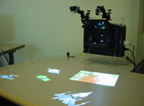
Portable Augmented Reality
Computer monitors are by no means an endangered species, but it is becoming increasingly apparent that they will soon be replaced for many uses by floors, walls and table tops. The latest evidence: a Microsoft Research scientist has developed a projector and computer vision system dubbed PlayAnywhere that projects interactive computer-generated images without the need for specially mounted cameras.
Researchers have been reducing the cost and complexity of the augmented reality systems in recent years. (See PCs augment reality, TRN June 26/July 3, 2002). The PlayAnywhere system goes further by packaging the components into a single portable unit that doesn't require calibration. The system consists of an NEC tabletop projector, an infrared light source, an infrared camera and a computer. The device projects a 40-inch diagonal image onto the surface it stands on.
Computer vision techniques allow users to use their hands to move, rotate and scale projected virtual objects. The system tracks shadows to determine where fingertips touch the surface; frame-to-frame pixel-level changes determine hand motion. The system also keeps track of sheets of paper in its view and can project images onto them.
The projector system could be used for games, educational software and other interactive graphical computer applications.
(PlayAnywhere: A Compact Interactive Tabletop Projection-Vision System, Symposium on User Interface Software and Technology (UIST 2005), Seattle, October 23-26, 2005) [posted on Technology Research News Roundup]
Posted by jo at 12:12 PM | Comments (0)
Two Thousand + SIX
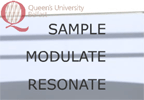
Conference on Performance in Mediated Environments
Two Thousand + SIX: A new international conference focusing on performance in technology mediated environments will kick off as part of the 2006 Sonorities Festival of Contemporary Music (see related post), hosted at the Sonic Arts Research Center, Queen’s University Belfast. The festival is the longest-running new music festival in Ireland that presents cutting-edge new music and features some of the most thought-provoking and controversial musicians.
The "mini-conference" aims to reflect the innovative approach of the festival and will, for the first time, bring together performance practitioners (from music, dance, theatre and new media), composers, and theorists in order to discuss a wide variety of topics on performances that are informed by new technologies.
The "mini-conference" is planned for Saturday, the 29th of April 2006 at SARC in Belfast. Paper sessions will take place in the morning and the afternoon, with two keynote speakers, a lunchtime performance and an evening concert.
Keynote Speakers:
Susan Broadhurst: Sue is a writer and practitioner in the creative arts. She is currently Subject Leader of Drama Studies at Brunel University. She is the author of " Liminal Acts: A Critical Overview of Contemporary Performance and Theory" (1999); "Digital Practices: A Critical Overview and Neuroesthetic Approach to Performance and Technology (forthcoming, 2005), and "Performance and Technology: Practices of Virtual Embodiment and Interactivity (forthcoming, 2006). Sue is also co-editor of the Body, Space & Technology online journal.
Ben Watson: Wire contributor, Trotskyist and Zappaphile, Watson has written extensively on themes such as pop culture, situationism, punk, Adorno, Frank Zappa and improvisation. He is the author of "The Negative Dialectics of Poodle Play", “Derek Bailey and the Story of Improvisation”, and “Art, Class and Cleavage”.
Call for papers/presentations:
For this one-day conference we invite proposals for papers that reflect on performance and technology. As this is a short event, a maximum of 16 papers of 20 minutes duration (plus question time) will be accepted. Abstracts (max. 350 words) are due by the 15th of December 2005. Presenters of accepted papers/presentations will be informed by the 15th of January 2006. The registration for the one-day event will be £40 (£15 unwaged). This includes free access to all Sonorities Festival events on the 29th April 2006.
All accepted papers will be published online.
Further information on the conference will be posted in December 2005 on the SARC website.
Submissions and all queries should be directed to:
f r a n z i s k a s c h r o e d e r
franzisk[at]lautnet[dot]net
Posted by jo at 11:40 AM | Comments (0)
Morgan Schwartz
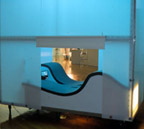
Chance Encounters, Deliberate Interventions
Pursuit of Happiness: Porta-Sky is an urban sanctuary and think tank for two. Periodic trips into the dark relaxation chambers of movie theaters became a routine survival technique for the subjects of modern society. In our post-modern world, where work and leisure have collapsed, the Internet has become a space of convergence. "Porta-Sky" is a physical corollary – a non-space, a hallway from here to there. Providing a personal view of a virtual sky, this video projection space offers alternate imagery to an anxiety-ridden sky. The unit features dual, synchronized DVD video projections, a deployable surveillance blimp and custom designed form-fitting reclining seats.

Situated in the Gallery@Green St (adjacent to the Green St. Subway station on the Orange Line in Boston, MA), Pressure was a site specific installation where computer controlled sensors manipulated the sights and sounds of daily commuting to address issues of accelerated culture and the evolving metaphors for speed and progress. Pressure seeked to explore the psychology and physicality of individuals in the contemporary urban landscape.
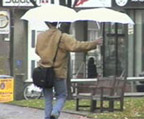
umbrellaSpace is an urban gesture. It is a design solution to a social problem. The intervention adjusts perceptions of boundaries and comfort held by observers on the street. This umbrellaSpace adopts the umbrella as a familiar, recognizable, urban form and recreates it. A permeable space of interaction is transformed from a private, individualized space. An individual in the urban sphere operates this new umbrellaSpace. He or she can choose to invite people on the street into this space. I’m interested in exploring the range of responses this intervention precipitates on the street: sociological, visual, performative. Schwartz is looking for people interested in operating the UmbrellaSpace as well as videographers and photographers interested in documenting the events.
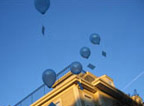
Currently in development at the Berwick Research Institute and on exhibit at Glowlab: Open Lab, Whether/Weather consists of aerial beacons that are dispersed into the weather system. The beacons are helium powered with LED blinkers. Like seeds, these beacons drift with the wind and carry information/stories/memories that hopefully germinate wherever they land. Whether used by an individual or a large organization, the project explores the idea of memory and memorialization through ephemeral and participatory public art. The person who happens upon one of the beacons that has landed, will encounter a message and the option of logging into a website to find out more about where/why the beacon originated. They can contribute their own response at this point and even decide to re-launch the beacon. By logging when/where the beacons are launched and when/where they are found Schwartz is visualizating whether/weather patterns. He hopes that the project will function like a collective 'message in a bottle' and tap into romantic and poetic possibilities of communication and chance discovery.
Posted by jo at 10:02 AM | Comments (0)
October 24, 2005
Fugue
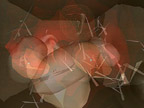
Calibrate an Artificial Immune System
Fugue is the result of a collaboration between artists, new music composer and computer scientists. The result is an on-going project which provides a new way of communicating complex scientific ideas to any audience. Immersive virtual reality and sound provide an interactive audiovisual interface to the dynamics of a complex system – for this work, an artificial immune system. Alongside with providing the greatest immersive effect currently available, this technology offers the potential to control and calibrate particular audio-visual elements.
The aesthetics of the Fugue is emergent, based upon the essential, fundamental and hidden beauty of the organic processes manifested through the dynamics of the real-time generated, unpredictable algorithm. The piece is set up as an interaction between a virtual (artificial) immune system and a human participant. Participants are able to see and interact with immune cells flowing through a lymphatic vessel and understand how the complex dynamics of the whole are produced by local interactions of viruses, B cells, antibodies, dendritic cells and clotting platelets.
The sound, envisaged as a ‘mental soundscape', a resonance of the function of immune system in the body, provides a major channel for interaction. By overlaying and modulating the sonic pulsation, cycles - such as circadian rhythms, or other inputs such as stress level, will be introduced in the future. The Artificial Immune System will ‘inhabit' the virtual space of the master server computer at the CS UCL that will run the Artificial Immune System continually, providing the possibility of being displayed on different interfaces. [via]
Posted by jo at 04:03 PM | Comments (0)
Balance and Power:
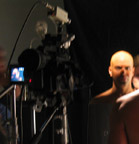
Performance and Surveillance in Video Art
Balance and Power: Performance and Surveillance in Video Art: At a time when the nation is preoccupied with heightened security and surveillance, and the public is fascinated by Reality TV with its open and surreptitious video exposure of participants, the boundaries between performance, voluntary acting for the camera, and surveillance, involuntary recording on camera by power systems with an interest in the movement of citizens, become blurred. Since the earliest days of video art in the mid-1960s, artists have negotiated the question of when surveillance becomes performance (and vice versa) and these concepts continue to be central to many video artists working today. This exhibition, which examines both the early days of video art and current practices, is an attempt to understand the complex relationship between the issues of performance, surveillance, and power.
Included in the exhibition are works by some of the earliest practitioners, large-scale installations, newly commissioned pieces, and the premiere of Jordan Crandall's new film, Homefront. Balance and Power will be installed in two locations: in public areas at the Thomas M. Siebel Center for Computer Science and at Krannert Art Museum. The Siebel Center regularly features contemporary art installations employing state-of-the-art equipment integrated into the building. Installations at the Siebel Center periodically may be unavailable. Guest curator: Michael Rush.
"...In the earliest days of video art in the mid-1960s, artists engaged the question of when surveillance becomes performance and vice versa. This issue remains central to the work of many video artists today, said Rush, a writer, curator, critic and former director of the Palm Beach Institute of Contemporary Art in Lake Worth, Fla.
The exhibition references and features work by a diverse group of artists, from early video pioneers such as Andy Warhol, Vito Acconci and Bruce Naumann to emerging practitioners such as Jill Magid and U. of I. art and design professor Kevin Hamilton.
Other participating artists are Antenna, Sophie Calle, Jim Campbell, Peter Campus, Jordan Crandall, Shelley Eshkar, Harun Farocki, Subodh Gupta, Tiffany Holmes, Tim Hyde, Paul Kaiser, Kristin Lucas, Steve Mann, Jenny Marketou, Jonas Mekas, Muntadas and Marshall Reese, Martha Rosler, Julia Scher, Kiki Seror and Gregory Shephard..." More >>
Posted by jo at 03:35 PM | Comments (0)
Pieces for Plants
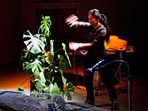
Laptop and Philodendron Performance
Miya Masaoka has worked with Madagascan cockroaches, the electrical signals from the bodies of ten naked Asian men, and the sounds of swarming bees. In Pieces for Plants, a plant’s real-time responses to its physical environment are translated to sound. Highly sensitive electrodes are attached to the leaves of a philodendron. People move their hands around the leaves and hear the plant speak back to them: the voice seemingly the plant’s physiological response to interactions. During the piece, the plant is brought to a range of physical/psychological states, from calm to agitation.
Pieces for Plants suggests that plants have an awareness, are part of our living network of beings, and can communicate with us if we learn how. Versions of the piece have also been presented in a musical setting in which the plant participates as a member and soloist within an instrumental ensemble. For Blur of the Otherworldly, the artist has set the piece free for visitors to navigate other participants’ compositional conversation with the plant and listen to their dialogues. [blogged by Regine on we-make-money-not]
Posted by jo at 11:33 AM | Comments (0)
LOST

Who's running the show?
"Somewhere around the time he glimpsed the shark with the tattoo, a rabid ''Lost" fan named Elan Lee knew there was something different going on: This was a TV show that liked its audience...As director and lead designer at 42 Entertainment...Lee is a pioneer of an interactive form of storytelling, which depends on the Internet and on the audience taking part. It's known as the ''alternate reality game," or ARG, and it's the medium that, for its most devoted fans, ''Lost" has come to most closely resemble...
What Lee and his co-workers devised was less a pitch than an immersive experience -- an exercise in buzz creation, in the form of an Internet-based game. They never mentioned the film itself, but they created a story, loosely connected to the world of the film, and left it for the audience to uncover. It was a hybrid of the serial novel and the Darwin-era scientific process, says science fiction novelist Sean Stewart, who served as head writer for the project. (He's serious.) The programmers spent six months constructing a narrative, breaking it into a million fragments, and hiding it on nearly 1,000 web pages laced with clues, along with certain spots in the physical world..." From Who's running the show? by Joanna Weiss, Boston Globe, October 23, 2005.
Posted by jo at 10:31 AM | Comments (0)
Point, Line, Surface
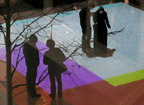
Digital Boogie Woogie
LAb[au]'s Point, Line, Surface computed in seconds will be presented in form of an outdoor urban and interactive installation in the center of Brussels. The installation is presented in the context of Cimatics 05 festival and Maiis # 3 _ ''ville en creation/creatie in de Stad" festival. From October 25 to November 5, 2005, everyday 17:00 - 24:00; opening reception: October 25, 17:00h.
Point, Line, Surface is an interactive installation by LAb[au] which immerses the user in an audiovisual space. The user creates on a touchscreen a sonic and visual composition spatialised through quadraphonic sound and (a 10x10m) floor projection which can be animated through finger-movement. Referencing Mondrian's Boogie Woogie which draws a relation between the rhythmic structure of a jazz-piece, the composition of graphic elements on canvas and the urban grid of New York, the project Point Line Surface extends these relationships to an interactive vocabulary inside the urban and electronic space.
Posted by jo at 10:00 AM | Comments (0)
October 23, 2005
ARCO/BEEP Electronic Art Awards

Electronic Art Award Made In Spain
BEEP/Data Logic aims to create an electronic art collection, through awarding Acquisition Prizes. Therefore, it is organising the ARCO/BEEP Electronic Art Awards.
The goal of these Awards is to advance the production and exhibition of electronic art, and art linked to new technologies. Its purpose is to promote new high-tech art, and to foster communication between the manufacturers/creators of this new technology and those who create art. A natural collaboration, which will benefit and enrich both sides.
There are two ACQUISITION PRIZES:
1) @ARCO Prize: worth 8,000 euros
2) Off-ARCO Prize: worth 6,000 euros
The Prizes will be awarded by an international Jury of prestigious specialists.
1. ARCO/BEEP Acquisition Prizes
Description
1) @ARCO Prize
To be eligible, an artwork must be shown at the 25th edition of ARCO, the International Contemporary Art Fair, in Madrid (9-13 February 2006), and must have a significant component involving new technology or electronic media.
Before ARCO’06, these eligible artworks must also be previously submitted for consideration by their galleries, through registration on a webpage that shall be created to this effect.
2) Off-ARCO Prize
Artworks presented by individual artists, or collectives.
The Prize-winning artworks shall become part of the BEEP/Data Logic corporate collection.
The @ARCO Prize shall be endowed with 8,000 euros, and the Off-ARCO Prize with 6,000 euros—a total of 14,000 euros for the acquisition of the two artworks.
- The Prizes shall be awarded according to the Jury’s decision.
- The Jury shall determine the winner in each of the two categories.
- Registration opens: 5 p.m. Madrid time (GMT+1 hour), 28th October 2005.
- Registration deadline: 5 p.m. Madrid time (GMT+1 hour), 16th January 2006.
- Prize money: 14,000 euros for the acquisition of the two artworks.
- Announcement of winning artworks: 11th February 2006.
Should any of the money earmarked for acquisition remain unspent, the Jury may decide whether to devote this amount to a future edition of the Awards or to acquiring a third artwork selected from amongst nominees for the present edition; in this case, the artwork would be considered to have been awarded an Honourable Mention.
2. Participation Rules
• Any artwork may participate—as long as it is presented by a gallery exhibiting at ARCO’06 (@ARCO Prize) or by individual artists, or collectives (Off-ARCO Prize)—that involves significant use of new technology, or electronic media.
• The artworks must have been previously registered on the webpage that shall be created to this effect.
• The eligible artworks must be exhibited with a price tag.
• Acceptance of artworks shall be the responsibility of the Jury, whose decision shall be final.
• Acceptance of a Prize involves ceding ownership of the prize-winning artwork to the company BEEP/Data Logic.
• The Jury’s decision shall be final.
3. Registration
3.1. Registration Dates
The 2006 awards shall first be announced in May 2005.
Registration opens: 5 p.m. Madrid time (GMT+1 hour), 28th October 2005.
Registration deadline: 5 p.m. Madrid time (GMT+1 hour), 16th January 2006.
3.2. Registration Form
- Registrations shall only be accepted through the Form to be made available on the ARCO/BEEP Electronic Art Prize website, http://www.arco.beep.es
- The registration deadline shall be 5 p.m. Madrid time (GMT+1 hour), 16th January 2006.
The Registration Form must include the following information:
- Artwork title
- Information on the gallery and the artist or collective
- Brief description of the artwork (max. 50 words)
- Sales price, including taxes
- URL where further information is available
- No registrations shall be accepted via e-mail, surface mail, or other means
- Registrations shall be in Spanish or English. No artwork failing to meet this requisite shall be considered for the awards. We recommend submitting bilingual Spanish/English versions, and participants should double-check the translation
3.3. Expanded Proposals
- Participants may expand the information included on their Registration Forms by putting it on their own website, providing the URL on their Registration Forms. Recommendations for Internet presentation of this expanded information are as follows:
- Project Description (max. 500 words), explaining the central concepts and technological resources used.
- Images of the artwork.
- Résumé of the artist. In the case of collectives, a group résumé may be included, or individual résumés for each member.
- In preparing these webpages, please bear in mind that the Jury’s time is limited. Therefore, maximum clarity and concision in web design are strongly advised.
- Those contestants who put up a website for their project shall be responsible for its design and hosting costs.
4. Jury
- All candidacies shall be examined by an international Jury, including:
1. Fernando Castro Flórez, Professor and Art Critic, Madrid (Spain)
2. Karin Ohlenschläger, Artistic Director, MediaLabMadrid (Spain)
3. Christiane Paul, Associate Curator for New Media Art, Whitney Museum of American Art, New York (USA)
4. Arnau Puig, Philosopher and Art Critic, Barcelona (Spain)
5. Jemima Rellie, Head of New Programmes, Tate, London (UK)
6. Yukiko Shikata, Independent Curator and Critic, Tokyo (Japan)
7. Mark Tribe, Assistant Professor of Modern Culture and Media, Brown University, Providence (USA)
- The Jury’s Honorary Chairwoman shall be Marie-France Veyrat, representing BEEP/Data Logic.
- The Jury’s Secretary shall be Vicente Matallana, Director of LaAgencia, Madrid.
- The Jury shall meet during ARCO‘06.
- The Jury’s decision shall be final.
5. Decision
- The Prize-winners shall be announced at the ARCO International Contemporary Art Fair, on Saturday 11th February 2006.
- The Jury shall meet on 10th February 2006 at the ARCO-IFEMA offices.
- The winners shall be announced at 1 p.m. on 11th February 2006 at the central space of theblackbox@arco section.
6. Winners
• Winners shall be contacted by the Awards organisers before they are announced.
• Acceptance of a Prize involves ceding ownership of the Prize-winning artwork to the company BEEP/Data Logic.
• The company BEEP/Data Logic shall pay the Prize money within 30 days after the Jury’s decision is announced.
• The Prize shall be given to the winner, or to his or her appointed legal representative.
7. Information and Questions
For any additional information, or to ask any questions about the ARCO/BEEP Electronic Art Awards, contact:
Jury’s Secretariat
Vicente Matallana / LaAgencia
Tel: (34) 91 366 8821
E-mail: premiobeep[at]laagencia.org
BEEP/Data Logic
Carmen Alcubilla
Tel: (34) 977 30 9100
E-mail: c-alcubilla[at]datalogic.com
ARCO
Ana Botella Diez del Corral
Tel: (34) 91 722 5350
E-mail: arcobeep[at]ifema.es
Registration for the ARCO/BEEP Electronic Art Awards implies acceptance of the present rules.
Posted by luis at 07:01 AM | Comments (0)
October 22, 2005
Curated by
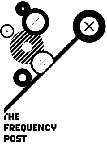
Frequency Post
Frequency Post is comprised of six generative sound works, each an investigation of radio frequency allocation as defined by the broadcasting legislations, technologies and economic pressures brought to bear on each of countries and/or regions individually commissioned sound artist/composers choose to draw inspiration from.
Frequency Post is a curated series of broadcasts, each 35 minutes in length, with the first piece to be performed live-to-air in Vienna by Andrew Garton, the projects curator, on the 23rd of October 2005. The notion that the spectrum is much like "the nervous system in a living organism" is at the heart of the generative processes each of the artists are to employ in the design and construction of their works. Commissioned artists include the well respected, long-time composer, Warren Burt, the infamous and inspiration for much of Australia's electronica genres, Ollie Olsen, award winning sound artist and performer, Steve Law, emergent sound and recording artists, Lie, Pei-Wen from Taiwan and Jin Shan, mainland China. Commissioned by KunstRadio (Vienna, Austria) for Curated by, an on air and online exhibition of international radio-art.
Posted by jo at 05:40 PM | Comments (0)
October 21, 2005
Web 2.0
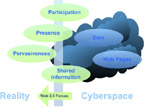
Will Web 2.0 Kill Cyberspace?
"...One of the key aspects of Web 2.0 is that it connects people so they can effortlessly participate in fluid conversations and dynamic information sharing. At the same time, computing devices are giving people permapresence on the Web through PDAs, phones, digital cameras, and a slew of other emerging devices.
Before now, you had to consciously go to cyberspace by sitting at a PC and looking at it through a window, in essence going to a place where you primarily observed and gathered knowledge. Not any more.
These days the boundaries between reality and cyberspace are becoming increasingly blurred and the activities on the Web are becoming more two way and integrated with reality, with the canonical example being the hypothetical Taxi button on a cellphone. With going into cyberspace no longer being a discrete step (folks are more and more always there now) and with the primary activity often being to interact with other folks transparently, and you have a folding of cyberspace so severe that it just disappears into the ether..." From Will Web 2.0 Kill Cyberspace? by Dion Hinchcliffe. [Related 1 + 2]
Posted by jo at 03:36 PM | Comments (0)
Mzantsi:
![]()
(Re)Locating Contemporary African Art Practice
Registration is now open for SESSIONS eKAPA 2005, an international art meeting held at the Cape Town International Convention Centre, Cape Town, on 4-6 December 2005, and with the theme of Mzantsi: (Re) Locating Contemporary African Art Practice.
SESSIONS eKAPA 2005 features an intensive 3 day programme of dialogues and workshops, panel discussion and site specific minilaboratories devoted to contemporary art practice in Africa, exploring specifically the interface between local art practices and global art circuits.
Speakers range from leading art theorists, writers and curators to cultural provocateurs from diverse disciplines and African forums. Discussions explore new models of large scale curation and alternatives to the international exhibition, transgressions of the boundaries of contemporary art and activism, and cutting edge African forums for multidisciplinarity and networking.
Seats for SESSIONS eKAPA 2005 are limited. Details. Program. To register, contact the conference secretariat, Kashief Gamieldien, at kashief[at]tribalco.co.za or +27 (0) 21 697 0180. Early registration is discounted, but closes on 28 October.
Posted by jo at 10:21 AM | Comments (0)
Art Interactive and Non-Event Present:
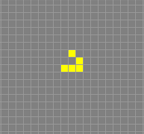
The Cacophony of Life
MUSICIANS AND NON-MUSICIANS WANTED! The Cacophony of Life--by David Mandl--will be a live performance during the Glowlab: Open Lab exhibition. "Cacophony" is a musical performance based on the early computer game The Game of Life, a simple example of a living colony, with cells being "born" or "dying" based on the pattern of cells surrounding them. In this performance, musicians (or non-musicians) either play their instruments or rest based on the same rules, creating a semi-random sound performance. (This is much easier than it sounds. See below for details of how it works.)
Musicians and non-musicians are invited to participate in this performance. Please consider coming down and being a part of it, and please help spread the word to others. RSVP not necessary, but greatly appreciated: Email Dave Mandl at davem[at]@wfmu.org. An audio recording of the performance will be made for airing later in the exhibition.
HOW IT WORKS:
The performers will be arranged in a grid (5x5, 6x6, etc., depending on how many there are). We will start with a random pattern of people playing their instruments, until the conductor signals everyone to move to the next cycle (after about ten seconds). When a new cycle starts, each musician decides whether to play or not based on how many people around him/her are playing. If more than three people adjacent to you are playing during one cycle, you rest when the next cycle starts. If two people adjacent to you are playing during one cycle, you play when the next cycle starts. This will create a shifting pattern of instruments. Each cycle will last about ten seconds. A whole piece of music will last a minute or two, and then we'll start a new piece with a new starting pattern.
For some visual examples of how the original Game of Life works, see this site: (Where a cell is "on" in the game, picture a musician playing a note.)
WHAT KIND OF INSTRUMENT TO BRING:
Just about any noisemaker is welcome: saxophone, kazoo, pots and pans, violin, electric guitar (with portable amp), small drum, hand bells, harmonica. Avoid instruments that are very quiet, because they may be drowned out. Your voice is an acceptable instrument.
"The Cacophony of Life" is produced and conducted by Dave Mandl; Saturday, October 22nd, 2005. 4:00-6:00 PM. Free. Art Interactive, 130 Bishop Allen Drive, Central Square, Cambridge, MA, 617-498-0100.
Posted by jo at 09:32 AM | Comments (0)
October 20, 2005
You Say Potatoe, I say Potato
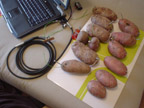
Sonic properties of GM potatoes
You Say Potatoe, I say Potato. In this study of the sonic properties of Genetically Modified potatoes, two research groups try to answer this crucial question: GM potatoes, they may be good for our stomachs, but are they good for our ears? Competing performers decked out in lab coats and safety gear, utilize their respective choice (GM or Organic potatoes) and a set of scientific and culinary tools to explore the sonic properties of potatoes.
The potatoes are used as a power source for the performance by supplying conventional potato battery power. Using zinc (galvanized nails) and copper (thick wire), each potato generates .5 to 1 volt. The individual potatoes can be linked together in serial or parallel to increase voltage and/or amperage. The potato batteries power circuits that generate square waves with varying frequency and intensity depending on the voltage and amperage drawn from the potatoes, which is controlled by the performers by manipulating the battery configuration on the fly. Piezo contact mics are used to process physical interaction with potatoes (i.e. slicing potatoes, grinding potatoes, peeling potatoes, boiling and frying potatoes, etc.) No hint about the the outcome of the experiment. By Sue Huang, Alex Berman and David McCallum. More potato art: Potatoes singing for Denmark. Related: Gameboys powered by lemons. [blogged Regine on we-make-money-not]
Posted by jo at 06:50 PM | Comments (0)
My Mother Was a Computer
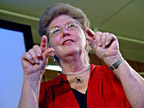
Digital Subjects and Literary Texts
"Mathematician Stephan Wolfram has recently proposed that many different kinds of complex systems, including human thought and action, can be modeled using cellular automata. These very simple computational systems have demonstrated that they are capable of generating complex patterns using simple rules. According to physicist Ed Fredkin, cellular automata underlie physical reality on a subatomic level; in his view, nature itself is software running on a Universal Computer. This presentation will look critically at these claims, asking whether we should consider them as physical models or as over-determined metaphors that would inevitably emerge in a historical period when computation is pervasive. This issue, and its proliferating implications, will be explored through Greg Egan's print novel Permutation City, which imagines a world in which it is possible to simulate a person's consciousness inside a computer, creating a Copy that has all the personality and memories of the original." My Mother Was a Computer: Digital Subjects and Literary Texts [RealAudio] by Katherine Hayles, University of California at Los Angeles. Presented at HUMlab, Sweden.
Posted by jo at 05:46 PM | Comments (0)
Franck Ancel

From Scenography to Planetary Network
From Scenography to Planetary Network [SPN]: an entity of creations, publications, conferences, installations and performances presented by Franck Ancel, in question over contemporary time: the last creation of 2005, in real time via wireless web, via satellite, at an altitude of 30000 feet, more than 900 kilometers per hour, to Tokyo or Shanghai, in the year celebrating France in China and the exhibition of Aichi in Japan.
In the continuation of his triptych AIT in France "Architecture - Image - Technology", these communications prepare for further rendez-vous. Ancel now inhabits the planetary space of technology to fall into and under the reality of the imaginary; a World Fair or a World Tour... like the Solarimpulse plane or like the city of Shanghai between the now and 2010.
Running the planet!: Europa - Amsterdam 09.24.05; America - Banff 09.30.05; Africa - coming soon; Oceania - Sydney 12.02.05; Asia - to Tokyo or Shanghai - End of 2005.
Scenography to Planetary Network for Urban Screens
"If the modern extension of cities is being transformed into urban territory due to the impetus of science-technology, then the classic places of artistic performance remain essentially victims of these changes without really being able to incorporate them.
These new technologies are responsible for the emergence of a “City of Bits”. This “City of Bits” that was analysed as “Space, Place, and the Infobahn” only ten years ago by the researcher William J. Mitchell of MIT in his work of the same name. This was the period of the democratisation of the internet, followed by the appearance of VRML, a time in which some believed that this cyberspace was another world, a new continent, or even, for others, a utopia. Its rise was signalled by the use of a global language, the invention of HTML by a scientist from CERN in Switzerland, which allowed us to move from one computer screen to another without any knowledge of the Internet code.
Thus our project “Being = Network” makes its mark in a city by symbolically confronting the arrival of what the internet scholar Howard Rheingold calls the “smart mobs”. I will rapidly summarize this, like the arrival of the third-generation telephone in Europe. It is this journey between the present and the virtual that I am referring to here all too briefly, that determines the time and reasons for my project, at first glance a simple confrontation of art with architecture, at the moment of the emergence of digital screens in the city.
This “Being = Network” action is not an anticipatory step, but rather a phenomenon which closes without being an end in itself the installation of our AIT triptych in France during the past three years, focusing on Architecture, Image, and Technology. A multiple creation which is not linked to the types of city projection of a Rafael Lozano-Hemmer, a Krzysztof Wodiczko, or a Dan Graham.
Without being a designer, artist, or computer scientist, I do not wish to give a too highly specialized talk, in this city of Amsterdam, birthplace of Constant, founder of the Situationist Movement. However, I am convinced that the visual arts now come from places intended to show them in order to deal with life, and vice versa. This is what propels our search outside of art, architecture, and visual arts. The closest concept is a display to be found at the Scenography to Planetary Network.
Let us call to mind the definition of modern scenography given by its founder Jacques Polieri: “all the pictorial, plastic, technical, and theoretical elements that allow the creation of an image, of a bi- or tri-dimensional set piece, or the installation of an action that is spectacular.” Let us now present the context of this “Being = Network” project that is so decisive in our process. This project of the projection on a screen took place in the centre of Paris in a square, which is situated in a locality that has many cinemas, as well as a stream of people via the metro or the train punctuating the streets.
At the middle, the Montparnasse Tower, a hundred metres from the Gare Montparnasse, at the heart of the city, signals its luminous presence in Paris by night and day. Built at the beginning of the 1970s by the architect Roger Saubot, it imposes by its height of more than 200 metres. There are over fifty floors of offices, each of more than 2000 square metres, with a panoramic restaurant for tourists. This is a Montparnasse that has nothing more in common with the international artistic bohemian life of the 1930s, with its artists’ studios and bars.
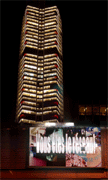
(1) Van Wagner, a world-leading communications company recently installed in France, was one of the first businesses to use large advertising spaces, with still projection, in New York during the 1970s. It now owns the screen at the bottom of the Montparnasse Tower, the only one of its kind in France. But it also has the other two screens in the world, one in London and the other in Los Angeles. This LED screen has a surface area of 38 square metres. Obviously, its location in the French capital, at the crossroads of many different types of networks, is what motivated us to spend more than six months negotiating a partnership with the Van Wagner company, with the aim of completing the project free of charge with their technical support.
Several contacts were naturally made with other businesses linked to the networks, such as RATP, the company that manages the Parisian metro system. This was in the hope of using live images from their CCTV cameras for our screen display. Also, with mobile phone companies, because I propose the appearance of cyber-traceability of mobile telephone chips thanks to software monitoring all movement within the city through cartographic superimposition.
This leads to the possibility for everyone to send live photographic and video captures from a mobile phone using MMS onto each window of the screen display. But none of this contact with these companies led to any results, either positive or negative, though the dialogue remains open for other projects. For the moment, I am not directly dealing with questions about the danger of the mobile phone waves for humans, nor about civil liberties’ with regard to CCTV.
Finally Van Wagner did not allow us to use the screen in real time. We did not therefore have access to the MP4 server broadcasting to the screen and potentially via the network to the two other screens, as I would have liked, to produce a live triptych between Paris-London-Los Angeles. In the end, the entire financing of the project came from a private source, as cultural institutions did not help this scheme.
Unlike the first two parts of the triptych, we were not consequently able to use the software in real time; we use MAX/MSP and JITTER. I came up with a global slogan which would be relevant for this specific context. A proposition of a highly prized poetic “hot spot” within the city which only contained the three words “Mobile Wireless Digital” invoked more than interactivity. The monumental projection at the bottom of the tower lasted for thirty seconds, inserted between other advertising clips, several times a minute for several weeks, until the end of December of last year.
Some video captures were selected from the first triptych projects, three for the Convent project built by Le Courbusier and Xenakis, and three from the Franco-Spanish border. These form windows whose size also has meaning. Each window of these short videos is similar to the typical holiday video captured by a mobile phone. The projection is thus made up of a video-wall corresponding to the windows of the front face of the tower. The video clips are thirty seconds in length, corresponding to the length of the advertising clips; but this is also the maximum time for sending this same video via a mobile phone file format, such as the 3GP, via MMS from one phone to another phone.
Here, whether it is appearing on my own mobile phone as a small image, or on the tower as a large one, there is a fictional connection. Without an audience, since no sign, other than newspapers and radio reporting this action, tells us that we are in front of a work and not of prospective products and/or services. If we were in Asia, the formats would be different but our comments would stay the same.
There are different technical supports depending on the continents. The history of media arts has a more universal history, founded on a re-reading and not only a French philosophical reading, with Deleuze, Virilio, or Baudrillard about the arrival of technology. Moreover, I will speak about these issues next week in Canada in a paper entitled “from Scenography to Planetary Network for refresh 01”, which is also the name of the gathering.
There is also a historical filiation for “Being = Network” with a scenography by Jacques Polieri. From the end of the Second World War, Polieri carried out research on historical avant-garde moments in the visual arts, namely those of exactly eighty years ago this year: the Bauhaus with Schlemmer, Gropius, Moholy-Nagy, Molnar, Weininger, the Paris international exhibition with Kiesler and Prampolini, etc. Polieri never stopped from going into and then beyond projects that were too limited by available resources.
Let us think, for example, of his synopsis using exterior screens at the 1972 Munich Olympic Games. Polieri tries to interconnect between them on a micro-scale: “Electronic images were installed from one end to the other of a “Leisure Street”, in the form of either colour VDUs (all along the street) of projections onto large screens permitting the public to dialogue or to participate in the various games. The five main screens were at the end of the street, together with the video control room situated inside a geodesic dome. Preparatory show.” The electronic gave it telepresence dimensions.
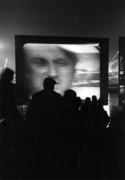
(2) In the meetings that I propose such as “Being = Network”, there can not be an area and a centre which will gain the upper hand, and the same goes for a discipline over a technique. Nor does the image in action simply constitute a performance. It embodies data which can be sound, gestures, an archive, a camera, infinite sources, thanks to digitization: a visualization whose screen is momentarily a performing technical support.
Also, the very existence of this screen in the Parisian space can not be the only grounds for our use of it. It is the context which is virtually projected. It would have been much simpler in a more formal dimension to project somewhere else with total freedom. But I do not want to move the white cube from the gallery, to open a new programme to an audience of contemporary artists, like at the crossroads of Time Square in New York at the beginning of the 1990s.
I am thinking more of an incarnation which, from now on, must no longer just remain within the context reserved for a projection, for it’s not just a projection, but rather of digital data, of finding future areas, like space that is now temporal, for the live broadcasting and recording of our lives. In this way, architecture is no longer the interface for a surface image for our projects, but is valid within a context of watching over emerging issues.
Like the support screens, the urban economy is not the framework of our practice. I am simply looking to determine and be part of the changes that are happening. Using an art without artistic limits, I am not engaging in experimentation but rather in a new way forward, one of widespread interconnection in daily life. So, for each of my designs, a desire to exchange with the professional best is a necessity.
This starts with choosing the site according to the project’s needs as much the same way as its technological items, which is not directly linked to the design or programming. Similarly, the media are no longer mailboxes with images to be re-conceived and re-designed, but are prostheses that are now integrated into our activity and lives.
For example, in our “Global Poetic System” project, which was part of a marathon, we diverted the sporting use of technology towards a digital visual and sound dimension, reconstructable using physical data. I will bring up this necessary conception of new interfaces for these emerging practices in the beginning of December, in a lecture entitled “from Scenography to Network Planetary for e-performance and plug-ins” at the School of Media, Film & Theatre, University of New South Wales, Australia.
To close this “Being = Network”, I would like to share the following anecdote from Bruce Sterling and Richard Kadrey, which is taken from “Dead Media Manifesto”, and which may be found on the Amsterdam internet site “De Balie”. They report the words of Jacqueline Goddarda, a surrealist bohemian figure of 1930s Paris:
“After a day of work, the artists wanted to get away from their studios, and get away from what they were creating. They all met in cafes to argue about this and that, to discuss their work, politics and philosophy… We went to the bar of La Coupole. Bob, the barman, was a terribly nice chap… As there was no telephone in those days everybody used to leave him messages. At the Dome we also had a little place behind the door for messages. The telephone was the death of Montparnasse.”
Our project for third-generation telephones is not necessarily the rebirth of Montparnasse. “You are not the network!” if the projection on the urban screen is your only interrogation. “I am the network!” if you redefine everything with new technology - not only as an urban accessory, but also in the universality of human beings in their future mobile interconnection with the world. While I wait, I am seeking new sensitive places like the Montparnasse Tower in Paris in order to transcribe a new temporality which is now becoming a planetary one." Franck Ancel
(1) Illustration no. 1 “Being = Network”, Paris Montparnasse Tower, photo by Simon Procter, 2004.
(2) Illustration no. 2 “Leisure Street”, Munich Olympic Games, 1972, pp. 42/44/45 “Polieri creator of modern scenography”, Bibliothèque nationale de France, Paris, 2002.
"SPN for urbanscreens05" in Europa and "SPN for refresh!01" in America, these english presentations are now online pdf.
Biography: Born in 1970, France, Franck Ancel works in Paris. He has been probing technology for more than fifteen years. He has traced the development from the avant-gardes artists of the last century to the recent mutations of creation on a planetary scale.He has thus organized and coordinated symposiums, expositions, and performances in cooperation with associations and institutions. The last one was a retrospective on Jacques Polieri, the creator of ”modern scenography,” at the BnF. Since the attacks of 9/11, Franck Ancel has set up an interactive triptych probing “architecture – image – technology” on 20th century heritage sites. In 2002, he put it in the Le Corbusier/Xenakis convent; in 2003 in a classified theater in Catalogne; and in 2004 on the screen of Montparnasse Tower in Paris. Franck Ancel challenges the viewer outside traditional frontiers, by projecting a setting of a network of information on screens. At the same time, he analyzes this technique on a more theoretical level in texts and talk.
Posted by jo at 12:19 PM | Comments (0)
Electronic Frontier Foundation

Is Your Printer Spying On You?
"Imagine that every time you printed a document, it automatically included a secret code that could be used to identify the printer - and potentially, the person who used it. Sounds like something from an episode of "Alias," right?
Unfortunately, the scenario isn't fictional. In a purported effort to identify counterfeiters, the US government has succeeded in persuading some color laser printer manufacturers to encode each page with identifying information. That means that without your knowledge or consent, an act you assume is private could become public. A communication tool you're using in everyday life could become a tool for government surveillance. And what's worse, there are no laws to prevent abuse.
The ACLU recently issued a report revealing that the FBI has amassed more than 1,100 pages of documents on the organization since 2001, as well as documents concerning other non-violent groups, including Greenpeace and United for Peace and Justice. In the current political climate, it's not hard to imagine the government using the ability to determine who may have printed what document for purposes other than identifying counterfeiters.
Yet there are no laws to stop the Secret Service from using printer codes to secretly trace the origin of non-currency documents; only the privacy policy of your printer manufacturer currently protects you (if indeed such a policy exists). And no law regulates what sort of documents the Secret Service or any other domestic or foreign government agency is permitted to request for identification, not to mention how such a forensics tool could be developed and implemented in printers in the first place.
With no laws on the books, there's nothing to stop the privacy violations this technology enables. For this reason, EFF is gathering information about what printers are revealing and how - a necessary precursor to any legal challenge or new legislation to protect your privacy. And we could use your help.
In the preliminary research paper [ Investigating Machine Identification Code Technology in Color Laser Printers] we explain what we've observed so far, briefly explore the privacy implications, and ask you to print and send us test sheets from your color laser printer and/or a color laser printer at your local print shop. That way, we can watch the watchers and ensure that your privacy isn't compromised in ways that harm your fundamental consitutional rights." Find out more >>
Learn to decode Xerox DocuColor tracking dots using our guide - or use the Electronic Frontier Foundation's decoding program to decode them.
Posted by jo at 11:38 AM | Comments (0)
Connessioni Leggendarie

NET.ART History
20 October - 10 November 2005; Mediateca di Santa Teresa, Via della Moscova, 28 - 20121 Milano, MM2 Moscova or MM3 Turati.
Connessioni Leggendarie is the first exhibition devoted to NET.ART history. Referring to a wide audience it reviews the years from 1995 to 2005; during this decade, artists separated by geographical and socio-political barriers shared ideas and artworks, using them as creative weapons over a new and unique continent: the Internet.
Working with net languages, developing collective actions with a strong media impact, bringing irony, deconstruction and, why not, fun inside the formal severity of digital cultures, artists belonging to NET.ART gave life to a true legend.
Between complex theories and Dadaist euphoria, Connessioni Leggendarie will bring us between hopes and fears of our wildly digitized time. A decade of technical and cultural Far West, aiming to explore and to conquer new lands, languages, behaviours, contraddictions and limits of a world traumatically connected to the information highways.
Born with a taste of historical avant-garde and often blamed of computer and media piracy, NET.ART hit all the aesthetic and conceptual targets in a time of change with no precedent. Huge emulations, spoofs and pillages reveal the borders of obsolete conventions and legal parameters. Aesthetical viruses and media epidemics. Software hacked to blow the user's mind rather than the user's computer.
The exhibition tracks the topic moments of NET.ART history, which is however more similar to a Sergio Leone's "dirty plot" than to the clean museum rooms: to the historian's methods it surely prefers the great romancer mitopoietical ability. There's no other way to talk about FuckUFuckMe, the website selling fake technological apparels for cybersex, ordered by real customers as if they were real; Nike Ground, the mock Nike campaign organized by 0100101110101101.ORG that made Wien citizens go out of their mind; the identity correction of the Yes Men, that made G.W. Bush say: "some freedoms should be limited"; the challenge to the esoteric American electoral machine, realized with an auction website, where citizens were able to sell their vote directly to the best bidder ([V]ote-auction di Ubermorgen)...
The epic narration loves digressions: that's why Connessioni Leggendarie gathers the fast-paced narration of these adventures and long excursuses to the utilization of informatic languages as a poetic language [code poetry], and on the transformation of the software into an artwork, regretting functionalities in favour of aesthetical, conceptual or social needs [software art].
Connessioni Leggendarie isn't, and doesn't want to be, a final exhibition: it's only the first, perfectible version of the legend and an attempt to suggest to institutions, which are often insensible, ways and formulas to preserve a history risking to get completely lost as a document and to be at the mercy of the ungovernable limbo of oral history. In 1995, Jeff Rothemberg warned: "Digital information lasts forever - or for five years, whichever comes first".
Aware of this problem, Connessioni Leggendarie tries this new rigorous interface, using the instruments of documentation and emulation to refer to the spirit of the legend, rather than to quote. Therefore, video documents are displayed together with installations, dedicated PCs and panels, depending on the characteristics of every single project.
Invited artists
* Ubermorgen (Austria)
* The Yes Men (U.S.A.)
* Surveillance Camera Players (U.S.A.)
* Sebastian J. F. (Austria)
* RTMARK (U.S.A.)
* Joan Leandre \ retroYou (Spain)
* Mark Napier (U.S.A.)
* Natalie Bookchin (U.S.A.)
* Jodi (Holland)
* 0100101110101101.ORG (Italia)
* Jaromil (Italy/Austria)
* I/O/D (U.K.)
* Heath Bunting (U.K.)
* Florian Cramer (Germany)
* Electronic Disturbance Theater (U.S.A.)
* Cornelia Sollfrank (Germany)
* Alexei Shulgin (Russia)
* Alexander R. Galloway (U.S.A.)
* Adrian Ward (U.K.)
* [epidemiC] (Italy)
* Amy Alexander (U.S.A.)
* Mongrel Project (U.K.)
* Eldar Karhalev & Ivan Khimin (Russia)
* etoy (U.S.A./Holland/Germany/Austria)
* Vuk Cosic (Slovenia)
Posted by jo at 11:28 AM | Comments (0)
Furthernoise.org + VisitorsStudio
![]()
Live A/V Net Performances
Furthernoise.org presents the 2nd in it's series of live A/V net performances Featuring 2TOMS (France) & John Kannenberg (USA); Sunday 23rd October 2005 16.00-18.00 GMT [Time Zone Converter]: Where: Online; and broadcasting live into the Stills Gallery, where the VisitorsStudio is projected live for 2 months to visiting audiences--23 Cockburns St, Edinburgh, Scotland. Also broadcasting live at the theatre of The Point CDC 11.00 - 13.00 EST--940 Garrison Avenue, Bronx, New York.
Furthernoise.org is hosting a series of monthly live A/V net events and is interested to hear from all audio and visual artists who feel that they could create interesting A/V performances in VisitorsStudio. VisitorsStudio is a live multi-user playground, an audio-visual space for artists and musicians to experiment, jam and perform with a real time, online audience. Please contact roger[at]furthernoise.org for more information.
VISITORSSTUDIO AT STILLS GALLERY, EDINBURGH
VisitorsStudio is currently featured as part of Ricochet, an exhibition at Stills Gallery, Edinburgh 16th October - 18th December 2005. Also including work by Henna Nadeem, Leena Nammari, Chris Dooks, Pamela So.
VisitorsStudio Workshop: Ruth Catlow recently worked with artist Henna Nadeem and young girls (8-13) of Saheliya project at the Stills Gallery, Edinburgh. Marc Garrett joined the sessions working remotely, online from london playing & mixing the live sounds as they uploaded & mixed their own imagery as part of the Stills Ricochet exhibition.
Posted by jo at 11:15 AM | Comments (0)
C-THEORY
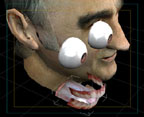
Stelarc's Prosthetic Head
"...Words like "intelligence", "awareness" and "agency" describe particular and peculiar behaviors performed effectively and appropriately in certain locations and situations. We do not need to imagine that they indicate anything other than that. What is important is not what happens within us, but rather what happens between us in the medium of language in which we communicate, in the social institutions within which we operate and in the culture within which we've been conditioned -- at this point in our history and so on, depending on our frame of reference. To talk of agency is to refer to an intentional act defined within a very small frame of reference. [...]
In the body performances, the skin has been stretched, the body has been probed and its limbs have been extended. The interest is to construct alternate interfaces that explore the absent, alien, involuntary and automated. What we experience is emptiness, ambiguity and uncertainty. We fear what we have always been and what we have already become -- a zombie with no mind -- a body that performs involuntarily..." From Prosthetic Head: Intelligence, Awareness and Agency by Stelarc, 1000 DAYS OF THEORY, C-THEORY, VOL 28, NO 3, Editors: Arthur and Marilouise Kroker. Also see Stelarc's Prosthetic Head by Julie Clarke.
Posted by jo at 10:35 AM | Comments (0)
October 19, 2005
SimpleTEXT

a cell phone enabled interactive performance by Family Filter
When: Wednesday, October 26, 2005 (8 pm); Where: New York University (NYU), Kimmel Center for University Life, 8th floor, 60 Washington Square south, Corner of 4th St and LaGuardia Place (on Washington Square Park). [Map] FREE TO ALL. Bring your Cell phone and Wireless Laptop! More info about the Handheld Event.
SimpleTEXT is a collaborative audio/visual public performance that relies on audience participation through input from mobile devices such as phones, PDAs or laptops. SimpleTEXT focuses on dynamic input from participants as essential to the overall output. The performance creates a dialogue between participants who submit messages which control the audiovisual output of the installation. These messages are first parsed according to a code that dictates how the music is created, and then rhythmically drive a speech synthesizer and a picture synthesizer in order to create a compelling, collaborative audiovisual performance.
SimpleTEXT focuses on mobile devices and the web as a bridge between networked interfaces and public space. As mobile devices become more prolific, they also become separated by increased emphasis on individual use. The SimpleTEXT project looks beyond the screen and isolated usage of mobile devices to encourage collaborative use of input devices to both drive the visuals and audio output, inform each participant of each other's interaction, and allows people to actively participate in the performance while it happens.Our purpose with the performance is to create the possibility of large-scale interaction through anonymous collaboration, with immediate audio and visual feedback. SimpleTEXT encourages users to respond to one another's ideas and build upon the unexpected chains of ideas that may develop from their input.
Support/Sponsors:
SimpleTEXT is created by Family Filter, a collaboration between Jonah Brucker-Cohen, Tim Redfern, and Duncan Murphy. It was originally funded by a commission from Low-Fi, an new media arts organization based in London, UK. This event is sponsored by NYU's Program Board and the "Handheld" show.
URLS:
SimpleTEXT
Low-Fi
Jonah Brucker-Cohen
Tim Redfern
Posted by jo at 03:00 PM | Comments (0)
Soundwave (III)' and 'The Teleaesthetic Finger'
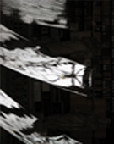
Audible Observation
Josef Albers once said that art is our visual response to the world, to the universe, and to life. Location One's upcoming shows, Slowscan Soundwave (III)' and The Teleaesthetic Finger add acoustics and some mystery to Albers's notion of visual response. In the main gallery, Douglas Repetto's interactive sculpture, 'Slowscan Soundwave (III),' creates 'a simple physical manifestation of complex physical, biological, and social phenomenon.' Awash in motors, electronics and reactive Mylar, the gallery breathes presence into one of the invisible elements that shape our lives: sound. Similarly, the group show in Location One's Project Room, 'The Teleaesthetic Finger,' seeks presence for the invisible; yet these phenomena are less scientific and more extrasensory in nature. Atsushi Nishijima, Kevin Centanni, and Heather Wagner trap sounds of places never visited. The recorded journey of a kite floating out of sight or the signals of inaccessible radio frequencies attempt to capture those invisible, mysterious, but still real parts of our auditory universe. Combined, Location One's shows suggest that our responses to the world, and to life, need observation by more than our eyes. - Alyssa Wright, Net Art News, Rhizome.org.
Posted by jo at 10:20 AM | Comments (0)
Blogging As An Art Project
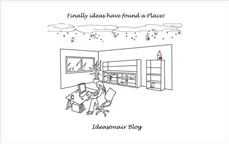
Ideasonair
Ideasonair.net is a web project serving artists. The site promotes artistic ideas in various fildes, especially digital art, therefore: “Dear artists, poets, architects, designers, critics, curators and ‘lovers of the trade’, if you are short of ideas, this is the site for you!”. Here, the ideas “from hyperuranium” have landed and found a place or better, a “virtual factory”. Ideasonair.net will give to you a lot of different ideas, ready to be developed.
Ideasonair, has a particular theory about ideas and how we perceive them. In fact, think of it like this: “ideas are ‘in the air’ and the earth is spinning around, connecting with these ideas at various places. So an identical idea could ‘land’ or be had in New York and Rome at the same time”. This site could be considered somewhat like entropy. It puts in order and takes down ideas for you. This “online factory” will be continually updated to give you always new ideas. Ideasonair, could also carry out specific consulting for your artwork .
Why ideasonair.net? Fell free to ask more info. at: ideasonair[at]hotmail.it
Originally posted by ideasonair at Ideasonair
Posted by luis at 09:52 AM | Comments (0)
October 18, 2005
exhale:
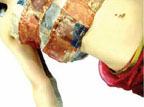
breath between bodies
"At Siggraph 2005 in Los Angeles, one set of skirts stole the e-tech show. The line of techno-couture, exhale: breath between bodies by the whisper(s) research group, takes embodiment seriously in ways that our purely electronic (ARGs and biowriting aside) approach to digital character art often does not. What we see here is not just the exercise of novelty or experiments in electronic composition, but a collective of theoreticians whose hands are busy at the work of stitching communal interaction.
What do the skirts do? They allow your body to communicate through passive (autonomic, if you will) and active means. The ensembles (for they are more than just skirts), using breath bands and vibrators, translate your breath and heart rate into digital signals and transmit this information, only to have it be decoded as sound or vibration. In essence, your breath and heart rate become a language. Your body signifies in its biological semantics. With respect to WRT, the digital character of this art resides beneath the exhale.
The whisper[s] research group based out of Simon Fraser University’s Interactivity Lab has designed, threaded, and painted this “a-wearable” technology, allowing bodies to communicate on an autonomic level. Within this project are three levels of interaction: self-to-self, self-to-other, and self-to-group. First, the wearer can access their own data. Second, through contact with sensors, a wearer can activate a connection with another person, allowing them to receive the senders somatic data. Finally, the wearer can transmit their breath data to a wall of speakers, which then transmits the information throughout the room aurally.
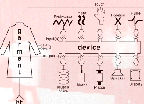
The enmeshed product is melange of cyborg connectivity, future-fashion, and intimate transmission, reading your body and sending the signals through your air, reminding you that your breath has been doing this for quite some time. As the whisper(s) website describes,
the aesthetic of whisper(s) garments is unique and deliberately ambiguous. Fashion for us is vastly innovative and seductive. Prosthetics are creepily creative. The opulent is fundamentally not about cost but about sensuality. Skin is the richest source of inspiration: marked, exposed, nurtured, celebrated.
This is a playful work and yet serious as flesh.
This is group of engaged theoreticians. Thecla Schiphorst of Simon Fraser University is listed as lead on this, but I first heard about it from Susan Kozel at the (dis)junctions: theory reloaded conference at UC Riverside, a talk co-sponsored by the UCR Mellon global_interface workshops. At Riverside, Kozel spoke of the body electric, or wrapped in electronic paraphernalia and research conducted with soldering iron. If you visited their booth at Siggraph, you no doubt saw a team stitching, wiring, and programming going on. Here was the seamstress-programmer-critic, some fulfillment perhaps of Shelley Jackson’s Patchwork Girl.
Seeing the workers with their conductive paint and pdas, I was reminded again of the work behind hand-made interfaces and how different life is behind the technoculture runway. These researchers were up night and day with needle and thread and paintable wires. They seemed materially connected to the process of making and, of course, the technology, not just because they (wearers male or female alike) had to stand still (like proper Victorian ladies) while a technician, usually female, worked on their transmitters but because they were adjusting connections by hand. This is not a women’s project, since among the women (Camille Baker, Diana Burgoyne, Gretchen Elsner, and Sang Mah), were such presumably male names as (Calvin Chow, Jan Erkku, Norm Jaffe, Robb Lovell, Lars Wilke, and Adam Marson). But their does seem to be a purposefully womens’ tech-art aesthetic here. My own tour guide was Lone Koefoed Hansen, the Danish researcher who is in residence at Simon Fraser this fall.
This project is in an engaged networked women’s theoretical praxis. I call this women’s theoretical practice not because all of those who worked on the project were women, but because of a kind of sensibility behind the project that links bodies, seams, and circuits. It is to say, that the project sews itself into conversations of embodied female networks of art (and many other combinations of those five words).
We-make-money-not-art recently featured an “Empathy Vest,” which seems on the face of it to share affinities with this project. The choice of styles, the “sensually evocative skirts worn close to the body” compared to the more androgynous Empathy Vest (with its evocation of Kevlar and circuit boards) might give some sense of differences between the projects. Perhaps one foregrounds gender difference and play while the other offers to break through our bullet-proof physical alienation.
More WRT on Siggraph." [blogged by Mark Marino on WRT]
Posted by jo at 06:57 PM | Comments (0)
ReachMedia ::
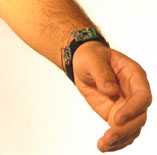
on-the-move interaction with everyday objects
Can we merge the virtual world with the physical world? ReachMedia--by Assaf Feldman, Sajid Sadi, Emmanuel Munguia Tapia--is a system for seamlessly providing just-in-time information about everyday objects. It is built around a wireless wristband with an RFID reader and accelerometers. The wristband detects physical objects that the user is interacting with, and retrieves relevant and personalized information via a smart phone. The user can then have a hands and eyes free interaction with the application by using a unique combination of slight gestural input and audio output. See Bracelet Navigates Net, Technology Review News. Download PowerPoint presentation. [via]
Posted by jo at 06:44 PM | Comments (0)
Faraday Cage
Blocking RFID
To avoid being tracked by readers, Mikey Sklar built an RFID Pocket Replacement that involves building a faraday cage around your clothing's RFID tags. Just rip out a pocket from a pair of jeans and replace it with a cotton like fabric which contains enough conductive material to block most RFID tag frequencies. Have a look at the PDF presentation of his project, it's amazing to see how much RFID is present in our lives. Movie. [via Regine on we-make-money-not]
Posted by jo at 06:26 PM | Comments (0)
Three Crosses of Queensbridge
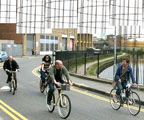
Acoustic Conversions
London-based artist Kaffe Matthews' Three Crosses of Queensbridge is a symphony for radios and bicycles. Replacing notes written on a musical staff are drawings on a neighbourhood map: providing various itineraries for visitors to follow on bikes, the artist broadcasts an electronic composition over a live radio signal. Cycling around the streets with radios receiving the broadcast, participants become performers and passers-by become accidental audience members.
The work is part of the Sounds like Drawing exhibition, at the Drawing Room, East London, 13 October - 20 November 2005. [via Regine on we-make-money-not]
Posted by jo at 06:18 PM | Comments (0)
Reviewing Humanness:

Bodies, Technologies and Spaces
The biennial conference of the European Association for the Study of Science and Technology will be held in Lausanne (Switzerland) from 23rd to 26th August, 2006. All members of the European science, technology and innovation studies community are invited to attend. Contributions are particularly encouraged which address the general conference theme: Reviewing Humanness: Bodies, Technologies and Spaces.
What is it to be human today ? Human “nature” is made and re-made by ideas and practices assembling bodies, technologies, and spaces. Three processes in particular seem to be transforming the very notion of humanness:
1. it is reconfigured by the life sciences, from genetics to neurobiology, with the invention of new forms of human corporeity. Within contemporary philosophy and STS literature, this is associated with conceptual changes, displacing traditional binaries such as human/animal, animal/machine, nature/technology, mind/body towards all kinds of hybrids.
2. it is reassigned to and redistributed throughout sociotechnical networks and artifacts. In other words, the notion of humanness is rethought; it is considered no longer to be enclosed within the human subject, but instead disseminated in and through human-made objects and technological systems.
3. it is rescaled by the increase in transnational connections and the development of a cosmopolitan imaginary. The increase of spatial mobility (international migration, tourism, professional travel, etc.) and information flows, ‘stretching’ social relations across space, have reterritorialized, and in the best cases broadened, our conceptions of humanness.
The conference organisers invite contributions that address both a general conceptualization of humanness and these three particular processes.
The further aim of this conference is to address the political (in the broad sense of the term) dimension of a reviewed humanness. The re-fabrication of humanness is not only an academic thought-experiment but a daily life experience, and sometimes an object of concern, for society as a whole. The organisers therefore also invite contributions specifically focusing on the politicisation of contemporary humanness. Such topics include:
a) issues related to participative forums created by state or supranational organisations to trigger public debate around the anthropological consequences of scientific and technological innovations;
b) initiatives of different segments of civil society (patient organisations, feminist movements, indigenous groups, consumer associations, etc.), including public action and mobilisations, regarding the definition of research agendas, the organisation of knowledge production and diffusion, or the political regulation of the three above-mentioned processes;
c) questions regarding participation in the global redefinition of humanness. Are not large sectors of humankind excluded from these changes? Do they mean the same thing regardless of social class, gender and ethnicity?
Threads:
1. Biomedical practices, politics and markets
2. Medicine, healthcare & patients
3. Information and communication technologies
4. Technological artifacts & users
5. Environments, landscapes and resources
6. Spatialities, transnationalism and governance
7. Expertise, governance & publics
8. Normative issues & the production of norms
9. Science, politics & markets
10. Knowledge objects, practices & cultures
11. Science, culture & arts
12. Practices and processes of innovation
13. STS in practice (methods, research networks, computer tools)
Contributions are welcome from the range of disciplines found within the broad field of science, technology, and society studies. For those whose work does not relate directly to the Conference’s theme, there are open paper sessions.
The draft programme will be posted on the website by the end of March. Please read the guidelines for preparing and presenting papers.
Abstract submissions should include all contact details, the text of the abstract (300 words), three keywords and the preferred Conference Threads. Please use this template file as the basis for your submission and send it by 16th December, 2005 , to easst2006[at]unil.ch
If you plan to propose a session, please send a message to the organisers as soon as possible, and put « session proposal » in the subject of your e-mail. In order to help the preparation of the programme, session proposals will be posted on a page of the Conference's website. Session proposals should include all contact details, the text of the proposed session (600 words max.). Use this template file as the basis for your submission and send it by 16th December, 2005 , to easst2006[at]unil.ch
Posted by jo at 05:55 PM | Comments (0)
PERFORMA Presents TWO-PART SYMPOSIUM

NOT FOR SALE: Writing on Performance and New Media
Curators, Critics and Writers Discuss the Art of Writing about Performance and New Media: Saturday, November 12, 2005, 1:30–5:00 PM; Yalincak Family Foundation Lecture Hall; 19 West 4th Street at Mercer Street, NY.
PERFORMA is pleased to present the fourth installment of NOT FOR SALE: Writing on Performance and New Media, in conjunction with New York University, Steinhardt School of Education, Department of Art and Art Professions, and as part of PERFORMA05, the first biennial of new visual art performance in New York City. The event is free and open to the public, and will take place at New York University’s Yalincak Family Foundation Lecture Hall at 19 West 4th Street on the corner of Mercer on Saturday, November 12, 2005 from 1:30 to 5:00 pm. Reception to follow. For further information, please call PERFORMA at (212) 533-5720, or visit our website.
NOT FOR SALE: Writing on Performance and New Media is a dynamic continuation of the discussion on performance and its relationship to the museum, gallery, critic and collector. The two-part symposium comprised of a distinguished panel of critics and curators will offer an in-depth view of contemporary developments in writings on ephemeral works of art that encompass several creative disciplines.
1:30–3:00 PM
SESSION I: Curating (and Writing on) Performance in the 21st Century: More and more contemporary artists from around the world make live art and performance-related film and video, as well as installation art, with an ever-increasing presence in museums and galleries. How does the current generation of curators, critics, and writers tackle curating and writing about performance differently from the past? In what way has the relationship between the artist, curator, and museum changed over the past decade? A panel of critics and curators will discuss the art of curating performance today.
Catherine Wood, Curator, Tate Modern, London
Katy Siegel, Art historian, Curator and Critic
Phillippe Vergne, Chief Curator, Walker Art Center, Minneapolis
Moderated by Cay Sophie Rabinowitz, Senior Editor, Parkett
3:30–5:00 PM
SESSION II: Writing (and Reviewing) Across Borders–Performance and New Media: Critics and writers on art today need to be well versed in many languages including film, dance, literature, music, architecture and new media. How does an author write across disciplines? How much background in each individual history does a writer need in order to illuminate this multidisciplinary work and to explain its relevance in a broader cultural context to ever-evolving audiences? A panel of critics and writers will explore these questions as they relate to the research, development, and presentation of visual art performance.
Margo Jefferson, Writer and Critic
John Rockwell, Dance Critic, The New York Times
Bennett Simpson, Associate Curator, ICA Boston
Linda Yablonsky, novelist and critic
Moderated by RoseLee Goldberg, Founder and Director of PERFORMA
About PERFORMA: PERFORMA is a 501(c)(3) nonprofit organization committed to the research, development, and presentation of performance by visual artists from around the world. PERFORMA will commission new performance projects in visual arts, establish a dedicated performance biennial, and provide year-round educational programming for this critical area of visual art and cultural history.
About the Department of Art and Art Professions, New York University, Steinhardt School of Education: The Department of Art and Art Professions is committed to the construction of new knowledge through the creation of art and innovative academic research. The Department brings students, practicing artists, educators, and art professionals together in a richly interactive, multidisciplinary community that fosters imaginative art-making and intellectual exchange.
MORE TO COME...
A full program of events is available online:
http://www.performa-arts.org/
For Schedule information:
http://05.performa-arts.org/schedule
For Ticket Information:
http://05.performa-arts.org/ticketinfo
PERFORMA is a 501(c)(3) nonprofit organization committed to the research, development, and presentation of performance by visual artists from around the world. PERFORMA will commission new performance projects in visual arts, establish a dedicated performance biennial, and provide year-round educational programming for this critical area of visual art and cultural history.
Posted by jo at 05:37 PM | Comments (0)
International Cross-Disciplinary Conference
![]()
International Cross-Disciplinary Conference: Architecture | Music | Acoustics--Toronto, Canada; June 8-10, 2006; Abstracts Due: October 31, 2005 (300 words); email: amaconf[at]ryerson.ca.
In conjunction with the SoundaXis festival of music, acoustics, and architecture, Ryerson University Department of Architectural Science is pleased to announce an international conference dedicated to a study of the same themes.
Among the critical fault-lines within architectural practice and discourse is that which privileges sight, conceiving of architecture as primarily a visual art form. Despite the multi-sensorial, embodied nature of our being in space, architectural discourse has been largely silent where senses other than the visual are impacted. This conference proposes to move outside the visual paradigm to investigate the relationships between architecture, music, and acoustics. These intermeshed relationships have tended to one extreme or the other: either sound is understood by architects instrumentally, as an element to be controlled if not eliminated, or music is understood by architects as a metaphorical structure needing to be translated to visual terms before becoming available to architecture. Indeed, one of the few works published in the last half-century on the relationship of architecture and music from within the architectural community is Pamphlet Architecture 16, edited by Elizabeth Martin, which takes as its title Architecture as a Translation of Music.
This conference sees itself as an updating of Martin's work, while starting from the premise that Architecture, Music, and Acoustics have real relationships not requiring translation between visual and sonic terms, and not limited by the instrumental. The conference will involve both historical and critical studies of these relationships, focusing on the strategies and techniques used by architects in dealing with sound and with ideas borrowed from music. The conference will encourage an active mode of engagement with sound in architectural design.
Abstract Requirements
Those wishing to present papers at this conference should submit a brief abstract, of no more than 300 words, by October 31, 2005. Abstracts are to be submitted under one of the following session themes:
I. Acoustic Ecology:how can understanding the acoustic ecology of structured environments foster an auditive culture?
II. Situated Sonic Practices: how does the practice of sound installation art foster new understandings of both sound and place, as well as of the relationships between the two?
III. Spaces for Performance: how have recent developments in the acoustics of performance spaces affected our understanding of the relationships between sound and space?
IV. Intersections of Music and Architecture: how can the interweaving of architecture and music through creative collaborations result in an enrichment of both disciplines?
V. The Poetics of Closure: how can a consideration of sound affect the design of spaces and buildings not specifically intended for performance? Presentations of built work are encouraged in this session.
VI. Sound in Architectural Education: how can a consideration of sound be used to enrich the education of tomorrow's architects?
VII. The Architectural Representation of Sound: how can the predominately visual domain of architectural representation deal with sound? Presenters may approach any of the above topics historically, theoretically, or through the presentation of project work.
Presentations involving current built work are particularly encouraged. Final papers will be expected to have a maximum length suitable for a twenty-minute presentation (approx. 3000 words). Proposals will also be accepted for those wishing to present installations at this conference. Proposals for installation work should be submitted under one of the above session themes, and include a written description of 300 words or less, along with appropriate graphic material. Please note that the organizing committee cannot provide financial assistance for the mounting of installations.
Further information about formatting of abstracts will be posted shortly on the conference website, or by contacting the conference organizers at amaconf[at]ryerson.ca.
Posted by jo at 05:27 PM | Comments (0)
CIAC's Electronic Magazine

art and bio(techno)logy
The CIAC's Electronic Magazine is an online and bilingual (French and English) publication, devoted to cyberculture and art in all its connections with new technologies. Every issue is organized around a particular theme. The Fall 2005 issue is about art and bio(techno)logy.
“Is our ecosphere being altered by Genetically Modified Organisms built for profit margins without authentic oversight or risk assessment? If the technology for genome sculpting of new style humans is a possibility, what, if any, effect will imagination play in our future kindred? What can we know about animal sentience and non-human awareness? How are artists taking these factors into account as they try to express themselves through living collage? As new biological comprehension sprouts new technological processes, what are the overt and covert roles of creativity on the decisions of which traits get embedded into whose new bodies? These are today's major issues emanating from the intersection of Art and Biology.” (Adam ZARETSKY, THE MUTAGENIC ARTS)
In this issue:
· FEATURE : THE MUTAGENIC ARTS, by American artist and researcher Adam ZARETSKY;
· INTERVIEW : BIOART IN QUESTION : Adam ZARETSKY talks with Shannon BELL, Sam BOWER, Dmitry BULATOV, George GESSERT, Kathy HIGH, Ellen K. LEVY, Oron CATTS & Ionat ZURR and Jennifer WILLET ;
· PERSPECTIVE : CRITICAL ART ENSEMBLE : ARTISTIC RESISTANCE IN THE AGE OF TERROR, by Shawn BAILEY (Concordia University);
· FIVE REVIEWS : -BIOTEKNICA (Canada / Quebec, 2000-present), by Anne-Marie BOISVERT; NATURAL REALITY SUPERWEED KIT 1.0, by Heath BUNTING (United Kingdom, 1999), by Xavier MALBREIL; EMBRACING ANIMAL, by Kathy HIGH (USA, 2005), by Jennifer WILLET; GFP BUNNY, by Eduardo KAC (Brazil / USA, 2000), by Ernestine DAUBNER; DISEMBODIED CUISINE, by THE TISSUE CULTURE & ART PROJECT (Australia, 2003), by Jens HAUSER
Anne-Marie Boisvert, Editor in Chief
CIAC’s Electronic Magazine
magazine[at]ciac.ca
Centre international d'art contemporain de Montréal
contact / abonnement / subscribe : magazine[at]ciac.ca
Posted by jo at 05:13 PM | Comments (0)
DIAL-A-DIVA
![]()
Call For SINGERS and CONCERT GOERS
:: scroll down for info in French / German / Spanish / Portuguese::
Take Part in DIAL-A-DIVA an event spanning the globe for 24 hours,connecting singers and listeners live by telephone. The project is inspired by a period in history when the telephone was the first broadcasting medium for entertainment. From the 1880s to 1920s phone companies in many countries including France, Britain, Hungary and America set up subscription services connecting opera houses and theatres to a remote audience, listening via the telephone network. Dial-a-diva serves a similar function, but reflects today’s global telecommunications and social networks.
The event will start at 08:00 GMT on December 3rd in time for evening concerts in New Zealand and Australia. Then as time moves on, concerts will begin throughout Asia, the Middle East, Africa, Europe and ending with the Americas, 24 hours later. An installation at CCA Gallery, Glasgow, Scotland invites visitors to participate and view the hub of operations throughout the project.
To be part of Dial-a-Diva all you need to do is sing into a telephone, or use your phone as a microphone wherever singing happens. The Dial-a-Diva call centre will link as many different types of singing, from as many locations as possible to a wide international audience of telephone listeners. Whether at home, in a concert hall or bar, whether professionally or just for fun, whether accompanied or solo, whatever the singing Dial-a-Diva would love to have you taking part. Sign up, we call you back at the time of your concert wherever you are - world wide participation is free.
SIGN UP
online: www.dialadiva.net
email: dialadiva[at]gmail.com
phone: +44 (0) 141 227 1830 (UK landline)
This project is supported by a Creative Scotland Award and technically realised by Coveline, Intercall Europe, Commercial Decisions, Rook Technologies Inc. & CCA Gallery, Glasgow, Scotland.
----------------(Castellano)---------------
DIAL-A-DIVA :: Participar :: ¿Eres cantante o asistente a conciertos?
Dial-a-Diva es un evento que se extiende por todo el mundo durante 24 horas, conectando cantantes y oyentes por teléfono en directo. El proyecto de Zoe Irvine está inspirado en el periodo de la historia en el que el teléfono era el primer medio de radiodifusión para espectáculos. Desde la década de 1880 hasta la de 1920 las compañías telefónicas de muchos países, incluidos Francia, Gran Bretaña, Hungría y América, ofrecían servicios de abonado conectando teatros de ópera con una audiencia distante, que escuchaba el concierto por conexión telefónica. Dial-a-diva hace esta misma función, pero refleja las redes sociales y de telecomunicaciones globales de nuestros días.
El evento empezará a las 08:00 GMT del 3 de diciembre, a tiempo para los conciertos de la tarde en Nueva Zelanda y Australia. Después empezarán los conciertos en Asia, Oriente Medio, África y Europa, para acabar en América 24 horas más tarde.
Una instalación en Galeria CCA, Glasgow, Escocia, invita al espectador a participar y ver el centro de operaciones del proyecto.
Participar - Para ser parte de Dial-a-Diva lo único que tienes que hacer es cantar por teléfono o usar el teléfono como micrófono allá donde vayas a cantar. La línea de atención telefónica de Dial-a-Diva conectará todo tipo de cantantes, desde todas las localizaciones posibles, a un amplio público internacional de oyentes telefónicos. Ya sea en casa, en una sala de conciertos o en un bar, ya seas profesional o simplemente por divertirte, estés acompañado o sólo, ya sea una canción u otra, Dial-a-Diva está deseando que participes. Inscríbete, te llamaremos a la hora del concierto donde estés – está abierto a todo el mundo.
Inscripciones:
online: www.dialadiva.net
email: dialadiva[at]gmail.com
teléfono: +44 (0) 141 227 1830
Este proyecto esta subvencionado por Creative Scotland Award y cuenta con realización técnica de Coveline, Intercall Europe, Commercial Decisions, Rook Technologies Inc. & CCA Gallery, Glasgow, Escocia.
----------------(Deutsch)---------------
DIAL-A-DIVA :: TEILNEHMEN :: Sind Sie Sänger/in oder
Konzertbesucher/in?
Dial-a-Diva ist ein weltumspannendes Event, dass Sänger/innen und Zuhörer/innen für 24 Stunden live über Telefon verbindet. Das Projekt ist inspiriert von der historischen Periode in der das Telefon als erstes Übertragungsmedium für Unterhaltung verwendet wurde. Telefongesellschaften aus vielen Ländern, unter anderem aus Frankreich, Grossbritannien, Ungarn und Amerika haben zwischen 1880 und den 20iger Jahren des 19.Jahrhunderts ein Abonnementservice eingeführt, dass einer abgeschiedenen Zuhörerschaft ermöglichte, Aufführungen aus verschiedenen Opernhäuser und Theater live via Telefon zuzuhören. Dial-a-Diva hat eine ähnliche Funktion und reflektiert dabei die heutigen globalen telekommunikations und sozialen Netzwerke.
Das Event beginnt am 3.Dezember 2005 um 08:00h GMT – zeitgerecht für Abendkonzerte in Neuseeland und Australien. Den Zeitzonen veresetzt entsprechend, beginnen die Konzerte in Asien, im mittleren Osten, Afrika, Europa und enden 24 Stunden späeter in den Amerikas. Eine Installation in der CCA Gallerie Glasgow, Schottland, ladet Besucher zum Mitmachen und zum Beobachten der gesamten Operation ein.
TEILNEHMEN
Sind Sie Sänger/in oder Konzertbesucher/in?. Um dabei sein zu können benötigen Sie nur ein Telefon in das Sie selbst Singen oder einen Ort wo gesungen wird und Ihr Telefon dabei als Mikrofon benutzen. Dial-a-Diva verbindet möglichst viele unterschiedlichste Gesangsrichtungen von möglichst vielen unterschiedlichen Orten mit einer breiten internationalen Telefonzuhörerschaft. Ob zu Hause, in einer Konzerthalle oder in einer Bar, professionell oder zum Spass, ob eine Stimme oder viele, was auch immer der Gesang ist, Dial-a-Diva würde sich sehr über Ihre Teilnahme freuen.
Melden Sie sich online, via email oder Telefon an und Sie werden von uns zum Zeitpunkt des Konzerts kostenlos zurückgerufen – wo auch immer Sie sich befinden.
Anmeldung durch:
online: www.dialadiva.net
email: dialadiva[at]gmail.com
telefon: +44 (0) 141 227 1830 (UK landline)
Dieses Projekt ist von Creative Scotland Award gefördert und technisch umgesetzt von Coveline, Intercall Europe, Commercial Descisions, Rook Technologies Inc. & der CCA Gallerie Glasgow, Schottland.
----------------(Francais)---------------
DIAL-A-DIVA :: Vous estes un chanteur ? Un spectateur ? :: PARTICIPER
Dial-a-Diva est une action artistique qui traverse le globe pendant 24 heures, soit l'interconnexion de chanteurs et d'auditeurs en direct au téléphone. Ce projet se réfère à une période de l'histoire où le telephone était considéré comme un médium de diffusion de programme de musiques et d'entertainment. Des années 1880 à 1920, les compagnies de téléphones de nombreux pays comme la France, la Hongrie, le Royaume-Uni et les États-Unis, mirent au point un service de souscription qui proposait des écoutes en directs des Opéras et Théâtres à une audience connectée au réseau téléphonique. Dial-a-Diva rempli aujourd'hui une fonction identique, tout en reflétant l'esthétique et la philosophie des réseaux aujourd'hui.
L'action commence à 08:00 GMT le 3 décembre 2005, en synchronisation avec le débuts de concert lyriques en Australie et en Nouvelle Zélande. Puis d'un décalage horaire à l'autre, les concerts surgiront d'Asie, du Moyen Orient, d'Afrique, d'Europe et s'achèveront en Amérique 24 heures plus tard. Une installation au CCA de Glasgow en Écosse, invite les spectateurs-auditeurs à participer et à suivre le théâtre des opérations.
Pour participer à Dial-a-Diva tout ce qu'il vous suffit de faire c'est de chanter dans votre téléphone, ou utiliser votre téléphone portable comme microphone partout ou il y a de la chanson. Le centre d'appel Dial-a-Diva va diffuser toute sorte de chants, de partout dans le monde à un public international d'auditeurs téléphoniques. Si vous êtes chez vous, ou dans un bar ou une salle de concert, si vous êtes amateur ou professionel, de n'importe quel style de chanson, Dial-a-Diva sera heureux de votre participation. Inscrivez -vous, on vous appellera à l'heure de votre concert quelque soit l'endroit ou vous êtes. La participation est gratuite.
Inscrivez -vous
online: www.dialadiva.net
email: dialadiva[at]gmail.com
tel: +44 (0) 141 227 1830 (téléphone fix GB)
Ce projet est soutenu par une bourse de Creative Scotland.
Réalisation technique: Coveline, Intercall Europe, Commercial Decisions, Rook Technologies Inc. & galerie CCA, Glasgow, Ecosse.
----------------(Portugues)---------------
DIAL-A-DIVA (Disque-Diva) :: PARTICIPE :: Você é cantor/a ou freqüentador/a de concertos?
DIAL-A-DIVA é um evento abarcando o planeta durante 24 horas, conectando cantores/as e ouvintes ao vivo por telefone. A inspiração do projeto da artista escocesa Zoe Irvine foi um período na história quando o telefone foi o primeiro meio de transmissão usado para entretenimento. Da década de 1880 até a década de 1920 empresas telefônicas em muitos paises, entre os quais a França, o Reino Unido, a Hungria e os EUA., estabeleceram services por assinatura, conectando assim casas de ópera e teatros a um público remoto que ouvia pela rede telefônica. Disque-Diva preenche uma função semelhante, porém reflete as redes globais atuais, tanto sociais como as de telecomunicações.
O evento começará às 8 horas GMT no dia 3 de dezembro em tempo para pegar os concertos noturnos na Nova Zelândia e Austrália. Conforme a hora vai avançando, outros concertos começarão na Ásia, no Oriente Médio e na África, terminando 24 horas mais tarde nas Américas. Uma instalação no CCA (Centro para Artes Contemporâneas) em Glasgow, na Escócia convida visitantes a participarem e observar o centro de operações durante todo o projeto.
PARTICIPE - Você é cantor/a ou freqüentador/a de concertos ? Para participar no Disque-Diva a única coisa que você precisa fazer é cantar no telefone ou usar o seu telefone como microfone em qualquer lugar onde estiver alguém cantando. O centro de ligações de Disque-Diva vai
Conectar tantos quantos estilos diferentes de cantar e tantas quantas localidades possíveis a um grande público internacional de ouvintes por telefone. Seja em casa, numa sala de concertos ou num bar, seja profissionalmente ou somente por diversão, acompanhado ou solo, seja que for o cantar, Disque-Diva adoraria ter a sua participação. Assine já - nós ligaremos para você na hora do seu concerto onde você estiver – a participação em qualquer lugar do mundo é grátis.
online: www.dialadiva.net
email: dialadiva[at]gmail.com
Telefone: +44(0) 141 227 1830 (telefone fixo – Reino Unido)
Este projeto foi possível graças ao prêmio “Creative Scotland Award”, com realização técnica por Coveline, Intercall Europe, Commercial Decisions & Rook Technologies Inc. & CCA (Centro para Artes Contemporâneas) Glasgow, Escócia.
_______________________________________________
a m b i t : networking media arts in scotland
post: ambit[at]a-r-c.org.uk
archive: www.a-r-c.org.uk/ambit
Posted by jo at 04:53 PM | Comments (0)
Ether | Airspace

Airspace: Radio, network art, ontology and ether
Airspace: Radio, network art, ontology and ether at Location One: 19 October, 2005--Joe Milutis will give a talk, perform a radiophonic chamber piece (bring your own radios), and introduce his forthcoming book Ether: The Nothing That Connects Everything.
About the book: "Diagrams the interconnections among cosmic consciousness, hermetic avant-gardes, and technological progress.
Every culture has its own word for this nothing. Synonymous with the idea of absolute space and time, the ether is an ancient concept that has continually determined our definition of environment, our relations to each other, and our ideas about technology. It has also instigated our desire to know something irrepressibly beyond all that.
In Ether, the histories of mysticism and the unseen merge with discussions of the technology and science of electromagnetism. Joe Milutis explores how the ideas of Anton Mesmer and Isaac Newton have manifested themselves as the inspiration for occult theories and artistic practices from Edgar Allan Poe’s works to today. In doing so, he demonstrates that fading in and out of scientific favor has not prevented the ether, a uniquely immaterial concept, from being a powerful force for material progress.
Milutis deftly weaves the origins of electrical science with alchemical lore, nineteenth-century industrialism with yogic science, and network space with dreams of the absolute. Linking the ether to phenomena such as radio noise, space travel, avant-garde film, and the rise of the Internet, he lends it an almost physical presence and currency. From Federico Fellini to Gilles Deleuze, Japanese anime to Italian Futurism, Jean Cocteau to NASA, Shirley Temple to Wilhelm Reich, Ether traverses geographical boundaries, spiritual planes, and the divide between popular and high culture.
Navigating more than three hundred years of the ether’s cultural and artistic history, Milutis reveals its continuous reinvention and tangible impact without ever losing sight of its ephemeral, elusive nature. The true meaning of ether, Milutis suggests, may be that it can never be fully grasped.
Joe Milutis is assistant professor of art at the University of South Carolina. His writing has appeared in such publications as ArtByte, Wide Angle, Film Comment, and Cabinet."
Posted by jo at 08:31 AM | Comments (0)
October 17, 2005
SPECFLIC 1.0

dress for 2030
Public Launch October 28th, 2005; Pre-show 8pm, main event 9pm-midnight; Calit2 Courtyard, UCSD Campus.
Set in 2030, SPECFLIC's story is not just told, but experienced. Based on cutting edge science and engineering research, SPECFLIC 1.0 performs the social costs and benefits of accelerated progress. What type of future do you envision? Come be part of the public launch of this ongoing performative media project!
Bring wireless devices (laptops & cell phones). In honor of Halloween, dress for 2030.
Directed by Adriene Jenik; Additional text by author Kim Stanley Robinson. Featuring performances by Allison Janney, Ricardo Dominguez, Richard Jenik, Lisa Brenneis and Nao Bustamante. Innovative public interaction modules by Neil McCurdy, Andrew Collins, Robert Twomey, DoEat and Radioactive Radio. [Related post]
Posted by jo at 05:00 PM | Comments (0)
Soft-wear: Active Materials
![]()
Symposium :: Workshop :: Open Lab
Soft-wear: Active Materials is a part of the x-med-k. series of workshops, organised by Nadine, 0kn0 and FoAM.
Bite-size Symposium [25/26 October 2005]; Workshop [25-31 October 2005]; Open Lab [31 October 2005]: where: 0kn0, Koolmijnenkaai 30-34 Quai des Charbonnages, B-1080 Brussels, Belgium.
The era of garments, furniture and buildings designed as static and predefined objects [with short expiration dates] is drawing to an end. Fashion and architecture are on the verge of becoming dynamic, semi-permeable membranes open to the diverse surroundings enveloping the human body. The Soft-wear symposium, workshop and open lab will offer a glimpse into the world of active materials that form the foundation of these novel design paradigms. Soft-wear is a place where electronics meets the traditional crafts of weaving, dyeing and knitting fibres and threads, to produce materials that can respond to touch, temperature, light and other external stimuli. They are used as tangible interfaces and displays for fashion, architecture, design, performance and other forms of contemporary creative expression, where the edge between materials and media rapidly dissolves.
Posted by jo at 11:32 AM | Comments (0)
SUPER VISION

and Sweat Anticon
The Builders Association (Alladeen) and digital design studio dbox reveal a society in which "dataveillance" goes beyond anything Orwell ever imagined. Dive into this fresh, funny, and often disturbing combination of cutting-edge computer-generated animation, new video techniques, electronic music, and live performance. SUPER VISION probes three absorbing, intertwining, and all too-close-to-home stories drawn from the datasphere that explore the dangerous minefield of lives reduced to data.
![]()
Enter the Sweat Anticon: a hooded sweatshirt that zips up to the top of the hood, leaving only eyeholes for the wearer to see out - effectively blocking the view of Big Brother. Good for anonymity, bad for a visit from the Department of Homeland Security. Interesting how the mere act of wearing such a garment and taking advantage of the ability to see but not be seen turns the wearer into the very thing he was attempting to evade. The watched is now the watcher. [via Leigha and Paul Schmelzer] [Related]
Posted by jo at 10:36 AM | Comments (0)
Creative Lab
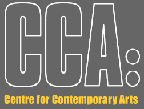
Call for Submissions
CCA in Glasgow announces the next Creative lab opportunities to begin in April 2006. Artists working in the live art, contemporary performance, new theatre, time based media and interdisciplinary arts sectors are invited to submit proposals to be considered for a CCA Creative Lab. The creative lab opportunity offers space, technical support and facilities, administrative and development advice and support.
The amount of time offered would be between 3 to 7 weeks within April 06 - March 07. We would like to offer four Labs to Scottish based artists and two labs for artists outside Scotland. Deadline for proposals: Monday 14th November; 2005 Enquiries: grace[at]cca-glasgow.com.
Posted by jo at 10:00 AM | Comments (0)
OPEN FADER @ Sonorities 2006
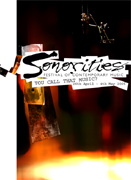
Sonorities Festival of Contemporary Music
Call for Works: The Sonorities Festival of Contemporary Music in Belfast invites composers and artists working with sound to submit works to be presented during Sonorities 2006. This year’s festival is dedicated to music performance practice that challenges the traditional roles of composer, score, performer and audience. We welcome works by composers/performers, improvisers, new media artists, sound and installation artists.
We encourage two types of submission (maximum 1 work per category): 1. Live Performances involving technology: This includes laptop improv, VJ, audio-visual, live-electronics, sound poetry, hacktivism. Please submit the work in a documentary format that reflects the nature of the performance (e.g. video on DVD, audio on CD, software for Mac/PC, photographs). 2. Electroacoustic Music (Stereo or Multi-channel): This includes Stereo works for diffusion, multi-channel works and works with video. All submissions must be on DAT, CD or DA88. Works with video must be on DVD.
Selected works will be featured in four special concerts during the Festival. These events will take place in the Sonic Arts Research Centre Sonic Lab performance space. This unique environment for the performance of electroacoustic music includes facilities for sound projection in a full 3D environment through loudspeakers located above and below the audience area. The experimental nature of the space makes it essential that selected composers and artists attend the Festival to perform their pieces. Artists are expected to finance their participation. Sonorities will be able to provide letters of support, which can aid in seeking funding. Please include a title, program notes as well as a short biography with the submission. Contact information should include a phone number, address, and an email address. All materials will become part of SARC’s media library and may be considered for future events.
Post to works to:
OPEN FADER
Sonorities 2006
Sonic Arts Research Centre
Queen’s University Belfast
Belfast BT7 1NN
Northern Ireland
Important Dates:
Deadline for Submissions: 25th November 2005 (postmarked)
Festival Dates: 25 April – 1st May 2006
Contacts: Dr. Pedro Rebelo (Festival Chair) P.Rebelo[at]qub.ac.uk
Sonic Arts Research Centre
The Sonic Arts Research Centre (SARC) is a newly established centre of excellence, dedicated to the research of music technology. This unique interdisciplinary project has united internationally recognised experts in the areas of musical composition, signal processing, internet technology and digital hardware. The Centre was completed in October 2003 and was officially opened by Karlheinz Stockhausen in April 2004. Send an email to sarc@qub.ac.uk to add your name to the Festival mailing list.
Posted by jo at 09:40 AM | Comments (0)
Functional Portraits:
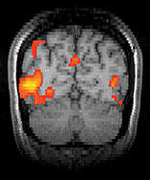
Picturing the Invisible Body
"There has been a trend in questioning whether science and art should be identified as two separate cultures. Arguments can easily be found in favour or against such statement. It is probably more productive to recognise that the important issue concerns the connections that can be, and have been, established between art and science. Since modernity, it is difficult to consider visual arts without realising direct and indirect links to science. The prominence of biology and biotechnology in the science of today has an equivalent high repercussion in visual arts practise. The appropriation of biology as an art medium can be seen as a natural development: appropriation of scientific imagery would not be sufficient, as in the art of today the process is as important as the outcome." From Functional Portraits: Picturing the Invisible Body by Marta de Menezes [via newmediaFIX]
Posted by jo at 09:33 AM | Comments (0)
Songdo City
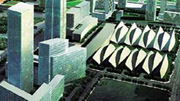
South Korea's "Ubiquitous City"
In what at first seems to be a throwback to the utopian urban visions of early 20th century futurism, South Korea is developing a "U-City" from the ground up, using bleeding-edge "ubiquitous" technology to monitor everything from citizens' medical records to garbage collection.
New Songdo City, being built on a man-made island 40 miles from Seoul, will feature pervasive computer technology throughout, driven by RFID tags and CDMA wireless communication. Although many Western observers would find the lack of privacy disquieting, Asian countries are more interested in the technological potential of such environments. Says John Kim, a Korean-American who is leading the planning for the U-City:
"U-life will become its own brand, its own lifestyle... [A resident's smart key] can be used to get on the subway, pay a parking meter, see a movie, borrow a free public bicycle and so on. It'll be anonymous, won't be linked to your identity, and if lost you can quickly cancel the card and reset your door lock.
"Residents will enjoy 'full videoconferencing calls between neighbors, video on demand and wireless access to their digital content and property from anywhere in Songdo.'"
With English as its official language, the city is designed to attract international business as a "free economic zone." The city will also feature ample open-space parkland and recreation facilities. The $25 billion project is slated for completion in 2014. Already, South Koreans are already applying for the chance to be among New Songdo's 65,000 residents. Sources: New York Times, Future Feeder. [posted by Brian on FutureWire]
Posted by jo at 09:17 AM | Comments (0)
World-Information City
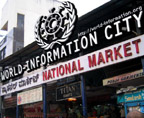
Billboard Call Bangalore 2005
World-Information City "Billboard Call Bangalore 2005" artists campaigning projects with Marina Grzinic, Ljubliana; Elffriede, Vienna. And a panel discussion on IP and the City with Hanna Hacker, Vienna; Felix Stalder, Zurich; Veronika Weidinger, Vienna.
IP and the City: Restricted Lifescapes and the Wealth of the Commons: The booms, bubbles and busts of the digital networking revolution of the 90s have ebbed into normality. The new logic of information economies is interacting with the full range of social and political contexts, producing new systems of domination but also new domains of freedom. It is now that from deep societal transformations the new informational lifescapes start to emerge.
Thus it has become necessary to highlight the strong normalizing forces that shape this process. This is not just a question of abstract information policy. On the contrary, the building of immaterial landscapes has very material consequences for social, cultural and economic realities. With digital restriction technologies and expanded intellectual property regimes on the rise, it is an urgent task to develop new ways to protect and extend the wealth of our intellectual and cultural commons.
Human life is physical and informational at the same time, our physical and cultural dimensions are mutually constitutive. Their interrelations emerging from historical and local context are now more than ever influenced by global transformations in the info sphere. The term "globalization" describes a deep change in how physical and informational spaces are organized and how they intersect with one another to form landscapes, both physical and informational. "Zoning", the establishment of domains governed by special rules, is a key concept to understand these new landscapes.
Physical space is increasingly fragmented into "export zones", special "safety zones", VIP lounges at transportation hubs, gated communities, "no-go areas" and so forth. Just when for the first time in history a majority of humanity lives in cities, their form starts dissolving and is replaced by a patchwork of distinct sectors. Every city has places that are fully global alongside others which are intensely local, "first world" and "third world" are no longer regional identifiers, but signify various patches within a single geographic domain.
Informational landscapes are fragmented by similar processes. What used to be relatively open and accessible cultural spaces are increasingly caved up in special administrative zones, privatized claims of intellectual property, and policed through the ever increasing scope of patents and copyrights. What comes natural to people, to create, transform and share ideas, thoughts, and experiences - - as songs, as computer programs, as stories, as new processes how to make things better - is being prohibited by proprietary claims of "data lords" who enforce dominion over their own zones of the cultural landscape. This is accompanied by intense propaganda efforts extolling the "evils" of sharing culture. There is no trespassing, and while their culture is ubiquitous around the globe, we are more and more restricted from making our own.
Counter-movements that talk about the commons instead of proprietary zones have been gathering strength around the globe. The goal is to devise new ways in which information can flow freely from one place to another, from people to people. Instead of deepening fragmentation, information and cultures are held to be a resource produced and used collaboratively, rather than being controlled by particular owners. People should be free to appropriate information as they see fit, based on their own historical and personal needs and desire, rather than having to consume the standardized products of McWorld. More than ever informational commons, accessible under conditions of their own choosing, are needed to help reconnect people bypassed by the standard flows of information and capital.
In this paper, we bring together theoreticians and practitioners, artists and lawyers, programmers and musicians who offer a diverse critique of the new regime of physical and informational zoning. This collection of cultural intelligence looks into alternative models of how to reinvent cultural practices based on a collaborative plurality of commons and, perhaps, imbue fragmentation of space with a new positive sense of shared differences. As each and every one of us produces culture in the course of our daily lifes, we are forced to choose sides: do we, in the myriad of small acts that constitute life in the information society, enforce restrictions or enable access?
Konrad Becker, Netbase/t0, Institute for New Culture Technologies
Felix Stalder, lecturer in Media Economics at the Academy of Art and Design, Zurich, co-founder of openflows.org
http://world-information.org/wio/program/events/1128950005
http://world-information.org/wio/wsis
http://world-information.org/wio/program/bangalore2005
World-Information City is part of an ongoing project between Bangalore, Delhi, Amsterdam and Vienna (www.opencultures.net)
Posted by jo at 08:52 AM | Comments (0)
LIFE2[at]SPACE
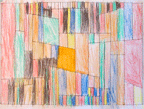
JeanRichard-family, life, art
LIFE2[at]SPACE is a live performance by Family JeanRichard, taking place in UpStage on Saturday 29 October at 10am MEZ. It will feature 3 works of JeanRichard; 4 avatars; 5 props. Check your local time at http://www.worldtimeserver.com. One hour before the performance starts, there will be a live link to the stage from http://jeanrichard.ch/life2.
JeanRichard work as family and show their processes and products on their weblog. The weblog represents the art project itself, but serves also as a gallery where posts are sold online, and we are up to build up a kind of museum (other artists/curators etc show works that are related to JeanRichard). See Baby Blogging.
Posted by jo at 08:43 AM | Comments (0)
fibreculture issues 4 + 5

Diseases of Information and New Media Labour
fibreculture issue 4 - contagion and the diseases of information includes: Living Dead Networks by Eugene Thacker; Digital Monsters, Binary Aliens – Computer Viruses, Capitalism and the Flow of Information by Jussi Parikka; Marginal Networks: The Virus between Complexity and Suppression by Roberta Buiani; and Rhythmic Parasites: A Virological Analysis of Sound and Dance by Stamatia Portanova.

fibreculture issue 5 - multitudes, creative organisation and the precarious condition of new media labour includes: From Precarity to Precariousness and Back Again: Labour, Life and Unstable Networks by Brett Neilson and Ned Rossiter; On the Life and Deeds of San Precario, Patron Saint of Precarious Workers and Lives by Ilaria Vanni and Marcello Tarì; A Playful Multitude? Mobilising and Counter-Mobilising Immaterial Game Labour by Greig de Peuter and Nick Dyer-Witheford; Precarious Playbour: Modders and the Digital Games Industry by Julian Kücklich; Postcard from the Edge: Autobiographical Musings on the Dis/organisations of the Multimedia Industry by Linda Leung; Speculations on a Marxist theory of the Virtual Revolution by Bob Hodge and Gabriela Coronado; Learning and Insurgency in Creative Organisations by Paul Newfield and Timothy Rayner; and Dawn of the Organised Networks by Geert Lovink and Ned Rossiter.
Posted by jo at 08:34 AM | Comments (0)
October 15, 2005
odys
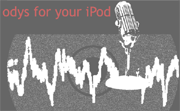
a non-linear video art series for iTunes and iPod
odys for your iPod is an extension of Nathaniel Stern's odys series, 2001-2004. The odys series consists of six short digital video poems/monologues for small screen viewing in an intimate gallery space. By stuttering between odys' actions and words, listeners construct his person. As he attempts to re-member, bringing the past back to his body and calling it his own, listeners attempt to piece together a story for themselves. Viewers are encouraged to re-visit and jump over juxtaposed media, and create a shifting collage of, and in response to, his person.
![]() odys for your iPod encourages viewers to download all six of the newly optimized video art pieces from odys.org, and into iTunes and their iPods. It allows for an even more intimate and physical relationship with his character, as well as a continually growing connection with each vignette.
odys for your iPod encourages viewers to download all six of the newly optimized video art pieces from odys.org, and into iTunes and their iPods. It allows for an even more intimate and physical relationship with his character, as well as a continually growing connection with each vignette.
odys' name comes from The Odyssey; he is the traveler, the seeker of home (Ithaca). Contrary to both Odysseus and hektor, odys is an unconvincing liar and horrible storyteller. His failed attempts to speak the traumatic past are often mistaken for nonsense. Ironically, odys’ poor endeavors at communication can now be largely consumed by a take-away transmission: online. odys' language of utterances is about the "spaces between." The space between words, between articulation and inarticulation, between Troy and Ithaca, between judgment and responsibility, and between speaker and listener.
Posted by jo at 11:29 AM | Comments (0)
theatre of restless automata
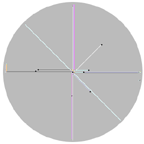
A randomSeed Online real-time Event
With the launch of a new work, randomSeed Online, within the theatre of restless automata at HTTP, you are now able to view the development of this computational system remotely, in real-time on the web.
RandomSeed Online uploads an image every hour from one of the systems installed in the gallery. Online visitors can view how the system develops from its (online) launch (which was on the 8th October) to the closing of the exhibition at 5pm on 23rd October 2005. View the work from here.
Emergence and Poetics in Restless Automata: On the 8th October Boredomresearch gave a talk at the gallery, discussing the relationship between emergence and poetics in respect to generative computational artwork. Using works from 'theatre of restless automata' they explore the notion that inherent mystification in emergent and computational abstraction takes on a poetic form. You can download illustrated text that was presented at the artists' talk.
For further information about randomSeed please visit here. Here boredomresearch presents research and development material that led to these computational systems being created. boredomresearch unveil investigations into simple rules found in natural systems and how these can produce diverse and complex images free from their aesthetic control.
randomSeed Online was created by boredomresearch for HTTP with programming by Neil Jenkins. It was made possible by Aspex Gallery.
Getting to HTTP:
Unit A2, Arena Business Centre,
71 Ashfield Rd, London N4 1NY
Tube: Manor House, Buses: 341, 141,
Car: free parking facilities
Posted by jo at 11:29 AM | Comments (0)
Performance Perimeters Symposium

Experiments and Conversations
Performance Perimeters Symposium is a festival and conference for performance art, experimental dance and experimental theatre organized by Neutral Ground, New Dance Horizons, Curtain Razors, Sakewewak Artists Collective. November 2-6, 2005. Open to the public. Advance registration encouraged.
Performance Perimeters Symposium is organized in conjunction with a Performance Creation Canada conference to engage a conversation between artists, presenters and audiences on the convergence of forms and ideas that have come to characterize the forums of performance and multi-disciplinary art. The conference includes panel presentations on the subjects of arts and markets, intangible heritage, representation & self representation, cultural agency, audiences, economies, criticism and curation as well as a debate on the Status of the Artist.
This unique Regina event is being organized by four arts organizations who have joined in presenting live perspectives and practices from a wide range of contemporary artists and thinkers.
Organized by New Dance Horizons, Neutral Ground, Curtain Razors and Sakewewak Artists Collective, PPS is a meeting ground for artists and public to engage with performance work and join in the conversation with other artists, presenters, theorists and writers. Artists including Istvan Kantor, Edward Poitras, Jillian Mcdonald, David Yonge, Debra Dunn, Lori Blondeau, PHONO, Sarah Abbott, Davida Monk, Helen Walkley, John Noestheden, Rob Bos, The Skeleton Crew (Seema Goel, Steve Kirkland), Robin Brass, Lynn Acoose, Elwood Jimmy, Joey Tremblay, Carol Grey Eyes and others will perform in more than eight Regina locations. There will be a reading of the work of the late Emily Givner, a Web launch for a commissioned project at Soil Digital Media Suite and a Book Event, presenting recent performance art papers and publications with Johanna Householder.
Panelists David Garneau, Kathleen Irwin, Rachelle Viader Knowles, Daniel Anderson, MJ Thompson, Dannys Montes de Oca Moreda, Adrienne Wong, Maiko Bae Yamamoto, Naomi Campbell, Glenn Alteen (Moderator) and Jack Udaskin (Moderator), will introduce new approaches to the economies of performance art and interdisciplinary work.
"Enjoy the restorative powers of symposia." A time and place to take in a moment, a breath, a critical "pause" as Brian Patterson suggests, "We might be doing by engaging & being engaged in the performative."
Performance program and events start with an introductory event Wednesday November 2 and commence Thursday November 3 through Sunday November 6, 2005. Performance Creation Canada meetings and events take place over the weekend with registration available on line and starting Friday, November 4 at 4:00 pm. The public are invited to attend all events.
Conference registration continues at 4:00 pm on Friday November 4 at Regina's Royal Canadian Legion, 1820 Cornwall Street, Regina, SK.
The organizers acknowledge funding support from the Canada Council for the Arts, the Saskatchewan Arts Board, the Department of Canadian Heritage Arts Presentation Canada and the City of Regina.
Advance registration encouraged.
PPS/PCC Schedule: (please check this site for updates and further details).
Wednesday, November 2, 2005
Introductory event at New Dance Horizons, 7:30 pm
(2207 Harvey Street)
New work by THE SKELETON CREW; Seema Goel, Steve Kirkland
Thursday, November 3, 2005
Processional Performance, Lori Blondeau, Neutral Ground to Mysteria, 3:30 pm
(1856 Scarth Street)
Reception and Book Event with Johanna Householder, Mysteria Gallery 5:00 pm
(2706 13th Avenue)
Also at Mysteria:
Reading-performance, the work of the late Emily Givner
Sarah Abbott, Photography
Robin Brass, Performance
(Thursday continued.../)
8 minute max performances, New Dance Horizons, 8:00 pm
(2207 Harvey Street)
Friday, November 4, 2005
Arts Projects Gallery performance, Rob Bos, 12:00 - 2:00 pm
(1217 15th Avenue)
Performance, Edward Poitras, Sakewewak 1:00 - 4:00
(2536 11th Avenue)
Performance and official launch of PCC Regina, Legion Hall
(1820 Cornwall Street)
Work by David Yonge, PHONO, John Noestheden 4:00 - 7:00 pm
Late show at New Dance Horizons, 9:00 - 11:00 pm
(2207 Harvey Street)
Artists Debra Dunn, Davida Monk, Helen Walkley
Saturday, November 5, 2005
Welcome and introductions, 9:30 - 10:15 am
Panel Presentations, RPL Theatre, 10:15 am - 4:30 pm
(2311 12th Avenue) downstairs
1) Curating and Criticism, Glenn Alteen, Moderator, 10:15 am - 12:00 noon
Panelists: David Garneau, Kathleen Irwin, Rachelle Viader Knowles, Daniel Anderson, MJ Thompson, Dannys Montes de Oca Moreda
2) Audiences and Economies, Jack Udaskin, Moderator, 2:00 pm - 4:00 pm
Panelists: Adrienne Wong, Jillian Mcdonald, Maiko Bae Yamamoto, Naomi Campbell, Marnie Badham
Status of the Artist DEBATE, RPL Theatre, 4:30 pm
Opening, Launch of Jillian Mcdonald's "Screen Kiss", Soil Digital Media Suite, 8:00 pm
(1856 Scarth Street)
Performance, Istvan Kantor, TRANSMISSION MACHINERY, Neutral Ground 9:00 pm
(1856 Scarth Street)
$3.00 tickets at the door
Outdoor event, Scarth Street Mall, Lynn Acoose and Elwood Jimmy, 10:00 pm
Sunday, November 6, 2005
PCC Steering Committee meeting, Hotel Saskatchewan Radisson Plaza, 9:30 am
Brunch, Hotel Saskatchewan Radisson Plaza, 11:00 am
Roundtable, Hotel Saskatchewan Radisson Plaza, 2:00 pm
(2125 Victoria Avenue)
Conference Registration is $15.00 and includes;
November 4 Legion Performance Event and Welcome
November 5 Conference Panels at Regina Public Library
November 6 Closing Roundtable and Closing Remarks
Any single conference event is $10.00.
All other festival performance events have tickets available at the door, where applicable. Some events are free. No advance purchase available. Everyone is welcome to come to the Sask Hotel Brunch, Sunday at 11:00 am.
Conference registration is limited.
To register, please email Michele Sereda at (306) 757-5391
or email, michelesereda[at]sasktel.net
or mail PCC Conference Registration
2060 Pasqua Street
Regina, SK
S4T 4L9
CONFERENCE HOTEL UPDATE:
Hotel Saskatchewan, Radisson Plaza
2125 Victoria Avenue
Regina, Saskatchewan
Canada, S4P 0S3
Tel: (306) 522-7691
Fax: (306) 757-5521
Toll Free
1-800-333-3333
http://www.hotelsask.com
The Holiday Inn Express
1907 11th Avenue
Regina, SK
S4P 0J2
Tel: (306) 569-4600
Posted by jo at 11:01 AM | Comments (0)
October 14, 2005
random search
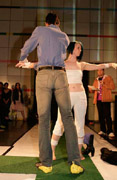
Stripping Away Our Liberty
random search--by ayah bdeir--is a subtle, reactive undergarment. It records, shares and studies the experience of invasive airport searches on behalf of our silent, abiding, fearful bodies. A thin suit, worn underneath clothes, is equipped with pressure sensors. Different pressure application results in stronger projection of that search process.
The first appearance of random search was at the Seamless electronic fashion show at the Media Lab. The focus of this prototype was on the behavior of the suit. As the inspector ran his hands and metal detector across the wearer’s body, the suit became a vehicle for the wearer to share the invasive experience she was going through. The suit served as the voice of the wearer, too nervous and worried to verbalize the feeling of physical and moral aggression. As touch and pressure was applied trails of LEDs were triggered, redrawing the pat down process on the traveler's body.
Posted by jo at 04:28 PM | Comments (0)
|yt_A [read: li:ta]

Distance Touch Generator
Touch, the most intimate of our five senses is often used as a reality-check; what I can touch is real. It is a proof that our bodies and the world around us remain anchored in the physical reality, that is currently engulfed with the mediated virtual/digital realities. Touch is an ultimately interactive communication method: the one who touches is simultaneously being touched. There is no subject-object relationship, no distance, no control, but a direct dialogue. |yt_A aims at reconnecting these the physical with the digital through touch and the usage of tactile media and haptic technologies.
|yt_A is an artwork, an instrument and a translation medium in one. It is a flexible structure that can transmit haptic information on a distance: when the structure is touched on one site, the touch will be visible and touchable on another.
The installation has two identical but mirrored parts which placed 100 metres from each other on the concourse of Phaeno, the newly developed Science Centre in Wolfsburg, Germany. Placing the two structures in distant locations will encourage the visitors to play with each other by manipulating the structures with their hands and bodies, and learning about each-other's shapes through touch. Furthermore, the visitors' touches will remain as shape-traces in the memory of the installation. In the moments of low activity, the installation will bring the traces back to the surface of the structures. |yt_A's software will use the visitors' traces to create new shapes and body-forms: the traces will be mixed, transformed and grown, as if the visitors' touch has 'fertilized' this anorganic form that became alive and autonomous.
The core team of |yt_A are Joris Bois, Nik Gaffney, Lina Kusaite, Maja Kuzmanovic, Steven Pickles, Todor Todoroff and Yon Visell. The fabrication of the force feedback mechanism is developed in collaboration with Merlin Systems Corp. Ltd. |yt_A is commissioned by Phaeno Science Centre and Stadt Wolfsburg.
Posted by jo at 01:37 PM | Comments (0)
Real-life video games

Faux Kidnappings
Artist Brock Enright is notorious in the US as the man who performs "bespoke executive kidnappings" for $1,500 a time. Every abduction is tailored to the phobias of each "victim" to offer "maximum terror". Enright's activities reach beyond acts of abduction, his Video and Adventure Services company to offer tailormade products that shamelessly explore personal perversions.
While kidnapping dominates perceptions of his company, VAS offers a host of "customised reality adventures", or real-life video games. "Some people are lonely and want to make friends," says Enright. Some people want to be stalked, others want "to feel like they're slowly going crazy". After drawing up legal contracts detailing what they can and can't get away with, VAS bring these fantasies to life, with the help of actors and locations. His Raising Dead Mothers show is at the Vilma Gold gallery, London E2, until October 16. [The Guardian].
Reminded me of Kidnap. In 1998 Blast Theory launched a lottery in which the winners had the chance to be kidnapped. Ten finalists were chosen at random and put under surveillance. Two winners were then snatched and taken to a secret location where they were held for 48 hours. The whole process was broadcast live onto the internet. Online visitors were able to control the video camera inside the safehouse and communicate live with the kidnappers. During the run up to Kidnap, a 45 second video - the Kidnap Blipvert - was shown at cinemas around the UK. The Blipvert carried a freephone number, allowing people to register their interest. [blogged by Regine on we-make-money-not]
Posted by jo at 12:52 PM | Comments (0)
Touch

Exploring User Centred Applications for NFC and RFID
Touch is a research project at the Interaction Design department at the Oslo School of Architecture and Design. Touch takes a user-centred approach to Near Field Communication (NFC). NFC is a technology that enables connections between mobile phones and real-world objects: bridging the gap between the real and the virtual. The project offers the possibility of radically simplifying existing applications and providing a new spectrum of local services through the mobile phone. At AHO we have multiple disciplines, including interaction design, industrial design, urbanism and architecture; a group with significant interest in the areas possibilities of NFC technology.
Posted by jo at 11:11 AM | Comments (0)
Screen Play

Video as Musical Score
Eyebeam and PERFORMA05 will co-present the premiere of Screen Play, a new work by visual artist and composer Christian Marclay, consisting of a video and three live musical ensembles. Marclay created the video to serve as a score to be interpreted live by a series of invited ensembles. The performances will take place on November 11th at 7pm at Eyebeam, 540 W 21st Street. Tickets are $15 for general admission, $10 for Eyebeam members and students, and may be purchased online through the PERFORMA05 web site.
Marclay was the recipient of the 2005 Moving Image Commission, creating the video score Screen Play in Eyebeam’s Production Studios. The projected element of Screen Play is a combination of found film footage overlaid with computer animation. Marclay chose footage suggesting certain visual rhythms and emotions, which he then worked to accentuate or underscore elements with overlapping computer graphics. The resulting video- reminiscent at moments of a silent film and at others of a flight simulator- becomes the visual score for musicians to interpret live. Musicians leading ensembles during this premiere will include multi instrumentalist Elliot Sharp, the electronic trio TOT- (Tim Barnes, Toshio Kayiwara, and Okkyung Lee) and composer and electric harpist Zeena Perkins.
Christian Marclay: Marclay is a New York based visual artist and composer whose innovative work explores the juxtaposition between sound and vision. Since 1979, Marclay has been experimenting with sampling both visual and audio elements, experimenting with composing and performing to create his unique “theatre of found sound.” He has shown extensively nationally and internationally including solo shows at the Tate Modern, the Hirshhorn Museum and the Venice Biennial.
Performing Ensembles: Zeena Parkins , multi-instrumentalist, improviser, composer, sought after in European and North American 'other music' circles. She is not only one of the pioneers of the electric harp but a composer with a unique vision of how to meld acoustic and electric processes.
Composer/multi-instrumentalist/sound-artist Elliott Sharp pioneered the use of fractal geometry, chaos theory, and genetic metaphors in his algorithmic compositions as well as the use of computers in his improvisation and performance. Sharp has collaborated with influential artists and musicians of many genres as well as producing his own sound sculptures. In addition to creating soundtracks for feature films, Sharp has produced numerous CD’s including his most recent, "Radio Hyper-Yahoo" [zOaR], a collection of collaborations with writer/performers.
TOT Trio- Tim Barnes, Toshio Kayiwara, and Okkyung Lee: Tim Barnes’ drum and percussion work transverses a varied musical terrain. From the 90's as a member of the free folk outfit Tower Recordings to conceptual textural electronic music with Dean Roberts. In 2000 Barnes produced a cd of solo percussion music called All Acoustics. Since then he has traveled and performed extensively in Asia and Europe playing with a range of free players and rock musicians.
From central Tokyo, turntablist Toshio Kajiware, studied photography before beginning in the 90’s to perform improvised music. His obsession with obscure music led him to collaborate and perform extensively. Currently he is a producer for his own label and event series entitled "phonomena.”
A native of Korea, Okkyung Lee used her classical training in cello as a springboard from which to incorporate jazz, sounds, Korean traditional music and noise with extended techniques. In addition to participating in TOT Trio, solo performances, and leading her own ensembles, she collaborates with artists, dancers and choreographers. Her latest album is titled Nihm (TZA 7715) and was produced by John Zorn's Tzadik label.
PERFORMA: Established in April 2004 by performance art historian RoseLee Goldberg, PERFORMA is a nonprofit interdisciplinary arts organization committed to the research, development, and presentation of performance by visual artists from around the world. The organization is founded on a commitment to education, history, and active investigation, bringing diverse audiences, artists, curators, and educators together in new and innovative ways. PERFORMA will commission new performance projects in visual arts, establish a dedicated performance biennial, and provide year-round educational programming for expanding knowledge and understanding of this critical area of visual art and cultural history. Each biennial will include the premiere of a major commission, new visual art performance produced by PERFORMA, performance-related film and video programs, and related educational programming.
Screen Play is made possible with support from Eyebeam’s Moving Image Commission and Highbrow Entertainment.
Posted by jo at 09:45 AM | Comments (0)
October 13, 2005
LiveMarks

Live del.icio.us Bookmarking
"Imagine if you could see the most popular links and most recent bookmarks live."--Alex Bosworth, LiveMarks.
LiveMarks is a project to show del.icio.us bookmarks live. On the left of LiveMarks you can see most recently popular bookmarks. On the right, del.icio.us bookmarks scroll by as people bookmark links on del.icio.us. Clicking on .oO links launches them in a new browser window.
Posted by jo at 11:56 AM | Comments (0)
Empathy Vest

Being There
Is it possible to sense the effect of being there without physically being present? Leah Heiss developed the Empathy Vest to investigate remote sensing and Spatial Empathy ("the development of an implicit understanding and awareness of the spatial condition that another being is experiencing.")
The garment allowed for the transmission of data that was converted into sensory affect. Two touch sensors and one voice relay sensor, gave the wearer a sense of experiencing informational stimulus mapped onto the body through the output modes – 4 x light channels and 1 x fan. These sensory impacts on the body questioned whether the fact that the wearer can feel the physical stimulus could make him/her develop an empathic connection with the remote space or person(s) from which the signals were being received. Image source. [blogged by Regine on we-make-money-not]
Posted by jo at 11:47 AM | Comments (0)
City Streets Transformed

Stories come to life in San Francisco experiment
We call this 'narrative archeology', because we're peeling back the layers of the neighborhood.
"Artists, writers, educators and others convening for this year's Digital Storytelling Festival in San Francisco will have the opportunity to participate in a unique storytelling experiment that uses emerging technology to merge the digital and physical worlds.
The experiment, called Scape the Hood, will transform a few seemingly drab city blocks into a landscape rich with sound, sights and stories. Using GPS-enabled HP iPAQ Pocket PCs and a location-based software platform developed by HP Labs, participants will be able to walk around the neighborhood and learn about its history and culture -- and about impending changes to its character.
Artists, mayonnaise and the ice cream truck
Over the course of four days beginning October 7, festival-goers may learn about how a painter's memories of his mother's death inspired a mural, or how artists transformed a canning plant into one of the nation's first live/work spaces or how a vibrant flea market brings together a diverse community.
Participants may hear the gurgle of a creek that ran where a street now lies or the jingle of the ice cream truck or the sound of trains that once carried corn oil to a mayonnaise factory that has since become a Starbucks.
"These stories aren't obvious from the streets," says Abbe Don, a researcher at HP Labs and executive producer of the project. "We call this 'narrative archeology,' because we're peeling back the layers of the neighborhood."
Previous HP Labs experiments
Scape the Hood follows on earlier HP Labs work on pervasive multimedia experiences. Working as part of the Mobile Bristol project, a test bed for technology and user research in mobility and future mobile services, scientists in HP Labs Bristol (UK) have recreated a series of these experiences including what is believed to be the world's first global positioning system "radio play."'
Researchers in Bristol, working with partners from Bristol University, developed the software used in Scape the Hood to place media files, such as sounds and images, in a location to blend in and augment a physical area. Associated software, loaded on to HP iPAQ handheld computers equipped with GPS satellite positioning, allows the user to access automatically the different media files as they move from place to place. An Open Source version of the software is available from Mobile Bristol.
Digital Storytelling Festival
Scape the Hood will take place on the streets surrounding KQED Public Broadcasting, which collaborated on the project through its Digital Storytelling Initiative with HP and a group of San Francisco Bay Area artists, storytellers and technologists including representatives from Antenna Theater, the Project Artaud artists' cooperative, San Francisco State University. The project was supported with a grant from HP.
The Digital Storytelling Festival, this year celebrating its 10th anniversary, aims to promote and evolve the art and practice of digital storytelling, offering workshops, panel discussions and speakers. KQED is the premier sponsor and host of this year's festival.
For more information, see the Digital Storytelling Web site." -- Jamie Beckett, Oct. 2005, Hewlett-Packard.
Jamie Beckett is managing editor of the HP Labs Web site and a veteran newspaper reporter and editor.
Posted by jo at 11:35 AM | Comments (0)
Inside

Brain Wave Projections of Dance Performers
At the September Ingenuity Festival or Art and Technology in Cleveland, Ohio, MorrisonDance performed a work, Inside, that integrated projections of real-time EEG (electroencephalograph) brainwave readings of the dancers and a pre-recorded video of Sarah Morrison's arthroscopic elbow surgery. For the brain reading component of the performance, Morrison wore a brainwave-reading FlexCap developed by BrainMaster Technologies. [Posted by Doug Fox on Great Dance]
Posted by jo at 11:06 AM | Comments (0)
blinkenlights 2.0

Display your own Animations or play Tetris, Pong or Pac Man
the truly impressive blinkenlights seems to be finally running again for the next 2 weeks at the Alexander Platz in Berlin. blinkenlights is basically a huge 18 x 8 pixels monochrome screen based on computer-controlled lights that are placed behind each of the windows of a small skyscraper. users can create their own animations to be displayed, play Tetris, Pong or Pac Man against each other in real time via their mobile phone (call 0190-987654) or install a small software program to play via their computer instead. don't forget to watch the documentary movie to truly appreciate its effects. see also enteractive & internet facade. [via infosthetics]
Posted by jo at 10:18 AM | Comments (0)
Map to Sine
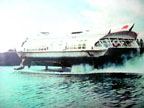
Cartiographic Translation in Sound Experienced by Russian Hydrofoil
Map to Sine is a two-part project by South African artist James Beckett (1977) as part of the international exhibition of contemporary art ADAM, produced by SMART Project Space. Map to Sine is a series of translations from image (cartographic) to sound, based on much of the fascination and formal study of the German Serialist musicians. Exercise such as the rotation of musical pattern, the arbitrary expansion of spacing and the imposition of shape applied directly from nature all formed part of their practice.
With the generous support of the transport company Connexxion, Beckett will host passengers to a live translation of surrounding information of the North Sea Canal, aboard a Russian Hydrofoil - a water rocket of eighties design. The Bulgarian performance artist Zhana Invanova (1977) offers a live explanation of the system in both Russian an English for the benefit of an educational composition.

Dates: Friday 14th, Saturday 15th, Sunday 16th October 2005; Times: Leaving Amsterdam 15:00hrs; 16:00hrs; 17:00hrs; Where do you catch the boat? Connexxion fast service between Amsterdam and Velsen-South (direction IJmuiden); Departing behind Amsterdam Central Station, just to the left of the ferry which crosses the North-Sea Canal; 25 minutes there, 25 minutes back. For more information: www.connexxion.nl
Posted by jo at 10:18 AM | Comments (0)
Towards Tag Poetry

Organic Data Clouds
"...In general, however, the tags tends to be a second-order supporter of digital art, not the focus. I have not yet seen a poem or a short story written entirely in tags. There are some intriguing possibilities - for example, TiddlyWiki supports tagging of individual entries in a way that might help the development of tagged wikifiction - but so far the artistic excitement and energy around tags seems to be around the infrastructure enabled by them or the data visualization techniques built on top of them, not making specific statements through them.
There are however a few examples of writing with tags, rather than above or around them. One is the header of We-Make-Money-Not-Art, which uses a tag-cloud navigation display in lieu of a subtitle, tagline, about blurb, or anything describing what the site is and what it does. The tag cloud is an organically changing navigation tool, and it is the description of the site as well. (There may be a other sites which do this, or even did it first - I’m just not familiar with them)..." Read full post >>
Posted by jo at 08:42 AM | Comments (0)
October 12, 2005
CYHIST/Community Memory:
Discussion List on the History of Cyberspace
The purpose of Community Memory: Discussion List on the History of Cyberspace is to create an oral history of cyberspace meaning the discussion of the history of computers, computer networks, and related technologies.
This archive contains unique first-person recollections from people who were active in building the Internet and its precursor networks, such as Arpanet, and myriad other networks and computers, dating back to the 1940s. The purpose of this archive is to serve future and present scholars and researchers interested in the history of cyberspace. For this reason, you are widely invited to store this archive of messages and make it publicly available via the Internet for people to search and retrieve the posts contained herein.
To ensure that this archive exists in perpetuity, please copy and duplicate and circulate to others, so that several copies may exist online. The wider it spreads, the more likely it will survive over time. Ideally, this entire archive would be placed online and made accessible through a searchable web-based interface, and indexed, in turn, by additional commercial search engines. Libraries are invited to add this archive to their digital collections.
The list is known as "CYHIST" and ran on two different listservers. The first listserver is cpsr-history[at]cpsr.org; that listserver handled messages from June 4, 1996 until August 15, 1996, when it was shut down. On August 13, 1996 all subscribers were shifted to a new listserver known as cyhist[at]maelstrom.stjohns.edu Searchable archives of the cpsr-history[at]cpsr.org messages are available at: http://www.memex.org/community-memory.html
Searchable archives of the cyhist@maelstrom.stjohns.edu messages can be found at: http://maelstrom.stjohns.edu/archives/cyhist.html. More.
CYHIST is a Center for Literary Computing project.
Posted by jo at 05:31 PM | Comments (0)
Placing Voices
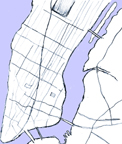
mobile-sound-blog
Voices of strangers heard in passing are key threads in the fabric of urban experience, subconsciously coloring our perception of a place. Yet such features are inherently unrepeatable, unique to every individual's listening experience, and, unlike a photograph, the location of a recording is difficult to recognize. Placing Voices, by Brian House, is a mobile-sound-blog software which uses the built-in sound recording feature of mobile phones (which is optimized for voice) and MMS messaging to place these fragments on a web-accessible map of the city as they occur. The objective is to express a map in terms of these experiences, to restore some claim to my memory of physical spaces over the transient voices heard within them.
Posted by jo at 05:03 PM | Comments (0)
Locative Space:
Situated and Interconnected
Locative media refers to a mobile media movement in which location and time are considered essential to the work. As locative blogger extraordinaire Thomas Angermann of Angermann2 say in response to a post to Mapping Hacks by Schuyler Earle, "at one level, thinking ‘locative’ means doing geo stuff without actually having learned the traditional geo toolsets [read, geographic information systems (GIS), ED]".

From a term proposed originally at an obscure workshop in the Baltic several years ago locative media now gets 220,000 hits currently on Google. On any given day a steady stream of locative projects are documented in blogs such as Networked Performance and We Make Money Not Art. Critical theory has however come out against locative media.
In his "Drifting Through the Grid: Psychogeography and Imperial Infrastructure" published in Springerin, Brain Holmes' advocates "conceiv[ing of] the worldwide communications technologies as Imperial infrastructure". According to Holmes, since GPS satellites are controlled by the US Army, "when you use locating device...: you are interpellated into Imperial ideology." While traditionally maps may have been a a form of visual knowledge generated by and for Imperial ideology, new practices of information technology begin to open up the practice of mapping to civic society. A great number of projects beyond locative media are working to Make Things Public. The idea here has to do with making the flows of Networked Society visible and transparent.
Perhaps the locative project par excellence is MILK, winner of this year's Golden Nica at Ars Electronica. With MILK, the artists, Esther Polak and Ieva Auzina, used GPS traceroutes to create a form of landscape art for network society. MILK is based in part on a project by Polak and the Waag Society, "Real Time Amsterdam" in which Amsterdam bicyclists created a map of city's bizarre traffic routes by the sedimentation of their GPS transponders over a period of weeks. Polak's latest work connects Manuel Castells's "space of flows" with his "space of place" by tracing the path of an agricultural product, in this case milk, from its origins in rural Latvia to a cheese vendor in the Netherlands.
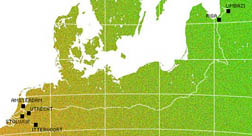
MILK suggests a powerful vision of locative technologies which allow one to trace the origins of foodstuffs—a much sought after ideal in this era of global mega-viruses—thereby making visible the networked society. I believe it was this reading of MILK that drew Bruno Latour to include the project in his ZKM exhibition "Making Things Public."
To be fair, the MILK project's artists are not interested in Latour's reading, seeing their work more as a form of romantic landscape art, indeed when making the project they came to a fork in the route that led in one direction to McDonalds and in the other to the Dutch cheese show, they chose the former. Nevertheless, Latour's reading is the one that interests me here and I am looking at MILK's as emblematic of that condition, regardless of the project's intent.

A different project at Latour's exhibition, Issue Crawler, suggests to me another dimension by which we could map the Network Society more effectively. Issue Crawler maps of the hyperlink structure around debates on the Internet, allowing us to see all of the actors in a particular network and how they relate to one another, much as in a Mark Lombardi drawing. This potential project would, then, combine Issue Crawler's situational analysis with the locative analysis of MILK. Where MILK suggest a notion of space from here to there, Issue Crawler develops a more relative notion of location in reference to. To really determine one's "locativity" it would surely be necessary to consult both of these perspectives.
In a CTheory article entitled "Operational Media", Jordan Crandall speaks of the "resurgence of temporal and locational specificity witnessed in new surveillance and location-aware navigational technologies". The Minority Report vision of the future, of which we are constantly reminded by MIT is suppoised to be one of smart objects with IP addresses communicating with us, with one another. and with "everyone else". Here the question of location becomes crucial. My tracklog and my social network amount to a marketer's dream. To know where I am, is to know how to sell [to] me. This has led critics like Holmes and Crandall, to accuse locative media of being, in, another critic, Andreas Broekman's terms , the avant garde of the Control Society.
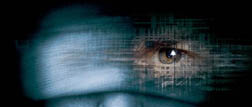
In Giles Deleuze's Society of Control thesis (L'autre journal, Nr. I, Mai 1990), "[w]e are in a generalized crisis in relation to all the environments of enclosure." Deleuze states "Enclosures are molds, distinct castings, but controls are a modulation... that will continuously change from one moment to the other". For Deleuze "The family, the school, the army, the factory are no longer the distinct analogical spaces...". "[E]veryone knows that these institutions are finished..." states Deleuze "it's only a matter of administering their last rites...". According to Crandall, locative media is implicit in a "machine-aided process of disciplinary attentiveness, embodied in practice, that is bound up within the demands of a new production and security regime." Yet, as Deleuze states, "there is no need to fear or hope, but only to look for new weapons".
According to Bruno Latour: ""Things" are controversial assemblages of entangled issues, and not simply objects sitting apart from our political passions. The entanglements of things and politics engage activists, artists, politicians, and intellectuals. To assemble this parliament, rhetoric is not enough and nor is eloquence; it requires the use of all the technologies -- especially information technology -- and the possibility for the arts to re-present anew what are the common stakes." As a locative artist, I envision a practice of networked technologies that might convert Crandall's "machine-aided process of disciplinary attentiveness" into new civilian tactics. [blogged by Marc Tuters on netPublics]
Posted by jo at 11:46 AM | Comments (0)
Sold Out
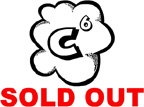
DiY Survival
For four days in Shoreditch c6 present SOLD OUT a series of lectures, art works and live events, in a shop-front showcase of challenging, innovative interactive art. Each day sees a different exhibit installed into the gallery accompanied by a presentation from the artists and an evening program of music and visuals.
C6 return to London bringing with them Want & Need, currently touring Europe, their latest software release Echo, as well as the launch of the “DiY Survival” Handbook. A program of daily events sees collaborations, exhibits and shows by friends C6 have made upon their travels. C6 create participatory art in multiple arenas, often linking the street (graffiti, stencils) with the web using mobile phones and portable devices, software art and innovative marketing strategies of media intervention to reach new audiences and communities.
Whether you drop in to use the wireless network, play with the sms art works, watch the bands, collect your free copy of “DiY survival”, listen to the web radio or do all of the above. SOLD OUT promises to be a show that no one should miss.
Posted by jo at 11:26 AM | Comments (0)
Breaking the Game
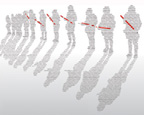
Gaming in Relationship to Designing, Building, Navigating and Experiencing Cities
Workspace Unlimited is currently organizing Breaking the Game, a series of interdisciplinary workshops and online symposium that bring together competing theorists and practitioners to build, debate and reflect on virtual worlds, computer gaming, immersive technologies, and new possibilities for artistic practice and experience. Taking place both online and offline, the workshops will open up the art of game modification to the contingencies of everyday life, where virtual technologies increasingly mediate physical spaces and human movements in very complex and dynamic ways.
Networked across multiple cities, the symposium will be organized around three core themes: "Hybridity", "Overclocking the City" and "The Virtual as Interface to Self and Society." Participants will consider gaming and other virtual technologies in relationship to building and designing cities, navigating and experiencing urban life, constructing identities, and creating and maintaining social interaction.
Architects, visual artists, filmmakers, choreographers, anthropologists and curators will consider how these technologies and associated audio/visual cultures impact the work and ideas of their disciplines. For example, how might anthropological fieldwork and ethnography change if its practitioners had to create a 3D virtual world rather than an essay or a book; if anthropology's disciplinary object was an updatable, media-rich, networked, and navigable space, rather than a text? How might online gaming and modification continue to challenge and expand the boundaries of filmmaking and public performance? How could the design and implementation of a "real" building have an ongoing relationship to its networked and virtual double? Can a public's social interactions, exchanges, and modifications inside a virtual building impact the meaning, form, and function of the same building in real space? Breaking the Game hopes to inform and newly challenge the efforts of a growing community of artists and designers who mine the resources, code, and aesthetics of video games.
Finally, Breaking the Game will ask: How might the symposium itself become re-mediated as a 3D networked virtual world? How can we play with, think about, and continue to debate the workshops' themes inside this space, using the language, tools, protocols, software, and interactive possibilities of gaming culture and technology? In order to accomplish this, select participants will be encouraged to explore their ideas in other media (a webpage, movie, animation, performance, a piece of software, or a series of digitally recorded interviews). Workspace Unlimited will integrate these digital artifacts into a new virtual world, created in collaboration with a core team of students and practitioners. As a final challenge, the team will lead the last workshop session inside a 3D world, networked across several cities with participants from Rotterdam, Belgium, New York, Seattle, and elsewhere.
About Workspace Unlimited
Workspace Unlimited, founded in 2002 by Thomas Soetens and Kora Van den Bulcke, explores the creative potential of multiplayer game technology in relation to digital art and architecture. The collective focuses mainly on immersive environments, experience design, hybrid space, information architecture and networks. Their main project, Virtual World of Art (VWA), is a series of networked virtual environments connected to different new media centers in Europe and North America: the Society for Art & Technology in Montreal, the V2_Institute for the Unstable Media in Rotterdam and the Vooruit Kunstencentrum in Ghent.
Workspace Unlimited has invited New York curator Wayne Ashley to collaborate on and help organize Breaking the Game. Previously he was the Programs Director and Curator at Lower Manhattan Cultural Council, and from 1999 to 2001 was Brooklyn Academy of Music's (BAM) first Manager of New Media.
To find out more about the ongoing work of Workspace Unlimited please visit: http://www.workspace-unlimited.org
Posted by jo at 11:16 AM | Comments (0)
KISSS Melbourne

products, process and residues
KISSS [Kinship International Strategy on Surveillance and Suppression]: A touring exhibition of products, process and residues from the meta performance project KISSS; Conical Gallery Melbourne, Australia; 28 October – 13 November 2005.
Responding to political, social and personal issues around surveillance and suppression, KISSS incorporates the individual and collaborative practices of artists, writers and curators.
KISSS includes Anne Bean, Camilla Brueton, Season Butler, Joanna Callaghan, Daedelus, Dolores Sanchez Calvo, Alexandra Dementieva, Deej Fabyc, Coco Fusco, Maxine Hall, Melanie Jackson, Calum F.Kerr, Maria Kheirkhah, Paula Moss, Psychological Art Circus, Sara Raza, Suzana Rezende, Elvis Richardson, Eva Rudlinger, paula roush, Nina Sobell, Hannah Terry, Emma Wolukau-Wanambwa and Reinhard Krehl, Silke Steets and Jan Wenzel.
KISSS was launched in August 2005 at the Whitechapel Gallery London where KISSS strategies were presented to a full house in a live, intermedia combination of performance, video, interventions and working sessions. An audience member observed how she appreciated ‘the range of material and approaches that were presented, from the very intimate to the political body, without being didactic’. This was followed in September by a SUMMIT, at an isolated country retreat in Somerset. A new piece of work Thomas’ Head was developed in response to the site, the historical archive and ideas of surveillance and suppression developed and enacted in public space.
KISSS is brought to Conical Gallery by London based Australian artists Joanna Callaghan and Deej Fabyc and co-curated with paula roush and Camilla Brueton.
KISSS
28 October – 13 November 2005
Opening Friday 28 October 6-9pm
Forum Saturday 29 October 2-5pm
A forum will take place on Saturday 29 October with Joanna Callaghan & Deej Fabyc in collaboration with local artists.
Conical Gallery
Upstairs 3 Rochester St
Fitzroy, Victoria
Australia 3065
Hrs: Thur & Fri 12pm-5.30pm
Sat & Sun 12pm-5pm
T: 03 9415 6958
E: info[at]conical.org.au
W: www.conical.org.au
kisss[at]elastic.org.uk
Posted by jo at 10:33 AM | Comments (0)
October 11, 2005
Glow Positioning System
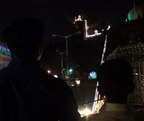
At the General Post Office, Mumbai
There are many ways to locate a city. One way is to distance oneself from it- to look it up in an atlas, a picture, or to go out to sea or up a hill to watch the twinkling lights, and point out the streets we know. Another way is to move within the streets themselves; to awaken the more proximate senses, to touch the city itself. The historical space between and across these two extremes is richly populated: by maps, movies, mondo nuovo, grids and drifts, 'oramas and 'oscopes, flaneurs, heterotopias, travelling shots and shooting travelers.
In recent times, Global Positioning Systems (developed originally for US military use) have allowed for an unprecedented connection between the mover and the map. GPS devices tell us where we are at all times, everywhere on the globe. Implying that we will travel, globally. In Glow Positioning System--by Ashok Sukumaran--a different kind of travel is implied. This is an interior voyage, a circular tourism of a place we know.
A 1000-foot ring of lights encircles the General Post Office intersection in Fort, Mumbai. The lights travel between buildings, across roads and onto trees and lampposts, forming an image-scape that is starkly visible at night. A hand-crank mounted on the pavement provides a way for the audience to "scroll" this landscape. It allows the physical length of the view to become a chronological one- to be viewed at a speed determined by the user.
The ring responds to panoramic desire, that age-old search for an image to immerse our selves in. From Cycloramas to VR (via the tradition of urban panoramas in painting and photography), the "surround view " has been a recurring element of urban and cinematic manifestos. Of course, the city surrounds us already. Here we just connect the dots, and look again.
In any city, various forms of lighting create a distinct nighttime experience - floating us away from from the concrete views of daylight. In India, this is a pervasive medium- think of Diwalis in the city, or weddings, for example. Chases, bursts and strobes provide moving effects, a vivid transarchitecture. "Chinese" string lights - they cost about $2 for 14 feet - have made a nighttime "presence" feasible for almost anybody. For this project, such lights (and others) were installed on the facades and rooftops (and sometimes interiors) of several homes , a real-estate office, a razor-blade manufacturer's office, a transit lodge, an abandoned bank, several shops and restaurants, and a 150-year old "heritage" structure (the GPO). Local lighting decorators I was working with designed and installed the lighting, in collaboration with home and office owners.
The lights are then connected in a virtual loop, which overlays the concrete urban architecture and the electrical grid. The hand-crank interface is mounted on the pavement near the Kabutarkhana (pigeon coop) . As you turn the crank, the lit part of the ring of lights moves, for example from the Kothari building onto the trees, or from one minaret to the next. Changing the speed of rotation causes variable persistence effects, both actual and perceived. A path of movement is traced upon the concrete city, and our heads turn to meet it. The crank mechanism itself refers to not only its specific history in the moving panorama, but also a general history of the moving image: as a driver for cinema. Like cinema, the experience does not depend on the observer being physically displaced. Yet there is the clear sense of an actual landscape, and the promise of a haptic journey.
This entire project is a kind of poetic infrastructure, a layer on top of the urban design and conservation Plans that define "inner city" precincts. In a playful and accessible way, it attempts to rewire the use-based definitions (post office, eating, shopping, etc) of this public space.
Glow Positioning System was commissioned for the Mumbai Festival 2005 by the Jindal South-West Foundation.
![]()
Ashok Sukumaran was recently awarded the main prize of the UNESCO Digital Arts Award 2005-"City and Creative Media".
Posted by jo at 05:11 PM | Comments (0)
Art Center Nabi + Seoul
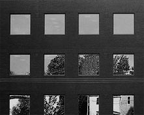
Urban Play and Locative Media
Emerging technologies such as wireless network, locative media, and pervasive computing have brought about new perceptions and social interactions in urban environment, transforming the ways we experience our cities. The concepts of space, time, and social relationship in urban environment are put in flux, while there are growing interests among communities of artists viewing city as social playground, public space, fluid canvas, and invisible layers of network.
Art Center Nabi is organizing an international workshop in partnership with the city of Seoul to initiate cultural and artistic projects exploring the theme of Urban Play and Locative Media.
On the cross platforms of art, design, technology, and social sciences, submissions are sought to deal with the issues of participation, play, process, and engagement in urban environment incorporating various locative and pervasive media technologies. We are looking for fresh and thought provoking insights and projects that are to reflect on but not limited to the critical issues as following:
-How new communication media opens up new ways to engage people in public domain?
-In what ways people participate and play in urban environment in dynamic formation of city?
-What kind of urban games are possible using emerging technologies? And what kinds of collective ‘vibes’ can be generated through these games?
-How can physical or virtual spaces in city be created, experienced and accessed by collaborative or competitive movement of people?
-How can diverse aspects of city whetollaborative or competitive movement of people?
-How can diverse aspects of city whether cultural, historical, social, or personal be reflected and shared through participatory gestures?
-How can disparate neighborhoods or different communities be linked, interact or confront in playful gestures?
* Area in focus: Myung Dong in Seoul
We are also initiating calls that manifest and explore diverse aspects of metropolis Seoul, specifically focusing on Myung Dong area. Myung Dong is one of the representative sites located in central Seoul with its historic background, highest land value and concentration of commerce and people. The city government is undertaking a major redevelopment plan that possibly includes new zoning and new IT infra, in order to make Myung Dong as the symbol of ‘New Seoul.’ For our purpose, Myung Dong can serve as a test bed in exploring the theme of ‘Urban Play and Locative Media’ with cultural and artistic approaches.Dong can serve as a test bed in exploring the theme of ‘Urban Play and Locative Media’ with cultural and artistic approaches.
More info on Myung Dong (in Korean):
http://www.myungdong.co.kr/md/main_down_1.html
Please contact us [urban2005[at]nabi.or.kr] to receive more information on Myung Dong in English.
Posted by jo at 04:57 PM | Comments (0)
Trigger
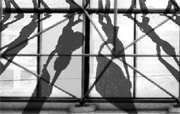
An Exploration in Visual Anthropology
Pace Digital Gallery is pleased to present Trigger by artist in residence Jody Zellen.
"(Trigger) is in a transitional space, a stairwell, where students and visitors walk energetically to the next class or office. People twist and turn as they ascend and descend, encountering new image experiences along the way. The process of navigating in real space, rather than within the space of a computer screen, also adds a playful element. The visitors become performance artists or dancers unintentionally interacting within this encompassing artwork. The outside world is further transformed by large-scale transparencies covering the windows. Instead of ecclesiastical imagery, these “stained glass windows” represent the iconography of the city. The pacing of motion within the space, ambient sound and continuously changing projections become an exploration in visual anthropology – a form of “Kinesics in Context” to use the title of an important text in that field. In the work Jody Zellen has been able to incorporate the spirit of transient experience exemplified by the web into a human space which will force visitors to pause and reflect before returning to their immediate mission. Perhaps during that pause they will give some thought to the larger question about where we are all heading as mediating experiences begin to dominate daily life."
Edward W. Earle, Curator of Digital Media, International Center of Photography, New York
Saccadic Streets: Jody Zellen’s Urban Exploration from the brochure essay
Trigger was produced in residence at Pace Digital Gallery in 2005, with the collaboration of Dr. Francis T. Marchese and Josh Rose, CSIS student, of The Center for Advanced Media at Pace University in New York City.
Jody Zellen is an artist living in Los Angeles, California who works in many media simultaneously making photographs, installations, net art, public art, as well as artists’ books that explore the subject of the urban environment. She employs media-generated representations of contemporary and historic cities as raw material for aesthetic and social investigations. Solo exhibitions include Laguna Art Museum (2004-05); Susanne Vielmetter Los Angeles Projects (2002); Deep River, Los Angeles (2001). Her net art projects have shown world wide since 1997 in festivals and exhibitions such as Arte Nuevo Interactive, Mexico, ACCEA International media festival, Armenia, Prog:me, Rio de Janeiro (2005); File, Brazil, Festival du Noveau Cinema, Montreal, Siggraph, Los Angeles, 404 International Festival of Electronic Art, Argentina, Cosign, Croatia (2004); New Forms Festival, Vancouver, Recontres Internationales, Berlin (2003); Whitney Museum Artport (2002); XXV Bienal de Sao Paulo (2002); Art Future 2000, Taiwan; Net_Condition, ZKM (1999); Film + Arch.3, Graz (1997).
exhibition October 18 - Novenber 8, 2005
Opening reception Tuesday, October 18, 2005, 6-8 pm
Pace Digital Gallery
163 William St, NYC
Tu - Fr, 10 - 6
info digitalgallery[at]pace.edu
details + map + directions
http://www.pace.edu/digitalgallery
directors
Francis T Marchese, CSIS
Jillian Mcdonald, Fine Arts
assistant director
Will Pappenheimer
Posted by jo at 04:46 PM | Comments (0)
Sensory Threads

Adding Sentient Knowledge to Machine Data
Sensory Threads aims to stimulate and inform a public debate on how personal biosensor data is collected and used in biomedical science. It will combine an artistic with an evidence-based approach, building and testing a prototype body biosensor network that uploads data to Urban Tapestries. This will allow participants to map experiential and emotional annotations to their readings – adding a whole new layer of sentient knowledge to machine data. It is intended to demystify how data is collected, what it produces and how we can correlate it to other factors affecting health such as environmental pollution.
By testing our ideas in real world situations we hope to investigate how empirical data collected from sensor readings attached to the body can be interpreted in a variety of different ways by different disciplines, revealing its limitations for healthcare applications and in the long term for the public. We aim to address the social, cultural, environmental and ethical concerns implied by the reliance on sensor data for understanding the complex interactions between the body and its environment...
Posted by jo at 03:19 PM | Comments (0)
Smart Artifacts
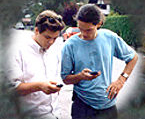
A Key Component of Pervasive Games
"Abstract: In this paper we present how smart artifacts can become a crucial element in pervasive games. In our vision, ‘magical’ artifacts play two roles: first, they are very attractive game gadgets (such as magic wands), second, they are able to handle the game (implementing the main game logic). We claim that in some cases no infrastructure would be needed to play a game. Artifacts, as we present here, are carried by players (or lying somewhere in the game area) and communicating through a wireless network. The vision has been inspired by a number of ideas and ongoing projects on smart devices and middleware platforms." From Smart Artifacts as a Key Component of Pervasive Games by Michal Roj; workshop paper for the Workshop on Gaming Applications in Pervasive Computing Environments 2004.
Posted by jo at 03:02 PM | Comments (0)
Picking Pockets on the Lawn:
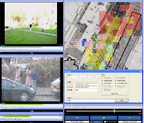
The Development of Tactics and Strategies in a Mobile Game
"Abstract: This paper presents Treasure, an outdoor mobile multiplayer game inspired by Weiser’s notion of seams, gaps and breaks in different media. Playing Treasure involves movement in and out of a wi-fi network, using PDAs to pick up virtual ‘coins’ that may be scattered outside network coverage. Coins have to be uploaded to a server to gain game points, and players can collaborate with teammates to double the points given for an upload. Players can also steal coins from opponents. As they move around, players’ PDAs sample network signal strength and update coverage maps. Reporting on a study of players taking part in multiple games, we discuss how their tactics and strategies developed as their experience grew with successive games. We suggest that meaningful play arises in just this way, and that repeated play is vital when evaluating such games." From Picking Pockets on the Lawn: The Development of Tactics and Strategies in a Mobile Game by Barkhuus, L., Chalmers, M., Tennent, P., Hall, M., Bell, M. and Brown, B.; Proceedings of UbiComp 2005, Tokyo, Japan.
Posted by jo at 02:54 PM | Comments (0)
virose.pt
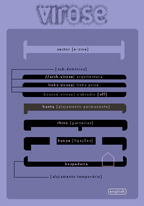
Portuguese Platform For Debating Art And Technology
Virose is a Portuguese, artist run platform dedicated to debating the relation between art and technology in contemporary societies. It was created in 1997 and since then has spread its reach. Nowadays it features an architecture department called arch.virose and publishes regularly vector, an open to participation e-zine that includes both theoretical and critical texts as well as new media art projects specifically made for Virose.
Another goal of this platform is to share its own resources and, for that, has room in its server for artists having difficulties in putting their work online. Two hosting departments are available: a permanent one, hanta, and hospedaria, for temporary hosting.
Virose is also responsible for arena, a discussion list about art and technology, and infovir, a mailing list informing its subscribers of Virose's own activities, news and projects.
Virose Organization, Porto, Portugal
Posted by luis at 01:24 PM | Comments (0)
Graveyard Games
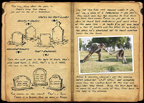
Playing Tombstone Hold 'Em
On Saturday October 15, 2005, Graveyard Games will be in Colma, San Francisco’s very own City of the Dead, so you can meet the living and play with the dead. You’re invited to the Italian Cemetery to get to know your local dearly departed, pay your respects, and learn Tombstone Hold ‘Em—the secret poker game you can only play in a cemetery.
Instructions: 1. Arrive at the Italian Cemetery (540 F Street, Colma, CA 94014, 2 blocks from Colma BART station) on Saturday October 15 between 1:30 PM and 2:00 PM. 2. Look for your host near the main entrance, under the white arch. She’ll be holding a deck of cards. She will have further instructions and supplies for you. 3. Bring a single flower to place on a grave to show some respect, and to signal that you’re one of us.
4. Take a few minutes to explore the cemetery. Look for any poker chips left on tombs. You’ll need these to play.
5. Be sure to look for the grave of someone you can prove died on your birthday. You can use that tombstone as a Joker during the game.
6. Tombstone Hold ‘Em Tournament begins at 2 PM. Here’s a tip: learn the rules before you come. We’ll have instructions on hand for any friends you bring along.
7. For non-poker players, there will be other creative, playful things to do. And expect a few surprises.
8. The winner is crowned at 3 PM. No fancy prizes, but lots of respect, and maybe a special memento from beyond the grave. Plus, everyone can keep the chips they earn as a souvenir.
9. After 3 PM, you’re invited to nearby Globe Tavern (7379 Mission St) to raise a glass to the players you’re leaving underground at the Italian Cemetery.
By the way, if anyone asks--you’re here for the last call. [posted by Jane on Avant Game]
Posted by jo at 09:19 AM | Comments (0)
October 10, 2005
Found Sound in D.C.
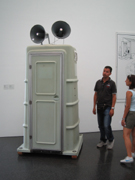
Crisscross a City
[Unrelated photo: a port-a-potty-based public address system at the MACBA, Barcelona, 2005.]
A public art project called FOUND SOUND will be featuring works from artists in sound booths (“reconfigured” Port-a-Potties) on sidewalks in public locations throughout Washington, D.C. from Oct 14-Nov 5. Participating artists include Richard Chartier, Joseph Grigely, Alberto Gaitán, Jennie C. Jones, Helmut Kopetzky, Brandon Morse, Robin Rose, and Alex Van Oss. Actor and part-time New Orleans resident Harry Shearer (The Simpsons, Spinal Tap, HuffPo) is contributing a piece on Hurricane Katrina, and Calvin Trillin has contributed a poem as well. The press release quotes this from an essay by Nora Halpern at Americans for the Arts:
FOUND SOUND entices the listener to crisscross a city to experience fully this collection of work. As one leaves a destination for another—whether by foot, car, bus, or Metro—the heightened audio awareness encouraged by each piece should continue, like a musical riff, through all the spaces in between.
That’s great and all, but in most of the places where these will be, “heightened audio awareness” might not be a good thing. Downtown D.C.’s not known for its street life — but we have plenty of nice, loud traffic and construction. Maybe they should make a podcast available for walking in between. Local galleries including Fusebox, Conner Contemporary Art, the Goethe Institute, and DCAC are collaborating. No map seems to be available yet but we’ll link when it turns up online. No word on whether any of the port-a-potties will be performing their originally intended public service as well, but consider it highly unlikely. [blogged by Tim on shey.net]
Posted by jo at 06:36 PM | Comments (0)
The Power of the Mind 2
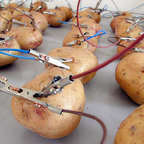
I Hear Denmark Singing
The Power of the Mind 2/I Hear Denmark Singing--by Mogens Jacobsen--takes a song by the Danish Minister for Refugee, Immigration and Integration, Bertel Haarder, as the point of departure for a political comment. An unstable online version of the song is connected to the physical installation that consists of a web server with a transcription of the interview and an electric network of a couple of hundred potatoes (the Danish national food). When the potatoes begin dry out or sprout his stupid song gradually disappears as a sign of fading memory and the text is replaced by heart shaped symbols. See Power of Mind/Memory and TURNTABLISTPC.
Posted by jo at 06:12 PM | Comments (0)
The Cloud Harp
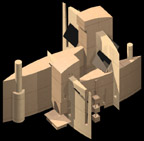
Cloudscapes
The Cloud Harp is a meteo-electronic installation that converts real-time, thanks to an infra-red laser beam and a telescope sharing the same optics, the height, density and structure of clouds into sounds and musical sequences. The melodies and sounds are determined by factors such as cloud height, density, structure, luminosity, and meteorological conditions. Each cloudscape produces a particular kind of sequence. The Harp is polyphonic : it can sing on many different voices simultaneously, each one being mapped on a specific altitude range. It sings 24 hours a day, 365 days a year, by any weather. When the sky is blue, it remains silent. The range of the instrument is 25 000 feet or 8 kilometers, which means that some high stratospheric clouds, such as cirruses, are not detected.
On a technological point of view, the Harp is similar to a giant CD player, turned upside down. In compact disc technology, a small lens captures a tiny laser beam modulated by microscopic holes on the surface of the disc; a decoding system converts the modulations into music or sound. Here, the small laser beam is replaced by a large infrared one; the lens is replaced by a telescope; the role of the compact disc is played by the cloud itself.
The Cloud Harp is also known as the Keplerian Harp, after the German astronomer Johannes Kepler, who was one of the first, with his "Music of the Spheres", to attempt the transposition of a natural phenomenon into music.
Posted by jo at 03:47 PM | Comments (0)
I, Piano

You're Playing Me!
When I saw this "hand roll piano" with a MIDI interface at King's Idea Shop in Shinjuku earlier this year, I just thought it was a neat idea. But, Professor Tsukamoto of Kobe University and his team had a much wilder idea about the use of similar flexible piano devices. They came up with this idea of a wearable piano, showed it off at a wearable computing fashion show in Japan last year, and presented a paper about it at a conference last month.
Someone says a next step of this could be a wearable orchestra with many other wearable musical instruments. I'd think of it more like a tool for participative improvisation jam sessions. Related: Paper Piano; Wearable Halfkeyboard. [blogged by manekineko on we-make-money-not]
Posted by jo at 03:36 PM | Comments (0)
Ballettikka Internettikka:
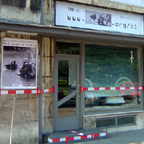
BEO Guerrillikka in Belgrade
Ballettikka Internettikka: BEO Guerrillikka [Bureau NetBallet] by Igor Stromajer & Brane Zorman (Belgrade, Serbia, 2005) (live internet broadcasting); Thursday, Oct 13th, 2005 at 9 PM GMT+1 (Berlin/Paris/Belgrade local time); Duration: 20 minutes (time tolerance: +/-4 minutes); Location X, Belgrade, Serbia; # Latitude: 44.79345 N, Longitude: 20.45340 E, Terrain Elevation: 110 m; Location will be made public on Oct 13th at 8:50 PM GMT+1 (10 minutes before the performance starts; due to security reasons).
Ballettikka Internettikka is an ongoing artistic study of the internet guerrilla performance. After invading the Bolsh.oi Theatre in Moscow (March 2002), and La S.cala in Milan (November 2004), Stromajer and Zorman will perform a new guerrilla net ballet, this time in another theatre house in Belgrade, Serbia.
Live internet broadcasting of the net ballet performance will start on October 13th 2005 at 9 PM GMT+1 and will last 20 minutes (+/- 4 minutes); the location will be made public on Oct 13th at 20:50 GMT+1 (10 minutes before the performance; due to security reasons).
They will enter the office (brain center) of the Artistic Director [location X], here the hardest artistic decisions to run the institution are taking place. The artists will use remote-controlled toy-robots with wireless web cameras.
Watch and listen live to internet guerrilla bureau ballet at http://www.intima.org/bi/beo
(Oct 13th 2005)
Artists will use low-tech mobile and wireless equipment for the invasion and live broadcasting (portable computers, mini digital camera, MP3 audio systems, mobile GPRS telephones etc). A laptop and MiniDV cam, together with Webcam32 (version 6.0) software will be used for broadcasting the video signal (running over Intima Virtual Base FTP server). Another laptop and MP3 player with online interface SHOUTcast (version 1.8.3/win32), will be used for live sound broadcasting (running over Beitthron FTP server). A local GSM mobile phone operator will be used for GPRS mobile internet connection.
Action Timetable / Belgrade, Oct 13th 2005 / GMT+1:
20:55 Equipment check on the parking place in front of [Location X]
20:57 Turning the computers on
20:59 Establishing wireless Internet connection (GSM 900/1800)
21:00 Start of live Internet broadcasting (-2) and final equipment check
21:01 Entering the building of [Location X]; climbing the stairs--3rd Floor (-1)
21:05 Entering the office of the Artistic Director [X] (3rd Floor / left): (0)
starting live bureau net ballet (10 min)
21:15 End of live bureau net ballet: exiting the office; descending the stairs (+1)
21:19 Exiting the building of [Location X]
21:20 Terminating wireless Internet connection at the parking place outside
[Location X] and turning off the computers (+2)
21:22 Taking the taxi to the O3ONE Gallery
Dancing a wireless bureau net-ballet in the office of the Artistic Director location X] represents a big conceptual and strategic challenge to the Intima Virtual Base, therefore the preparations have been taken serious, safety measures have been calculated, and the previous experience from the Bolsh.oi Theatre in Moscow and La S.cala in Milan has been very welcome.
Ballettikka Internettikka: BEO Guerrillikka is supported by Municipality of Belgrade, Ministry of Culture of the Republic of Slovenia, Ministry of Culture of the Republic of Serbia, O3ONE Gallery in Belgrade.
Bureau NetBallet Operators: Igor Stromajer & Brane Zorman
Bureau NetBallet Composer: MC Brane vs. BeitThroN vs. Thronus Sound System
Theoretical Adviser: Bojana Kunst
Curator: Ana Vujanovic
Executive Producer: Jelena Knezevic
Computer Programming: SM NORT
Co-produced by Intima Virtual Base (Slovenia) and TkH Center for the Theory and Practice of Performing arts (Belgrade)
[] [] []
Ballettikka Internettikka was presented in noumerous galleries and museums of contemporary art worldwide (from 2002 to 2005) including Le Centre national d'art et de Culture Georges Pompidou - Musee national d'art moderne in Paris, 15. Stuttgarter Filmwinter in Stuttgart, Centro em Movimento in Lisbon, FILE 03 - electronic language international festival in Sao Paulo, Titanik Gallery in Turku (Finland), P-10 Gallery in Singapore, IMPAKT festival in Utrecht (The Netherlands), Thailand 3rd New Media Arts Festival in Bangkok, Cork Vision Centre - Cork Cultural Capital of Europe 2005 (Ireland) and CEC ArtsLink in New York.
[] [] []
About the authors:
Igor Stromajer
http://www.intima.org
is an mobile intimate communicator. He researches tactical emotional states and traumatic low-tech strategies. He has shown his work at more than a hundred exhibitions in forty-two countries and received a number of awards. His works are included in the permanent collections of the Centre Georges Pompidou, Paris; the Museo Nacional Centro de Arte Reina Sofía, Madrid; Moderna galerija Ljubljana, Slovenia; Computerfinearts Gallery, New York and others.
Brane Zorman
http://www.ljudmila.org/beitthron
is a composer and sound manipulator. Between 1982 and 1986 he was frontman for the Slovene punk group O!KULT. He is a pioneer of Slovene techno scene. Since 1987 he has been composing music for both Slovene and international theatre, dance and multimedia performances and projects. and has made guest appearances throughout Europe. Recently he works with Irena Pivka on a series of audio-visual installations ZONE.
Intima Virtual Base - Institute for Contemporary Arts
Belgrade: +381 64 4200614
Slovenia: +386 41 703291
igloo [at] intima.org
Posted by jo at 11:15 AM | Comments (0)
October 09, 2005
MEDIA ART NET

[Online Resources for Media Art]
A JOINT PUBLIC PROGRAM BY THE GOETHE INTITUT NEW YORK AND THE WHITNEY MUSEUM OF AMERICAN ART: DIALOGUE OCT 12, 7:30 PM; GOETHE-INSTITUT; ADMISSION: $10/8
Christiane Paul, adjunct curator of New Media Arts at the Whitney Museum of American Art, New York, will join Dieter Daniels, professor of art history and media theory at the Academy of Visual Arts, Leipzig, for a dialogue focusing on the groundbreaking project Media Art Net. The discussion will explore the project as a model for creating resources on media arts.
"Media Art Net" is an online "survey" with scholarly essays, accompanied by comprehensive audiovisual documentation on 940 artists and 1400 art works from the 1920s until today. The second part of the project is now available online and includes 8 key topics: Aesthetics of the Digital; Art and Cinematography; Cyborg Bodies; Generative Tools; Mapping and Text; Photo/Byte; Public Spheres; Sound and Image. A network of curators and writers explore seminal interfaces between media and art, presenting a variety of approaches and contexts. In addition artistic projects are commissioned for the online platform.
Selected essays are published in book form (Media Art Net Vol. 1 and 2) and the specific book design is linked with the online platform.
The project was commissioned by Goethe-Institut and the Center for Art and Media (ZKM), in cooperation with the Academy of Visual Arts, Leipzig. Financial support was granted by the German Ministry of Research and Education. Editors: Rudolf Frieling and Dieter Daniels.
Posted by jo at 09:49 AM | Comments (0)
October 08, 2005
MobLab
![]()
Japanese-German Media Camp 2005
[MobLab: Japanese-German media camp 2005]--A live art & communication project with young artists from Japan and Germany (MobNauts), who develop creative ideas with mobile technology while traveling Japan in a bus. Welcome to the mobile laboratory! 15 October, (Saturday) - 6 November (Sunday), 2005
MobLab ("Mobile" + "Laboratory", also "mob" = crowd, community, etc.) is the sum of projects proposed and developed by Japanese and German artists from various fields (=MobNauts) in a bus that, equipped with an array of digital mobile devices, functions as an information base. The time the MobNauts spend on the road will naturally lead to various creative collaborations. The bus travels to a number of host institutions throughout Japan, each of which hosts events that incorporate the bus and its passengers. At the same time, the MobNauts have the opportunity to exchange with local artists and other people. The flexibly set route allows for the spontaneous staging of events, which will be announced on the MobLab Website.
The bus is at once an intimate space in which the MobNauts spend time together, and a public space for transmitting global information. While traveling, the MobNauts will create occasions for individuals to meet, on both real and virtual levels, and connect to different local realities each time they stop and get out of the bus. MobLab aims to be a platform for practical experimentation in public born out of a revolutionarily "on-the-spot" form of meeting of individuals and media, and investigation into the possibilities implied by this public nature. The concept of dynamic information that interactively transforms by exchange between a variety of people has just begun to surface as a new layer of reality.
The MobNauts are artists from Japan and Germany who travel on a bus across Japan. These protagonists form the centerpiece of MobLab, as their respective projects developed with information networks and incorporating direct experiences with different realities and individuals unique to each station of the journey, will create a new sensibility to possible future directions for both society and urban spaces. A blog at Moblab website, written by the MobNauts, will give you insight to each MobNaut's experience. The MobNauts are also expected to engage in unique collaborations with each other.
*The latest action and contents will be updated at www.moblab.org, (also each artist has a blot), additionally the bus collect some data(temparature, humidity, GPS date, and other captured images) (bus as an interface) and these data will be provided on the web as an "open data", which will be used by any artists or creators for their furture creations, projects!
Feel free to contact us at:
info[at]moblab.org
for questions or information.
(This art project is part of Deutschland in Japan 2005/2006)
*Beside of the followings, the spontaneous staging of events will be announced on the MobLab Website.
Early October: Information system development and implementation, conversion of the bus in IAMAS, Ogaki
10/15 (Sat) MobNauts gathering at IAMAS
10/15 (Sat) - 10/18 (Tue) MobNauts camp
10/18 (Tue) eve party@IAMAS
10/19 (Wed) Seeing-off ceremony, travel from Ogaki to Tokyo
10/20 (Thu) Setting at NTT ICC
10/21 (Fri) NTT ICC(Bus parks at Tokyo Opera City)
10/22 (Sat) Fujino workshop for art (Kanagawa Pref.)
10/23 (Sun) Yokohama Triennale
10/24 (Mon) - 10/26 (Wed) Travel from Yokohama to Sendai
10/27 (Thu) Setting at Sendai Mediatheque, putting bus inside the building.
10/28 (Fri) - 10/30 (Sun) Sendai Mediatheque, The bus is displayed at ground floor
10/31 (Mon) - 11/2 (Wed) Travel from Sendai to Kansai
11/3 (Thu) Saito IMI Graduate School in Expo Park, Osaka
11/4 (Fri) Travel from Osaka to YCAM, Yamaguchi
11/5 (Sat) - 11/6 (Sun) YCAM, The bus is parked in front of the venue.
MobNauts (artists on the bus): exonemo(Yae Akaiwa + Kensuke Sembo), AGF, Sven Gareis, Daisuke Ishida + Ken Furudate, Stefan Riekeles Driver: Yosuke Kawamura (Artist and director of MOBIUM, www.mobium.org) Production assistant: Tomonaga Yamaguchi (MobLab)
The spontaneous staging of events: MobNauts will spontaneously stage events at many places apart from their individual project. We welcome anybody to attend this plan. Why not come along with your friends? Artists, painters and musicians are also welcome to help us for live performances and the painting of the bus itself!!
Host Institutions: The bus travels to a number of host institutions throughout Japan, each of which hosts events that incorporate the bus and its passengers. At the same time, the MobNauts have the opportunity to exchange with local artists and other people.
-Ogaki: IAMAS (Institute of Advanced Media Arts and Sciences + International Academy of Media Arts and Sciences) www.iamas.ac.jp
-Tokyo: NTT InterCommunication Center [ICC] www.ntticc.or.jp
-Sendai: Mediatheque /smt www.smt.jp
-Yamaguchi: Yamaguchi Center for Arts and Media /YCAM www.ycam.jp
Organizer: MobLab Committee, Goethe-Institut
Support: The Japan Foundation
Patronage: Embassy of the Federal Republic of Germany in Japan
Special cooperation: IAMAS, ICC, Sendai Mediatheque, YCAM, Transmediale
(Berlin)
Technical support: IAMAS (Institute of Advanced Media Arts and Sciences + International Academy of Media Arts and Sciences)
Support: Mobium, Yokohama Triennale, Fujino workshop for art, Saito IMI Graduate School
Sponsor: CAMPINGWORKS CO., LTD
MobLab Base:
Project director: Yukiko Shikata
Project manager: Miki Fukuda
Production assistant: Tomonaga Yamaguchi
Berlin Coordinator: Stefan Riekeles
Enquiries:
info[at]moblab.org
-------------------------
Posted by jo at 10:28 AM | Comments (0)
October 07, 2005
Make A Baby

Skin Conducts Music
Make A Baby, by Lucky Dragons, is an ongoing series of experiments into the possibilities of using skin contact between performers as a means of transmitting and controlling data and creating a positive social environment.
Using a knit and applique rug with woven circuits as the touch controller, audience members are invited to participate, building up and breaking down resistive networks by 'passing' signals from skin to skin. Measured changes in these networks are used to play a series of software instruments, allowing for spontaneous bands of touchers to crystallize and disperse all over the place, at once, over and over. Lucky Dragons - Make a Baby, October 7, 2005 8pm, Machine Project, Los Angeles. [blogged by Regine on we-make-money-not]
Posted by jo at 06:04 PM | Comments (0)
A Crystalpunk Workshop for Soft Architecture

Paskian Environments
A Crystalpunk Workshop for Soft Architecture: Paskian Environments, with Usman Haque and Adam Somlai-Fischer; Tuesday, 18 October 2005; 20.00-23.00
Gordon Pask (1928-1996) was a cyberneticist and a crystalpunk long before the latter movement existed. Cybernetics, its founder Norbert Wiener defined it as "the science of control and communication, in the animal and the machine", fascinates us for its broad general view on things. The willingness to take up almost any subject and to study it in earnest for what it is, bears witness to a curiosity that is hard to find in most of today's science and art.
Cybernetics was a theory of machines, but working from a notion of machines which constitutes every system which produces determinate behaviour: thermostats, humans, mathematical functions. Each machine was treated as W. Ross Alby puts it: "by asking not 'what individual act will it produce here and now?' but 'what are ALL the possible behaviours it can produce'".
Within such a science of possibilities, each machine is a generative system producing behaviour guided by a finite set of rules: a machine as a form of language, its syntax made up perhaps from transistors and wires or neurons and synapses. Cybernetics was asking "what if" questions to test the limits of the machine's eloquence very much like a poet searches for the outer boundary of what a natural language can express.
The ideas of Pask crossed various domains, finding links and patterns between them no one had seen before. He is most famous for his "conversation theory" that describes the act of communication as a dynamic system of agreements between interacting agents. He also built machines, a lot of them, to test some hypothesis or theory. Dual computers connected to each other developing a language between them, electro-chemical devices that could grow a sensor responding to some environmental input (his most crystalpunk of projects). Perhaps you remember the lines where the crystalpunk famously states that software is an aid for reflection? Pask had known this all along.
In architecture, soft or other, Pask has proven to be very influential. His work informs a lot of thinking about evolutionary development of form and the self-assembly of structures. When 2 physical objects meet in a room they have to find a way to communicate to find out what they must do. There you see how, for instance, a theory of communication enters responsive architecture.
Under the header of "Paskian Environments", Usman Haque and Adam Somlai-Fischer will discuss interactive architecture and responsive, communicative environments in the Paskian sense. Explaining why they think it hasn't been employed in the past but why it should be now, and also why it has become a lot easier since it's now easier to work with interactive systems (cue low tech sensors and actuators). The next step, dear to the Crystalpunk Workshop for Soft Architecture, would be the development of conceptual frameworks for constructing these spaces.
Usman Haque and Adam Somlai-Fischer are both trained as architects. But as the long list of impressive work on their websites show, they have done extensive work on the softer part of the trade. Together they are currently working on DIY sensor technology.
LowTech Propositions
An Introduction to Cybernetics by W. Ross Ashby
Paper on Electro-Chemical computing
Evolutionary Architecture by John Fraser, foreword by Gordon Pask
The Crystalpunk Workshop for Soft Architecture: September - December 2005
The "Crystalpunk Workshop for Soft Architecture" will evolve an empty room from nothingness into unknown states of technological enhancement. The workshop is located in a room which is also its subject: it creates a space where those wanting to become active at the cutting-edge where art, new media, architecture, design and programming intersect, can meet and collaborate. Unlike the alphabet that always knows where it is going this workshop does not.
You can be a crystalpunk too!
We are open every Tuesday (19.00-23.00) and Saturday (14.00-18.00) at Oudenoord 275, Utrecht.
Visit www.impakt.nl/softarchitecture to find out more.
The CPWfSA is generated by socialfiction.org and produced by impakt.nl
Posted by jo at 11:19 AM | Comments (0)
PixelRoller
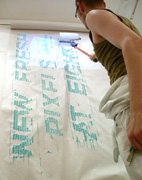
rapid response printing tool
The PixelRoller project is a collabortive investigation into a new creative tool between Stuart Wood MA (RCA) Interaction Design and Florian Ortkrass MA (RCA) Design Products. PixelRoller is a paint roller that paints pixels, designed as a rapid response printing tool specifically to print digital information such as imagery or text onto a great range of surfaces. The content is applied in continuous strokes by the user. PixelRoller can be seen as a handheld “printer”, based around the ergonomics of a paintroller, that lets you create the images by your own hand.
Ever increasing technological boundaries have removed the user from the creativity of the printing process. This separation diminishes the possibility of creative and live input during output.Conventional Printing is usually bound to a certain location, output method and process. Each printing process is very specific for each single application and the technology has become less adaptable and inflexible for the end user. Alternatively manual painting requires certain skills, time and is limited in accuracy. However the ability to print manually has advantages in terms of influencing the output, engaging with the medium and the freedom of not being limited to one substrate. [via neural.it]
Posted by jo at 11:09 AM | Comments (0)
C-Theory: 1000 Days 016

The Rebirth of the Author
"Roland Barthes’s famous prediction about the death of the author has come to pass, but not because the author is nowhere, but rather because she is everywhere. Indeed, the author has grown and multiplied in direct proportion to academic dismissals and denunciations of her presence; the more roundly and confidently the author has been dismissed as a myth, a construction, an act of bad faith, the more strongly she has emerged. The recent surge in personal websites and blogs — rather than diluting the author concept — has helped to create a tyrannical authorship presence, where the elevation of the personal and private to the public level has only compounded the cult of the author. We are all authors today. We are all ~auteurs~. We are all writers. We are all filmmakers. And we are all theorists, because what we make theorizes itself." From The Rebirth of the Author by Nicholas Rombes, C-THEORY, VOL 28, NO 3, 06/10/2005; Editors: Arthur and Marilouise Kroker.
Posted by jo at 11:01 AM | Comments (0)
THE POWER OF LANGUAGE

Image-Text-Sound
The Austrian Cultural Forum and the International Summer Academy of Fine Arts in Salzburg present THE POWER OF LANGUAGE/DIE MACHT DER SPRACHE; Image-Text-Sound/Blld-Text-Ton; VALIE EXPORT, Elfriede Jelinek, and Olga Neuwirth; OCTOBER 8 - NOVEMBER 3, 2005; OPENING RECEPTION: OCTOBER 7, 2005 | 6 - 8 PM ARTIST TALK WITH VALIE EXPORT: OCTOBER 7, 2005 | 7:30 PM.
The exhibition examines the musical, literary, and visual language of three important protagonists of present-day art. Media artist VALIE EXPORT (b. 1940), writer and poet Elfriede Jelinek (b. 1946), and composer Olga Neuwirth (b. 1968) are represented with sound, text, image, and light installations that exemplify the meeting of music, literature, film, and fine art.
The show, curated by Barbara Wally, introduces the three artists both as outstanding personalities in the contemporary Austrian cultural scene and through the common sensibilities and themes that unify their work. The three artists have known and appreciated each other for years and have also collaborated on a number of projects. They represent two generations of uncompromising and controversial women who use artistic means to analyze, expose, and critically comment on the human condition and who, in their respective media, work on the development of new, feminine forms of language.
The installations are accompanied by Chromotope portraits of the artists created by Victoria Coeln in her light studio. Carmen Kordas has contributed a video collage of extensive film and video material by and about the artists that conveys their creative processes from the beginnings of their careers to the present.
VENUE:
Austrian Cultural Forum
11 East 52nd Street
New York, NY 10022
212 319 5300
http://www.acfny.org
OPENING HOURS: MONDAY THROUGH SATURDAY | 10 AM - 6 PM
FREE ADMISSION
For information on the International Summer Academy of Fine Arts in Salzburg, please visit http://www.summeracademy.at or write to office[at]summeracademy.at
Posted by jo at 10:51 AM | Comments (0)
ASCII Carpets For Sale
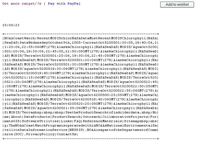
networked objects for the home
carpet/s is an internet based project by Lithuanian net artist mi ga that allows you to purchase a personalised carpet made out of ascii. It is based on a php application where internet resources are used as yarn to make ascii cloths. The user's influence is as small as a click of a mouse. All the rest is done by a machine. The program generates textual output based on the time when the user goes to a web site. The time in a form of hh:mm:ss is then used as a keyword for the results taken from a google search engine. The program downloads the contents of a second given result, rejects html tags and white spaces and puts all textual content into a carpet-like form. The produced carpet-like image can be printed out, signed by the artist and then sent to the purchaser.
Posted by luis at 10:37 AM | Comments (0)
Great Dance Weblog

Dance and Technology Resources
"Welcome to the first edition of our Dance and Technology Resource Guide. Please email Doug Fox to make additions and edits. In your email, include the resource name, link and description. Also, please include your contact information (name, email address and affiliation, if relevant).
Table of Contents: 1. Dance Companies, Performances, Installations and Practitioners 2. Dance on Camera and Movies 3. Conferences, Symposia and Courses 4. University/Academic Programs, Projects, Research Centers and Studios 5. Software and Technology 6. Games, TV Shows, Interactive Applications and Commercials 7. Dance Documentation and Preservation 8. Articles and Academic Papers 9. Online Discussions and Blogs."
Posted by jo at 10:35 AM | Comments (0)
Open Call
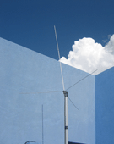
The Medium is the Material
Transmission art, much like new media, is deeply impacted by the evolution of technology. Taking airwaves as its source material, this ethereal medium has traveled a historical route that began with morse code at the turn of the past century and runs through text messaging at the start of this one, all the while encompassing a broad range of formal and conceptual strategies. For the exhibition Open Call, Rhizome has teamed up with free103point9, a nonprofit organization who've pioneered the study and practice of transmission art, to create a context for art works that explore transmission along the wireless spectrum. Open Call seeks projects that engage the idea of transmission art via the Internet or GPS systems or mobile phones, or any other wireless technology, and exist as art works online. The organizations have called out to artists in their respective communities to submit works for the exhibition which will take place from January through March 06, and be elaborated in a live, accompanying event. So, whip your nearest frequency into an ephemeral art frenzy, and contribute to the ongoing exploration of the waves that bind us. - Lauren Cornell, Net Art News, Rhizome.org
Posted by jo at 10:24 AM | Comments (0)
CONTAINED

Improvisatory in Nature
Contained--by MIX--is a collaborative and interactive, hybrid work performance/installation that utilizes technology to blur artistic boundaries and challenges notions of presentation/audience. The artists have created a generative, improvising, real-time multimedia environment using both commercial and custom designed software in conjunction with dedicated hardware sensors, motorized robotics and real time processing or text, video, images and sound. Contained is improvisatory in nature, principles of movement improvisation are employed in the creation of the imagery, sound, and movement generated by the system.
October 7, 8, 2005; 7:30pm; Doane Dance Performance Space; Denison University campus, Denison University, Granville, Ohio 43023 USA • 1-800-DENISON; Performance with Artists' Talk to follow.
MIX is:
Sandy Mathern-Smith, dance,
Alexander Mouton, Art,
Micaela de Vivero, Art,
Christian Faur, Art, Digital Technology
Aaron Fuleki, Music, Digital Technology
Marlon Barrios Solano, dance and interactive art
http://www.unstablelandscape.org/
Mary Sykes, Lighting Designer
Posted by jo at 09:40 AM | Comments (0)
i.plot
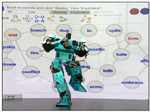
Chaos Engines and Hidden Relationships
i.plot investigates the future of narrative by studying the hidden relationships and contextual emergence of language. The goal is to generate interactive literature and scripts for interactive cinema. One of i.plot's innovations--Inspiration Space--is its ability to determine that a connection between two words exists...It finds several connections between the words by tracing a large set of possible paths between them, so that the paths traverse several two-word connections. If the chaos engine is in an appropriate state, a preference may be added so that longer paths are displayed, or so that the paths are forced to connect through a more distantly connected word. The user may further expand the connections of any word of interest...
Posted by jo at 09:29 AM | Comments (0)
REFRESH!
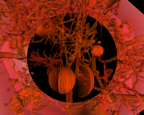
Judith Rodenbeck's Impressions
I’ve just come back from “REFRESH! The First International Conference on the Histories of Media Art, Science and Technology” in Banff. Herewith some brief impressions of the conference. I am an art historian (and ex-performance/video artist, from the Studio for Interrelated Media at Mass Art) with a longstanding but hitherto relatively untapped interest in new media. My own field of expertise is performance of the late 1950s and early 1960s, including Fluxus projects, but I also teach on the early part of the 20th century and am currently leading an advanced seminar on what I call “mechanical transcriptions of the real ”that is, following Kittler, those analog copying technologies that have so defined 20th century experience and inflected much of its art. I attended the conference as an observer, trying to learn more about the subject. What follows is merely a report, but it comes filtered through that complex of interests & preoccupations.
The first thing to be said is that this was an enormously ambitious conference: its four days were packed from morning to evening with panels and events the overall distribution of which, in terms of topics and time, I thought was pretty good, given the mission. Sessions ranged from “media histories” to a session on “collaborative practice/networking” to “history of institutions”; there were 3 keynote addressesEdmond Couchot, Sarat Maharaj, and Lucia Santaella; a poster session; an optional hike (Banff is in the stunning Canadian Rockies); a walk-through of the media labs; und so weiter. Meals were had communally in the Banff Centre’s dining room, and at least for me, since I knew not a soul at the conference AND felt like what one snooty panelist called a “clueless newbie,” these became interesting moments of social anxiety and unexpected social pleasure. While things did tend to split out into the old pros and the young nothings, they did get a bit more productively mixed up on occasion. Before I launch into the problems with the conference, the feeling I got from those I spoke with was that it was a mixed success but a success overall. I do think the conference provided a very good starting point for something, and this seemed especially true after the final session.
High points of the conference, in no particular order: * Mario Carpo’s paper on architecture in the age of digital reproducibility, which dealt with the shift from a simply additive to an algorithmic modularity in architecture. This was probably the most professionally delivered paper at the conference, as well as the most intelligently amusing, and what Carpo presented as a paradigmatic slide was fascinating, provocative. I learned something. Philip Thurtle and Claudia Valdes showing footage of Alvin Lucier doing solo for brainwaves. I’ve forgotten what the paper was about, but was thrilled to see the footage and to have the piece presented. Chris Salter on a history of performance with media, beginning with a fantastically forceful evocation of Russian Constructivis plays. I teach this material, but Salter’s presentation was vigorous and made a very strong case for its inclusion in a “new media” history. Christiane Paul on curatorial issues with new media. This was also a very professional (by which I mean good, clear, to the point) presentation and very usefully laid out the difficulties involved, from curators having to rebuild settings to house work to problems of bitrot to audience development. Impressive and useful. Machiko Kusahara on “device art” discussed Japanese aesthetics. This was an art historically thin paperno discussion of Fluxus, very loose mention of Gutai and then Tanaka’s electric dress but not the “painting machines” of her husband but the presentation of a different value-system for Japanese “device art” (gizmos whose “art coefficient” is activated by their use) was pretty convincing as well as very thought-provoking tour of the labs AND, surprisingly, the poster session, which was cluttered and weird but also the one moment in the conference when people really talked to each other’s ideas Tim Druckrey’s screening of apocalyptic Virilio. He gave a very lazy but passionate paper, basically asking why on earth new media would want to be included in an old canon, and noting that a far bigger problem is present in Nicholas Bourriaud’s blythe “relational aesthetics” than in the October cabal’s control of high theory. Michael Naimark’s corporatist but useful analysis of the sustainability of new media institutions. Johannes Goebel’s passionate and pragmatic overview of two such institutions. The final, quasi-impromptu “crit, self-crit” session led by Sara Diamond. This was where most of the interesting meta-issues were put on the table, and it was done in such a way that those in the room I think felt it was really a high point and a great note on which to finish. Left the feeling that while there is work to be done it will be done.
I didn’t go to everything, needless to say, and doubtless there were good things on other panels. I heard that Claus Pias’s paper on cybernetics was excellent, for instance.
That said, the conference overall suffered greatly from what Trebor Scholz and Geert Lovink have dubbed “panelism”: a territorial structure in which moderators also delivered papers within the format of a way over-tight schedule and with virtually no time for questions; a few speakers went beyond their alotted minutes in the first sessions and then panels were policed to an almost draconian degree, making the entire assembly tense. Discussions were notably truncated. In fact, to this art historian it seemed weird that people would gather for a conference on something as shifting and relatively openly defined as “new media” (how many papers in fact began with loose attempts to list the salient features of new media) and then sit and hear something they could have read already for though the organizers had posted quite a number of papers on their official website beforehand, it was clear that most attendees hadn’t read those papers and then not discuss what they had heard.
What surfaced in the tension around (non) discussion was a big mess of anxieties. Topped by the anxiety over having “new media art” categorized as “art” or as “new media,” these inflected many of the panel presentations and discussions, and not in a productive way. Part of the problem, as Andreas Broeckman pointed out in the final crit session, was that the mission of the conference was probably too broadly and vaguely defined. But what I heard over and over again was “traditional art history” can’t deal with new media. The first thing I’d want to know is, what precisely is “traditional art history”? From Simon Penny’s castigation of art history as racist, imperialist, classist, etc., it sounded to me like what was meant was Berensonian connoisseurship; this seemed overwrought, but his excursus was only the most vigorous and politically thought-through of a frequent plaint. Yet while he was quite right to note that cultural studies wasn’t mentioned once at the conference his characterization of art history is way behind the times. Art history and new media share Walter Benjamin and, for better or worse, Rudolf Arnheim; new media people would do well to read Panofsky and Warburg, just as I and at least some of my colleagues read Weiner and Kittler. Art history may not yet be able to deal with new media, but perhaps it is also the case that new media doesn’t know how to deal with art history.
On this score a truly low moment was struck on the first day by Mark Hansen, whose hatchet job on Rosalind Krauss was so lame that even the new media theorists were bugged. Instead of new media bemoaning its lack of recognition by art history and then its savaging of same (“we want to be with you; we you” or “I love you; go away”) it might be more productive to stage a genuine encounter. Leaving aside Andreas Broeckman, who gave a very nice but grossly amputated (ran out of time) presentation on aesthetics and new media, and the truly awful presentation comparing the websites of the Louvre and the Hermitage, the art historians who were at the conference were either working with medieval Islamic art or with the visual culture of science. That is, there were no art historians dealing with contemporary art who were not already part of the inner circle of new media people; yet this is precisely the encounter that needs to be staged. Meanwhile Mark Tribe, not an art historian, gave an extremely art historically lame presentation on appropriation, and while the broader point was, well, okay, his presentation of the historical material was painful and for at least this listener undermined his credibility. (On the other hand, Cornelius Borck, a historian of medicine, gave a terrific presentationhistorically nuanced, intelligently read, and carefully researched on the optophone of Raoul Hausman and Hausman’s complicated relationship to prosthesis.) From my perspective this suggests a serious problem of disciplinarity: surely just as new media artists/theorists expect a sophisticated treatment from art historians (Simon Penny again: art historians should learn engineering, cognitive science, neuroscience before they discuss new media) so new media artists and theorists should treat the work that comes beforeboth art and mediawith the historical complexity (without going to Pennyian excess) art history at its best demonstrates.
Other issues that came up: * Problems of storage & retrieval of new media work. From an historical point of view this demonstrates a remarkable degree of self-consciousness on the part of new new mediasomething new, incidentally, in the longer history of media, and interesting as a phenomenon. Huge anxiety about the “art” status of new media, alongside a subthematic of the relation to science and to scientific s of research. Adulatory izing of cognitive science, engineering, and neuroscience (in marked contrast to the dissing of art history). Lack of a fixed definition of new media, with repeated nods to hybridization, bodily engagement, non-hierarchical structure, networking, and so on. Disconnect of the keynote speakers. Couchot had difficulty with English and seemed, while emphasizing hybridity, to be speaking from another time. Sarat Maharaj rambled for nearly 2 hours about Rudolf Arnheim and the Other; I found this talk excruciating, though I later spoke with someone (media artist, go figure) for whom it had been a high point. And Lucia Santaella’s beautifully delivered, rigorously near-hallucinatory and religious but to me quasi- apocalyptic vision of the “semiotic” and “post-human” present/future of the “exo-brain” was a chilling picture of species-death. Ongoing problem of gender and geographic distribution. While non-Western topics cropped up here and there at the conference, the one panel that dealt in any extended way with non-Western paradigms was also the one panel that was almost all femaleand also the panel that got the most flak in its few minutes of discussion, in part because most of those dealing with non-Western paradigms were Western. This relegation of dealing with the Other to the women is typical. There was also some grumbling that many of the non-Western projects had been tucked into the poster session rather than elevated to panel status. It would have been good to have some representation from Africa, or even a panel on doing new media in less media-rich environments than Euro-Ameri-Nippon. Comical reliance on and then debate about Powerpoint. And then, as one member of the audience pointed out, nearly all of the people at the conference in their ppt-critical right-thinking wisdom had little glowing apples at their desks. No sign of Linux. That’s a sketch, replete with opinion. I’d encourage anyone interested in more specific information about the conference to check the website at www.mediaarthistory.org, which has some papers up as well as abstracts.
From: Judith Rodenbeck
Date: 5 October 2005 12:22:18 BST
To: idc@bbs.thing.net
Subject: [iDC] REFRESH! conference, some impressions
Posted by jo at 09:26 AM | Comments (0)
TEMPEST

Van Eck
The audiovisual performance TEMPEST--by Erich Berger--draws its name from a U.S government code word for a set of standards for limiting electric or electromagnetic radiation emanations from electronic equipment such as microchips, monitors or printers. In 1985, Wim van Eck published the first unclassified technical analysis of the security risks of emanations from computer monitors. Because of his research radiation from computer monitors is sometimes called "Van Eck Radiation" and the associated surveillance technology "Van Eck ". "Van Eck " means that computer screen content can be reconstructed remotely by picking up the emitted EM-field of the computer screen.
The performance TEMPEST utilizes the basic principles of this technique to transform purely generative graphic into a tight and intense composition of sound, noise and light. Several AM receivers are tuned into different frequencies of a computer screen and their outputs are plugged into an audio mixer for further sound processing. The graphics on the computer screen (seen by the audience via 2 large projections) become a means of producing sound and it is only the generative graphics which determine the different timbres and rhythms. A feed of the audio back into the image generating process adds a chaotic layer and so TEMPEST becomes a synaesthetic instrument mastered by surfing the space of possibilities evolving from this autopoietic process. [via Art from code - Generator.x]
Posted by jo at 08:45 AM | Comments (0)
October 06, 2005
Virtual Raft Project + Regrets
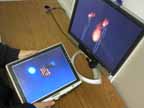
Two from UC DARNet
The Virtual Raft Project is a multidisciplinary undertaking seeking to create communities of believable autonomous characters that inhabit heterogeneous networks of computational devices. In particular, the project is interested in allowing the characters to break the plane of the traditional desktop screen. To this end, we have designed an interactive installation featuring a novel tangible paradigm for interacting with the characters. This paradigm involves the use of a mobile device, such as a Tablet PC or handheld computer, as a “virtual raft” by which a character may be transported among several virtual worlds. By enabling the character on the raft to react in real time to the raft’s motion in real space, this installation encourages participants to become physically engaged with virtual characters. We believe that this physical engagement can lead to an increase in the believability of the characters.
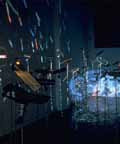
Share the Burden
Regrets consists of six to ten purpose-built mobile computer stations publicly located in and around Cambridge collect anonymously submitted regrets from the public to comprise a sociological database of contemporary remorse. Instant feedback to the individual user based on other contributors' similar concerns is algorithmically generated and calculated to 'share the burden'. Random selections and groupings of the regrets are made public across the city through existing signage and broadcast facilities. By engaging users in revelations of a problematic but constructive nature, we aim to bring specificities of individual lives, in this case personal regrets, into the realm of public debate, shared learning, and community.
About
The UC Digital Arts Research Network (UC DARNet) is an interdisciplinary Multicampus Research Group of University of California faculty who utilize digital media for cultural and theoretical research and in their creative production. As an ad-hoc planning group, UC DARNet has been meeting since 1997 to lay the foundation for a UC-wide program to facilitate collaborative research and teaching within a distributed digital arts and humanities community.
Culture is in the midst of an increasingly rapid shift to computer-mediated forms of creative production, distribution and communication. The role of digital media is fundamental to this shift. Digital Artists create a natural bridge across the traditional disciplinary divide between the humanities and the sciences. Interdisciplinary dialogue geared toward creative production and programmatic development will be facilitated by UC DARNet, providing an opportunity for critical engagement and conceptual dialogue between humanists, scientists, and those in the digital arts. A rotating group of UC digital arts and new media faculty act as principal investigators of UC DARNet and as the group's advisory committee.
GOALS AND OBJECTIVES
UC DARNet will, over a five year period, work to:
Serve to bridge counterproductive gaps between the arts, humanities, and sciences;
Enhance students' educational experience by providing access to faculty across the entire UC system;
Engage in experimentation and prototyping of distributed network environments which will be of value to a range of research interests and educational models; and, finally;
Help to establish UC as a leading institution for developing the new modalities of digital culture. UC DARNet will establish a strong UC presence outside of California through conferences, events, workshops, exhibitions, and ongoing online and offline dialogues. It is also actively planning to have research and development activities facilitate distance learning, and technology access to underprivileged middle school and high school children in the Southern California.
Funded by the University of California's Office of Research, UC DARNet pursues its programs and research activites with matching funding from the participant campuses, partner institutions and organizations, industry sponsors, corporations and foundations.
Posted by jo at 12:06 PM | Comments (0)
Train
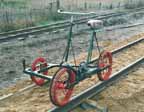
urban structure for aesthetic urban transportation
Underlying Train, by Helen Evans and Heiko Hansen, is the critical role of traffic and its industry for our society. Traffic has an impact for everybody; locally or remotely. The transportation industry and its economic power have a direct effect on pollution, large-scale urban planning schemes, political decision-making and the distribution of wealth. On a more semantic level, the car industry has successfully blurred the boundary between real functional needs and transportation dreams made possible through the acquisition of automobile artifacts. On the other hand many big research programmes seeking for alternative forms of public transport, for example Personal Rapid Transit systems carried out internationally could in most cases not offer a viable solution[1]. French sociologist, Bruno Latour reflected on the failure of France's most ambitious attempt to develop a working Personal Rapid Transit system and published the work as 'Aramis. Or, the Love of Technology'.
Between urbanism, vehicle design and automation the project Train is a research into the aesthetics of movement and travel. To locate the work we are using real, existing past, present and future, abandoned or at times unused railroad transportation systems; in Paris the railway track 'La Petite Ceinture'[2], which stopped its service in 1934 and the new tramway, which is partly completed. Both transportation systems are encompassing the city centre of Paris and are running parallel to the main traffic artery of Paris, the Periphérique, which is the circular city motorway that defines Paris and its Banlieu (the suburbs). It is this discrete line that splits the city into inside and outside. The Periphérique itself is pure automobile infrastructure and at peak times the traffic moves at walking speed.
Using existing, past and future railway transportation systems and Reverse Cultural Engineer them. Technological process feathers at its periphery. Similar to a fractal image an innovation is followed by other innovations, based on the original one. In a recursive environment like this we would like to go back to the origin, the innovation of railway and propose a different solution, here an individual perpetuated vehicle. In this way artistic process starts by going backwards to propose utilitarian design scenarios.
The Train project is a speculation into the language and aesthetics of transportation, particularly those that have become so ubiquitous and unquestionable for us. By proposing different real installations which would work within active or abandoned public transport structures and a series of conceptual designs a dialogue should be raised that engages in questions about the reality and "real fiction" of traffic.
Posted by jo at 11:45 AM | Comments (0)
Visualizing the Future:
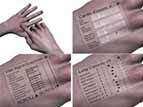
Dermal Nanotech Display
This nanotech dermal display is a designer concept, based on real nanoscience principles. Seattle-based designer Gina Miller, working together with nanotech populariser Robert A. Freitas Jr., describes the concept:
"In his book Nanomedicine, Volume I: Basic Capabilities [available on the web at http://www.nanomedicine.com/NMI.htm], Robert A. Freitas Jr. describes [in section 7.4.6.7 (page 204)] a "programmable dermal display" in which a population of about 3 billion display pixel robots would be permanently implanted a fraction of a mm under the surface of the skin, covering a rectangle 6 cm x 5 cm on the back of the hand. Photons emitted by these pixel bots would produce an image on the surface of the skin. This pixelbot array could be programmed to form any of many thousands of displays.
Each display would be capable of two functions: (1) presenting to the user data received from the large population of medical bots that roam the user's body; (2) conveying instructions from the user to that same large population of bots. The display could be activated or deactivated by finger tapping on the skin." The 3-minute animation of dermal display can be seen here. Additional thoughts of Mrs. Miller's at her weblog... [blogged on medgadget.com]
Posted by jo at 11:29 AM | Comments (0)
Images in the sky

Recycled Connections
200 images from the Internet were released into the sky via red, green and blue helium filled balloons on the 2nd of October 2005 in Victoria Park, London. For all we know they could all just fall into the Channel. But we hope that if someone finds an image they will get back to us and let us know where they are, and participate by sending us an image or message of their own.
Posted by jo at 11:08 AM | Comments (0)
Playing the Building
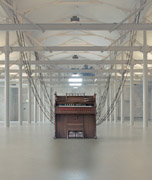
Architecture as Instrument
With Playing the Building, David Byrne wanted to create an installation that would produce sound and would take advantage of the fact it is housed in a raw factory space- with exposed pipes, heating and structural elements.
Devices are attached to the building structure- to the metal beams, the plumbing, the electrical conduits, the heating pipes, the water pipes - and are used to make these things produce sound. No amplification is used, no computer synthesis of sound and there are no speakers. The machines will produce sound through wind, vibration and striking. The devices that are part of the piece do not produce sound on their own, but instead they cause the building elements themselves to vibrate, resonate and oscillate so that the building itself becomes a very large musical instrument.
At the the Färgfabriken artspace, Stockholm, Sweden. 2005-10-08 - 2005-11-13. Opening and party Saturday October 8, 12pm-1am. Related: Sascha blogged the Electromechanical mandala workshop with Douglas Irving Repetto at the UDK in Berln. [blogged by Regine on we-make-money-not-art]
Posted by jo at 10:33 AM | Comments (0)
Remote
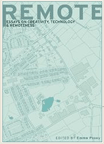
Creativity, Technology and Remoteness
Remote - Creativity, Technology and Remoteness, Bloc Press; edited by Emma Posey--Remote is a collection of essays by a distinguished group of academics, artists, business consultants, sociologists, philosophers, arts organisers and curators.
The essays which span a broad range of subjects, explore the recently integrated field of creativity, technology and remoteness. The publication considers the new geographies that information proximity and material distance have produced. REMOTE will interest professionals and students engaged with culture, technical innovation and social theory. Authors include: JAMES COUPE, ALAN DUNN, CAMILLA JACKSON, BRITT JORGENSEN JAMES GOODMAN, LUCY KIMBELL, CELIA LURY, ROB PEPPERELL MICHAEL PUNT, and PAUL TAYLOR.
Outline on the Collection of Essays in Remote
The ideas presented in the publication’s collection of essays reflect a spectrum of approaches to creativity, technology and remoteness and are given in two parts: In Theory and In Practice.
In Theory, part 1 of the publication, Lucy Kimbell explores the use of mobile networks and the inherent contradiction between mobility and connectivity - users are offered `freedom of movement` but are restricted within delineated spaces specified by the mobile networks. With the use of mobile technologies, interconnectivity is a spatial concern. In fact, technological devices reinstate our reliance on the physical world rather than the popularly asserted outcome of technology - ‘freedom from place’. Kimbell points out, essentially being `part of a global network requires us to be local, to be placed.` Here remoteness is possible only through close proximity.
By way of the transmitter/receiver, our social boundaries are broadened but only by being kept within physical, and very localised, boundaries. Paul Taylor notes that by accessing distant events our notion of ‘reality’ is extended – reality comes from and becomes further afield. He notes a TV voyeur’s startling inability to distinguish between a spectrum of events, whether they be banal such as reality TV and significant, such as news events. The coupling of mediated reality and the spectacle that is TV emphasises a circulation of ‘image over substance’. The image’s emotiveness enables us to be consumed within these distant realities.
Exploring what they term the ‘science of consciousness’, Robert Pepperell and Michael Punt look at the performative and theatrical spaces as metaphor for the extension of our experience beyond our immediate environment. Through the antics of a conjuror, they demonstrate how something concrete can be conjured from nothing and, in describing a ‘virtual’ event, they explore how presence can be signified by absence or loss. In their example technology extends our sense of embodiment rather than substitutes the space around us. Through the power of analogy we can function in various states at one time.
In her study on ‘brands’, Celia Lury explores a broader understanding of technology as information. In an information society, brands signify a particular organisation of relations between products and the multiplication of points of access in a system of products. In this example, objectivity of a brand is not fixed but is about change, endurance, and process. One of the key aspects of Lury’s approach is how branding, production and circulation of products are part of an extended, albeit intangible, network of an information capitalism.
In Practice, part 2 of the publication, James Coupe usefully draws together the idea of mobile technologies and actual as a means of understanding a user’s involvement in spatial terms. He explores through his own artwork, the use of cellular networks and how through a direct engagement with his work, users become components of a larger system. Coupe offers the term ‘system aesthetic’ as a representational scenario that attempts to explain this new form of artwork. This analogy help to visualise the extensions of activity that cannot all be experienced.
Camilla Jackson offers an exploration of various artists’ depiction of nature, some of who also use mobile technologies. Technology, brought on by the industrial revolution, is claimed to create a distance between people and nature. There is an apparent contradiction when nature is depicted as untouched and remote even though its very depiction indicates some form of entry. Remoteness, Jackson claims, is as much a state of mind as a physical location.
In their study of home workers, Britt Jorgensen and James Goodman explore the archetypal vision of the home-based teleworker. They reject the assumption that teleworkers are based in remote regions in remote communities - most live in an urban environment. As such, technology does not create or reduce distance as is popularly asserted. Tacit understanding is best expanded through direct and informal interaction. Although not explicitly, this often takes place through close working environments. Hence, technology does not substitute usual practice but it can extend it.
Utilising technology is only possible within an existing context of communication and participation and this is stressed by the ‘tenantspin’ project presented by Alan Dunn. The project’s focus is to engage a community of housing tenants in generating unmediated content for streaming within and beyond their immediate community. Dunn outlines, the outcome of using technology reflects existing community contexts and networks.
Notes on Contributors
James Coupe is Lecturer in Digital Art at London College of Music & Media, a Faculty of Thames Valley University. He is an artist who works with installation, electronics and digital media. His installation Digital Warfare Network (Project Phase Two) was exhibited at New Contemporaries 2001, and in 2002 he was awarded an Artsadmin bursary to develop a new project titled I, Robot. Phase Two of the I, Robot project was commissioned for Metapod 2003 in Birmingham. He has recently received major funding from the Arts and Humanities Research Board (AHRB) for a twelve-month research project to create a conscious artwork.
Alan Dunn is manager of the tenantspin Superchannel project by FACT, the Foundation for Art & Creative Technology. He initiated and curated The Bellgrove Billboard Project (Glasgow 1990-91) and Liverpool Billboard Project (1999), presenting new works by various artists with accompanying catalogues. Recent projects include honour (flyposted works, Rio de Janeiro) and not dead white man (jumpshiprat, Liverpool and Anthology of Art, Ars Electronica, Linz).
Camilla Jackson has been Programme Organiser at The Photographers’ Gallery, London since 2000 during which time she has curated the group show Re: mote (for more information see past programme on www.photonet.org.uk). Previously, she was Exhibitions Curator at Tate Liverpool. Publications include Willie Doherty: Somewhere Else (1998) and Up in the Air (2000).
Britt Jorgensen and James Goodman both work at Forum for the Future, a sustainable development charity and think-tank. Their work concentrates on the social, economic and environmental role of new communication technologies within the sustainable development framework. Britt previously worked in one of Scandinavia`s leading think-tanks, House of Monday Morning. Published work includes the Danish National Index of Competency (1998, 1999) and a paper on telework and sustainable development (2002). Published work by James includes a paper on mobile telephony and social capital (2003) and a review of Information and Communication Technology and sustainable development (2002). Britt and James are both currently working on a new book from Forum for the Future, Making the Net Work: Sustainable Business in a Wired World.
Lucy Kimbell led design teams helping mobile operators develop multi-channel services in 1999-2001. Her art commissions include the book Audit (Book Works, 2002) and the LIX Index (Channel 4/Arts Council/Film and Video Umbrella 2002). A recent art commission for Arttones.net involved creating a series of downloadable operator logos. She has recently been awarded an AHRB Creative Fellowship at the Ruskin School of Drawing and Fine Art, Oxford University. www.lucykimbell.com.
Celia Lury is Professor of Sociology at Goldsmiths College, University of London. She has written widely on the sociology of culture, including Cultural Rights (Routledge, 1993), Consumer Culture (Polity, 1993), Prosthetic Culture (Routledge, 1998) and Global Nature, Global Culture (with S. Franklin and J. Stacey, Routledge, 2000). She is currently writing a book on brands, also to be published with Routledge.
Robert Pepperell is a member of Polar (The Posthuman Laboratory for Arts Research) and a lecturer in Contemporary Art Theory at University of Wales College, Newport. He has published The Posthuman Condition (Intellect, 1995) and The Postdigital Membrane (Intellect, 2000) in collaboration with Michael Punt. A revised version of his first book, entitled The Posthhuman Condition: Consciousness beyond the brain, has also recently been published (Intellect, 2003). He has exhibited and lectured widely, and is currently working on a new book.
Emma Posey is an artist, writer and founding Director of Bloc, an art and new technology agency established in 1998. She has written widely on contemporary visual art and the effects of technology on place. Essay contributions to publications include Behind You in Between Us (2003) by artist Mariele Neudecker and Memory Maps in Distance Made Good (2002) by artists Jen Hamilton and Jen Southern. Her editorial work includes Further (2003), a catalogue to accompany Wales at the Venice Biennale, 2003.
Michael Punt is Reader at the University of Wales College, Newport, Deputy Director of the Centre for Advanced Inquiry into Interactive Art (CAiiA) and Editor in Chief of Leonardo Digital reviews. He has made over 15 films and published widely in the field of technology and its uses. His recent publications include a book-length study on early cinema Early Cinema and the Technological Imaginary, The Postdigital Membrane (Intellect, 2000) in collaboration with Robert Pepperell, Imagination, Technology and Pleasure: The Emergence of Cinema to be published by Intellect in 2003 and a CD Rom Radical Nostalgia.
Paul A. Taylor is Senior Lecturer in Communications Theory at the University of Leeds and formerly of the University of Salford. He is the author of Hackers: Crime in the Digital Sublime (Routledge 1999) and is currrently finishing Media Processes and Effects: Living in the New Plato`s Cave for Palgrave publishers.
To Book:
The publication cost £9.50 plus £1 for P&P. To order a copy email a request to remote@bloc.org.uk OR send a cheque for £10.50 payable to ‘b10c’ with your postal details.
ISBN: 0-9544935-0-8
Title: Remote: Creativity, Technology and Remoteness
Editor: Emma Posey
Publisher: Bloc Press
Price: £9.50
P&P: £1
Place of Publication: Bloc Press, The Cross, Gladestry, Powys HR5 3NX
Posted by jo at 10:22 AM | Comments (0)
Vectors

Issue #2: Mobility
Vectors: Journal of Culture and Technology in a Dynamic Vernacular is pleased to announce the launch of Issue #2: Mobility.
The Mobility issue of Vectors includes work ranging from a rhizomatic exploration of the historical representation of the Irish to a manifesto for creating academic superheroes. Featured scholars include David Lloyd, Jane McGonigal, the Labyrinth Project, Julian Bleecker, the Guantanamobile Project, Todd Presner, and Dietmar Offenhuber.
Vectors is an international peer-reviewed electronic journal dedicated to expanding the potentials of academic publication via emergent and transitional media. Vectors brings together visionary scholars with cutting-edge designers and technologists to propose a thorough rethinking of the dynamic relationship of form to content in academic research, focusing on the ways technology shapes, transforms and reconfigures social and cultural relations. Vectors is edited by Tara McPherson and Steve Anderson with creative direction by Erik Loyer and Raegan Kelly.
Posted by jo at 10:07 AM | Comments (0)
A review of David Harvey, A Brief History of Neoliberalism
![]()
THE SCANDAL OF THE WORD "CLASS"
THE SCANDAL OF THE WORD "CLASS": A review of David Harvey, A Brief History of Neoliberalism (Oxford UP, 2005) by Brian Holmes [via]
"David Harvey's new book has four faces on its cover: Reagan, Thatcher, Pinochet and Deng Xiaoping. It makes one self-evident, yet strangely scandalous assertion: the rise of neoliberal economics since the late 1970s--or more precisely, since the bankruptcy of New York City and the dictatorship in Chile--is the centerpiece of a deliberate project to restore upper-class power.
True to its title, the book presents a concise but extremely well-documented economic history of the last three decades, encompassing not only the usual G-7 countries but the entire world, with a particular emphasis on the US and capitalist China. It identifies structural trends of neoliberal governance that, as the book nears conclusion, serve equally to explicate the present crisis, both of the global economy and of interstate relations. And finally it asks the political question of how resurgent upper-class power can successfully be opposed. Here is where the most benefit could be gained by examining the aura of scandal that surrounds its central thesis.
But first let us consider in detail how this history unfolds. It is well known that Chicago-school economists, trained by Milton Friedman, applied the latter's free-market utopia to Chile after the consolidation of power by Pinochet in 1975. "Freedom" was a key word in the economic management propounded by the dictator. Harvey begins not with that story, but instead with four orders issued on September 19, 2003 by Paul Bremer, head of the Coalition Provisional Authority in neoliberated Iraq. The orders included "the full privatization of public enterprises, full ownership rights by foreign firms of Iraqi businesses, full repatriation of foreign profits... the opening of Iraq's banks to foreign control, national treatment for foreign companies and... the elimination of nearly all trade barriers" (p. 6). Only oil was exempted from these orders, presumably because of its status as a strategic (i.e. military) resource. In addition, a flat tax, long promoted by Republicans in the US, was imposed. Harvey sees these economic parameters as exemplary of a neoliberal state, defined as "a state apparatus whose fundamental mission [is] to facilitate conditions for profitable capital accumulation on the part of both domestic and foreign capital." The freedoms embodied by that particular kind of state "reflect the interests of private property owners, businesses, multinational corporations, and financial capital" (p. 8).
After drawing a striking parallel between the restructuring of the Iraqi and Chilean economies, he goes on to recount the sequence, relatively familiar from his previous books, whereby the postwar social compromise between capital and labor, instituted internationally by the 1944 Bretton Woods fixed exchange-rate system and by tariff barriers and capital controls negotiated within the General Agreement on Tariffs and Trade, gradually collapsed in the early 1970s after delivering two decades of sustained high growth. The central argument in this opening chapter is an account of the dramatic increase in the income of the upper 1% of the population of the most developed countries from the mid-1980s onward. By the end of the century, in the US case, that upper one-hundredth of American society commanded a full 15% of the national wealth--up from less than 8% at the close of WWII, and now very close to the level of 16% that had obtained before the war. On the same page Harvey offers another figure: "the ratio of the median compensation of workers to the salaries of CEOs increased from just over 30 to 1 in 1970 to nearly 500 to 1 by 2000" (p. 16). And he points to similar concentrations of wealth in Britain, Russia, China and Mexico, as well as to the widening of the global income gap between the top fifth of the world's population in the richest countries and the bottom fifth in the poorest, which has gaped dramatically from 30 to 1 in 1960 to 74 to 1 in 1997. Over the same period, aggregate global growth rates fell from 3.5% for the decade of the 1960s to just 1.1% for the 1990s. These statistics support the assertion that neoliberalism is less "a utopian project to realize a theoretical design for the reorganization of international capitalism" than it is "a political project to re- establish the conditions for capital accumulation and to restore the power of economic elites" (p. 19). In other words, despite all its purported advantages in terms of lower taxes, renewed growth, liberty from bureaucratic constraint, expanded job opportunities and consumer choices for the common man, free-market theory serves in practice to mask the recapture of state power by the rich. The usefulness of history in an amnesiac society is simply to remember what happened in our lifetimes. Take the prolonged economic downturn of the 1970s, when worldwide competition intensified, resource prices rose, global demand fell, output stagnated, inflation climbed sharply, and the US was faced with the uncontrollability of its own corporations, which parked their global profits in offshore "eurodollar" markets rather than taking them home where they would be taxed. Under the Keynesian logic of domestic economic management, which traditionally sought to ensure full employment and effective consumer demand for manufactured goods, the crisis could only be treated by lowering interest rates and expanding welfare entitlements and public-works investments. But the result of those policies was an inflationary wage-price spiral, which combined with persistent low growth rather than alleviating it. The resulting paradox of "stagflation" was finally countered in October 1979 by the so-called "Volcker shock."
Paul Volcker, chairman of the US Federal Reserve Bank under Carter, raised interest rates dramatically, reaching a nominal rate of 20% by July 1981. One major result was to make the new, fully liquid and negotiable US Treasury bonds an irresistible destination for investments that poured in from around the globe, thus re-establishing the central position of the US in world finance and permitting the unprecedented deficit-spending, or military Keynesianism, of the Reagan era. But Harvey doesn't even mention that here ? because the key effect in terms of the restoration of upper-class power was to precipitate a sharp recession that broke the wage-price spiral and weakened the bargaining position of trade unions, as workers were laid off and business after business failed. Reagan, who fully approved of Volcker's approach, would pursue this attack on labor after his accession to the presidency in 1980, notably by defeating the air-traffic controllers' strike in 1981, then going on to promulgate the sweeping tax cuts and broad deregulation of industry and finance for which he and Thatcher are renowned.
"Tax breaks on investment effectively subsidized the movement of capital away from the unionized north-east and midwest and into the non-union and weakly regulated south and west," notes Harvey (p. 26). The top personal tax rate fell from 70 to 28 percent. But the Volcker shock had even more important consequences in the realm of international relations.
The originality of David Harvey's books is the way he is able to trace the dynamics of capital flows across time and across the geographical scales, from the intimate to the urban, regional, national, continental and world levels. Here he recalls how the OPEC price hike of 1973 placed huge amounts of capital in the hands of the oil-producing states; and he refers to Peter Gowan's account of the way the Saudis were forced by threat of invasion to continue pricing their oil sales exclusively in dollars, and to recycle these petrodollars through New York investment banks. Low US interest rates in the mid-1970s meant that this capital had to be placed elsewhere, and the solution was to lend it to the governments of developing countries. "This required the liberalization of international credit and financial markets, and the US government began actively to promote and support this strategy globally during the 1970s" (pp. 28-9). The loans, however, were also designated in US dollars, with the result that any rise in the US interest rate could easily force debtor countries into default. This is exactly what happened to Mexico in 1982-84, in the wake of the Volcker shock--and it was at this point that economic crisis became the primary tool of neoliberal restructuring. Harvey makes this analysis:
"The Reagan administration, which had seriously thought of withdrawing support for the IMF in its first year in office, found a way to put together the powers of the US Treasury and the IMF to resolve the difficulty by rolling over the debt, but did so in return for neoliberal reforms. This treatment became standard after what Stiglitz refers to as a 'purge' of all Keynesian influences from the IMF in 1982. The IMF and the World Bank thereafter became centres for the propagation and enforcement of 'free market fundamentalism' and neoliberal orthodoxy. In return for debt rescheduling, indebted countries were required to implement institutional reforms, such as cuts in welfare expenditures, more flexible labour market laws, and privatization. Thus was 'structural adjustment' invented" (p. 29).
It is crucial for the overarching thesis of the book that the reader should remark how institutions controlled by the American state (as is the case of the IMF) act to further the interests of private banks directing enormous capital flows for the exclusive profit of a few. The fact is that the US overcame its stagnating industrial growth by becoming the pivot--and policeman--of global finance. At this point Harvey identifies a key difference between classic liberal theory and actual neoliberal practice: "under the former, lenders take the losses that arise from bad investment decisions, while under the latter the borrowers are forced by state and international powers to take on board the costs of debt repayment no matter what the consequences for the livelihood and well-being of the local population" (p. 29).
If one were to summarize A Brief History of Neoliberalism on a world map rather than a sheet of paper, by inscribing names and dates on the places mentioned and then using arrows to retrace capital flows, the result would be a dynamic picture of many of the hidden tensions that animate contemporary geopolitics. Yet these capital flows, and the corresponding transformations in daily life, are not just results of primary changes originating in the US and Britain. Another strong thesis of the book is that "the general progress of neoliberalization has... been increasingly impelled through mechanisms of uneven geographical development" (p.87). On the one hand, specific states, regions and cities are upheld as successful models for capital accumulation, resulting in government programs that strive to make populations everywhere behave like, say, Japanese, North Italians, or Singaporeans, or to make our productive environments resemble Ireland, Silicon Valley or Hyderabad (with the next fashionable role model likely to be authoritarian China). On the other hand, and far more effectively, each new crisis? and these have become increasingly frequent since the mid-1970s--represents a chance for monopoly concentration, foreign takeover of assets, and structural adjustment, as exemplified by the case of the so-called "Asian crisis" that also wreaked its havoc on Russia and Brazil in 1997-98. Harvey lists four main factors to explain the rising turbulence: the financialization of everything (i.e. the conversion of ownership rights into titles that can be traded instantaneously, along with all their derivatives, on electronic marketplaces); the increasing mobility of capital thanks to international agreements, culminating in the founding of the WTO in 1995; the pressure to enact neoliberal reforms exercised by the "Wall Street-IMF-Treasury complex"; and the spread of the new monetarist and neoliberal orthodoxy in university economics departments the world over, eliminating the former Keynesian paradigm. These give rise to a world system where capital accumulation proceeds, not despite, but because of the uneven geographic fluctuations of continuous crisis.
Incisive studies of the transformations in Mexico, Argentina, South Korea and Sweden illustrate the vicissitudes of the "Washington Consensus" that wove these four main threads together into a dominant pattern by the early 1990s, as Clinton and then Blair consolidated the neoliberal paradigm from a center-left position (which, to be sure, no longer has anything recognizably "left" about it). One of the advantages of a geographic treatment of history is to avoid lumping everything together into a uniform global picture: "The degree to which neoliberalism has become integral to common-sense understandings among the populace at large has varied greatly depending on the strength of belief in the power of social solidarities and the importance of traditions of collective social responsibility and provision" (p. 116). Implementation of the upper-class agenda varied consequently. Thus one can speak of a "circumscribed" neoliberalism in the Swedish case, or note the failure of French elites to reach the income gaps attained in most other developed countries. Crucially, Harvey draws attention to the interplay of local capitalist classes and external forces: "It sometimes seems as if the IMF merely takes the responsibility for doing what some internal class forces want to do anyway" (p. 117). A phrase which in my view applies perfectly to the recent crisis in Argentina, among others. The key to understanding the dynamics of the world system is therefore to pierce the imbroglios surrounding the ways that national and transnational elites collude to take advantage, not only of industrial or financial booms, but also of the periodic busts that inevitably offer a chance for the big fish to swallow the assets of the smaller ones, while destroying the common people's means of livelihood. This type of collusion is central to the process that Harvey calls "accumulation by dispossession."
The thing we are asked to conceive, therefore, is the way that uneven geographic development knits itself together into the dynamics of far-reaching crisis. The geopolitical Gordian knot that appears so clearly at the end of the book (particularly if you have also read The New Imperialism) is the one that intertwines the ever-expanding debt of the United States, the industrial boom of China and the coveted oil reserves of the Middle East. It would be interesting to hear an informed opinion on the chapter dealing with China's economic and social history, since 1978 when Deng Xiaoping began the privatization of state enterprises and agricultural collectives, and the opening of coastal cities to foreign capital. What's compelling for the ordinary reader is the way Harvey recounts a series of isolated experiments that gradually fit together into a coherent pattern of practice (indeed, all his historical accounts adopt this empirical approach). The Communist Party is credited with managing "to onstruct a form of state-manipulated market economy that delivered spectacular economic growth (averaging close to 10 percent a year) and rising standards of living for a significant portion of the population for more than twenty years." At the same time, the Party is hardly spared critique: "It almost certainly embraced economic reforms in order to amass wealth and upgrade its technological capacities so as to be better able to manage internal dissent, to better defend itself against external aggression, and to project its power outwards onto its immediate geopolitical sphere of interest" (p. 112).
The authoritarianism of Deng and the successive leadership is repeatedly stressed. But it is China's overwhelming growth that takes your breath away: 114 million migrant workers who have left the countryside for the city; a rate of urbanization of around 15% a year; foreign direct investment at 40% of GDP in 2002; automobile production of 250,000 a month in 2004 (mostly for internal consumption, and with ecological consequences one would rather not imagine...). A phrase from a New York Times report sums it up: "In 2003 China took '30 per cent of the world's coal production, 36 per cent of the world's steel and 55 per cent of the world's cement" (p. 139). One imagines endless highways, skyscrapers, shopping malls, airports. China is now the world's second largest oil importer after the US, with its hungry eye on all the world's reserves. This phenomenal growth stems from a pattern of strategically privatizing, profit-driven management, which broadly corresponds to that of the neoliberal state. "But in one respect the Chinese Depart glaringly from the neoliberal template," Harvey writes. And he continues:
"China has massive labor surpluses, and if it is to achieve social and political stability it must either absorb or violently repress that surplus. It can do the former only by debt-financing infrastructural and fixed-capital formation projects on a massive scale (fixed-capital investment increased by 25 per cent in 2003)...But all of this requires that the Chinese state depart from neoliberal orthodoxy and act like a Keynesian state. This requires that it maintain capital and exchange rate controls. These are inconsistent with the global rules of the IMF, the WTO, and the US Treasury.... The enforcement of capital flow controls is becoming increasingly difficult as Chinese yuan seep across a highly porous border via Hong Kong and Taiwan into the global economy. It is worthwhile recalling that one of the conditions that broke up the whole Keynesian post-war Bretton Woods system as the formation of a eurodollar market as US dollars escaped the discipline of its own monetary authorities. The Chinese are already well on their way to replicating that problem, and their Keynesianism is correspondingly threatened" (p. 141).
What plainly worries Harvey are the possibly violent consequences of a crisis affecting the US-China relation. For the two continent-sized countries are now the double engine of world productivity: as the one constantly struggles to consume what the other struggles to produce, domestic peace in both comes to depend on the continuity of what looks like a mad race to nowhere. Harvey, like Giovanni Arrighi and his collaborators, thinks that a major hegemonic shake-up--i.e. the displacement of the US from its now-fragile position as linchpin of the world economy--may well be in the offing. But he does not see any way this could occur peacefully:
"A peculiar symbiosis emerges, in which China, along with Japan, Taiwan, and other Asian central banks, fund the US debt so that the US can conveniently consume their surplus output. But this renders the US vulnerable to the whims of Asian central bankers. Conversely, Chinese economic dynamism is held hostage to US fiscal and monetary policy. The US is also currently behaving in a Keynesian fashion ? running up enormous federal deficits and consumer debt while insisting that everyone else must obey neoliberal rules. This is not a sustainable position, and there are now many influential voices in the US suggesting that it is steering right into the hurricane of a major financial crisis. For China, this would entail switching from a politics of labour absorption to a politics of overt repression. Whether or not such a tactic can succeed, as it did in Tiananmen Square in 1989, will depend crucially upon the balance of class forces and how the Communist Party positions itself in relation to those forces" (p. 142).
Every contemporary conflict can be assessed within this wider panorama. Is the oil-grabbing Iraq occupation the opening gambit in a long-term struggle that will violently oppose the two seemingly inseparable trading partners over the control of the world's key strategic resource? This was the question Harvey asked in The New Imperialism. But the current book, having demonstrated with greater precision the extent to which the neoliberal model of economic management has become the ruling paradigm across the earth, tends rather to focus on the balance of class forces that will be decisive in the resolution of a major crisis. It is here that the political question of the foundations of the neoliberal consensus becomes crucially important to the citizens of the purportedly democratic nations, who still may have some chance to swing the balance of majority opinion towards a rejection of the worst kinds of decisions (like those taken systematically by the Bush administration). For the paradoxical and sobering truth (I have to say this directly to Americans) is not only that we elected those who have brought the country to the present impasse, but more pertinently, that no one among the so-called "Left" or "progressives," and least of all among the Democrats, has been able to come up with an alternative that can unseat the neoliberal model. Clinton, in this respect, merely upped the ante of the speculative boom, thereby ushering in the disastrous crisis-management of Bush, after the stock-market crash of mid-2000 and the events of September 2001. The citizens of practically every other developed country can make a similar self-critique, even if, with the partial exception of Britain, their governments did not face such tests and do not bear such direct responsibility. So one crucial question is, where have we gone wrong on the Left, since the mid-1970s when the neoliberal option first emerged, then the early 1980s when it already began to take on its definitive political configuration? And more importantly, what sort of counter-hegemony could safely steer the world beyond the looming likelihood of a violently imperial slicing of the Gordian knot, on a scale tragically greater than that of the current disaster in Iraq?
These are the problems that challenge the reader of A Brief History of Neoliberalism to overcome sheer fascination with such an intricate account of the road to capital bondage in the name of individual freedom. Indeed, this book of exacting historical detail is also a sustained invitation to consider the different meanings of the word freedom, which, as Harvey points out with a quote from Karl Polanyi's The Great Transformation, can be "the freedom to exploit one's fellows, or the freedom to make inordinate gains without ommensurate service to the community, the freedom to keep technological inventions from being used for public benefit, or the freedom to profit from public calamities secretly engineered for private advantage" (p. 36). By retracing the way that the very premises of nineteenth century liberal capitalism led to the disasters of the two World Wars, Polanyi sought to make the reader consider all the complex economic and institutional balances that would be needed to insure the justice and equity of "freedom in a complex society" (which is the title of the last chapter of The Great Transformation). Harvey's book has similar ambitions. So let's restate the major political questions that it raises. Why did neoliberal theory gain such a hold over the "common sense" of broad majorities? How did it then evolve into an electorally effective neoconservativism? What has halted the formation of a counter- hegemony? Why does the seemingly self-evident thesis of a resurgence of upper-class power have so little political currency in today's debates?
Like Boltanski and Chiapello in France (whom however he does not cite), Harvey develops the theme of a growing split, from the late sixties onward, between the traditional working-class concern for social justice and the New Left concern for individual emancipation and "full recognition and expression of particular identities" (the split between what the French sociologists call "critique sociale" and "critique artiste"). With a sense for the complexity of the issues, he remarks that "neoliberalism did not create these distinctions, but it could easily exploit, if not foment, them." And he goes on to say that "Neoliberalization required both politically and economically the construction of a neoliberal market-based populist culture of differentiated consumerism and individual libertarianism" (p. 42). Various kinds of extremely interesting evidence are then adduced to suggest that corporate foundations and think tanks--via works such as Nozick's Anarchy State and Utopia--made deliberate attempts at the inculcation of market-oriented variations on counter-cultural values. Harvey's strongest gesture in the direction of cultural critique comes during his account of the bankruptcy of New York City--which he characterizes as a departure point for the entire process of neoliberalization. Faced with a fiscal crisis, "a powerful cabal of investment bankers (led by Walter Wriston of Citibank) refused to roll over the debt and pushed the city into technical bankruptcy" (p. 45). What followed was an assertion of upper- class power over a city that had engaged, from the bankers' viewpoint, in excessive provision of public services and excessive concessions to unions. To prove the deliberate nature of this disciplinary project, Harvey quotes then-president Ford's Treasury Secretary, William Simon, who maintained that the terms of any bail-out should be "so punitive, the overall experience so painful, that no city, no political subdivision would ever be tempted to go down that road again" (p. 46). But what would the new road look like? All those involved in cultural production should pay close critical attention to the way Harvey depicts the restructuring of New York City by the bankers:
"The creation of a 'good business climate' was a priority. This meant using public resources to build appropriate infrastructures for business (particularly in telecommunications) coupled with subsidies and tax incentives for capitalist enterprises. Corporate welfare substituted for people welfare. The city's elite institutions were mobilized to sell the image of the city as a cultural centre and tourist destination (inventing the famous logo 'I Love New York'). The ruling elites moved, often fractiously, to support the opening up of the cultural field to all manner of diverse cosmopolitan currents. The narcissistic exploration of self, sexuality, and identity became the leitmotif of bourgeois urban culture. Artistic freedom and artistic license, promoted by the city's powerful cultural institutions, led, in effect, to the neoliberalization of culture. 'Delirious New York' (to use Rem Koolhaas's memorable phrase) erased the collective memory of democratic New York. The city's elites acceded, though not without a struggle, to the demand for lifestyle diversification (including those attached to sexual preference and gender) and increasing consumer niche choices (in areas such as cultural production). New York became the epicentre of postmodern intellectual and cultural production.... Working-class and immigrant New York was thrust back into the shadows, to be ravaged by racism and a crack cocaine epidemic of epic proportions in the 1980s that left many young people either dead, incarcerated, or homeless, only to be bludgeoned again by the AIDS epidemic that carried over into the 1990s" (p. 47).
Did the currency of the word "class" fall at the very moment when a commodified culture began to rise on the postmodern communications markets? What's being sketched out in the passage above is a specific urban history of the way that cultural production was subordinated to financialization, in a process that ultimately leads to emergence of what Saskia Sassen calls the "global cities." But to what extent can the debilitation of the Left--or the sundering of "artists' critique" from "social critique"--really be ascribed to the corporate instrumentalization of earlier counter-cultural experiments in a Nietzschean transvaluation of values? And to what degree could such a trend be simply reversed, and a trait drawn through both the desire for emancipation and the cultural strategies of identity and gender politics? as Harvey and many other Marxist theorists seems at times to suggest or wish?__These are complex questions which demand thorough examination and strategic responses from everyone whose cultural sympathies lie anywhere near the New Left (and particularly from those who, like myself, do not think that any simple reversal of history is possible). The problem, as Harvey's further analysis indicates, is that for the Democratic Party to ever shift the balance away from the current neoliberal/neoconservative hegemony, and for it to become credible again as a valid opposition, it would have to expand its popular base, even while shrugging off the dependency on powerful financial interests into which it was pushed by the Republican's ability to easily command huge electoral budgets. Such a transformation, which has clearly become urgent, would require reinforcement from every direction--including art and culture. The situation is not so dissimilar in many European countries. To generate the resolve needed to form cross-class alliances and to seriously oppose the agenda that now traverses both sides of the mainstream political spectrum, would middle- class cultural producers and "symbolic analysts" (to use Robert Reich's phrase) not have to give up every kind of tacit complicity with the corporate program? But could they gain the strength to do this by denying key issues that emerged in the 1960s, and attempting instead to reconfigure an address to working classes that have been so extensively targeted by a reactionary nationalist rhetoric?
The other major cultural issue that arises from consideration of the ways that neoliberal theory translates into popular common sense has to do with the emergence of the neoconservative position, first in the US, but now with an increasing carry-over into Europe, via the repressive strategies of figures such as Blair, Sarkozy, etc. Here, Harvey follows Polanyi in suggesting that neoliberalism ? the contemporary form of Polanyi's "laissez-faire economics"? can only resort to authoritarianism, once its own reduction of all human relationships to contracts has definitively undermined the solidarities and reciprocities that make social life viable. Neoconservativism, he notes, "has reshaped neoliberal practice in two fundamental respects: first, in its concern for order as an answer to the chaos of individual interests, and second, in its concern for an overweening morality as the necessary social glue to keep the body politic secure in the face of internal and external dangers.... The neoconservatives therefore emphasize militarization as an answer to the chaos of individual interests" (p. 82). It goes without saying that they make an equally strong appeal to religion, to ethnic or even racial identity and indeed to nationalism (which in most countries, for the time being, is still distinct from militarization). How can these appeals be countered? What kinds of beliefs and daily practices? or "structures of feeling," as Raymond Williams might have said ? can achieve greater persuasive force than the recourse to traditional values, with all the emotion and adherence they can so readily evoke? The substance of belief, or better, the sources of shared conviction, emerges as the ultimate political question.
Early on in his precise and powerful book, Harvey points out how "common sense" can be "profoundly misleading, obfuscating or disguising real problems under cultural prejudices." He goes on to quote Gramsci's conclusion that "political questions become 'insoluble' when 'disguised as cultural ones'" (p. 39). This was already the position he had adopted in The Condition of Postmodernity, in 1990. His latest study, imbued both with the urgency of looming crisis and with the renewed strength of the oppositional movements that have gathered since that time, goes a good deal further in marshaling the arguments that can convince even the most reticent reader that what we have seen in the last three decades is effectively a restoration of upper- class power, which now demands a concerted response. How can those arguments be translated into what he calls "good sense"? that is, a reasoned and deeply felt conviction that a more egalitarian and less drastically exploitative way of organizing social relations is both possible and necessary? What transformation in the common language would be required to bring a word like "class" back to the lips of those who have been so concretely disempowered by the upper classes?
In its Greek etymology, the word "scandal" designates a stumbling block, a hidden stone on the path before you. Later it came to mean an offense to religion by the reprehensible behavior of a cleric, before taking on the modern sense of a revelation causing damage to a private reputation. Today's secular clerks? who don't call themselves intellectuals anymore, but often prefer the name of cultural producers? have become ashamed to use the word "class" in conversation with those who, like them, occupy the uncertain middle ranks of society, and wish neither to fall into necessity, nor to be tripped up on a possible path to comfort and ease. But the disproportionate power of those in the highest ranks now appears as a radical offense to any belief in a viable future on the shared ground of this planet. For all the precision and power of its arguments, David Harvey's book may not yet have invented the complex cultural and affective languages--or the renewed understandings of Polanyi's notion of "freedom in a complex society"--that could help entire populations forge broad alliances against the nakedly clear effects of ruling-class power, in the world of Halliburton, BP, Fidelity Investments, Elf-Total-Fina, Bill Gates, Siemens, Baron Seilli?res, Carlos Slim, Bloomberg's, Union des Banques Suisses, Telefonica, and all the other proper names that have gradually found their place on our mental maps. But this succinctly written book affirms? with scandalous good sense ? the intensifying need and desire for that new tongue."
Posted by jo at 09:19 AM | Comments (0)
Hexagram Mondays
![]()
at [SAT]
MONDAY, 10th October 2005; 6pm - free: Éric Raymond--Lanternes/Lighthouses: Recent works and issues; Jason Lewis--Writing the Next Text; and Niklas Damiris--Valorization through art and technology: an opportunity to add value and rethink economic valuation?
The SAT and Hexagram cooperate in organizing a series of conferences which will feature Hexagram’s creators-researchers and students sponsored by the Centre interuniversitaire en arts médiatiques (CIAM). Open to everyone, this series aims at the dissemination of Hexagram’s works within the network of creators-researchers from the Institute and independant media and technological artists, but to the the general public as well. The conferences will take place every second Monday of each month from September 2005 until May 2006, from 6pm to 8pm.
Éric Raymond: Lanternes/Lighthouses: Recent works and issues
My work raises questions about the origin of images. Through unexpected associations of found objects in former installations or the evanescent shimmering of electronic images, it explores issues related to the sources of visual and mental representations. Since 1997, I have been working on a body of work called Lanternes/ Lighthouses, which includes the recent Interiors project. I use photography and video in electronic installations that often involve landscape as a way of questioning the way in which we inhabit the earth. I am interested in the idea we have of Nature, but more specifically in the way this idea is influenced by technology and industry.
Eric Raymond has been active in the field of electronic arts for more than ten years. He has exhibited his work on the national and international scene notably at the Absolut L.A. International Biennial Art Invitational (Los Angeles), Ars Electronica (Linz, Austria), L.A.Freewave (Los Angeles), InterAccess (Toronto), and Dazibao (Montreal).
Jason Lewis: Writing the Next Text
Jason Lewis (Concordia) will demonstrate and discuss work done as part of the Hexagram-sponsored Next Text project. Next Text is a conceptual and technical exploration of digital text, type and typography. We focus on asking how text can be written, displayed and read differently in the digital environment, and we develop software tools that support radical experiments in text-based creative expression.
Jason Lewis is a digital artist and technology researcher whose work revolves around experiments in visual language, text and typography. His other interests include computation as a creative material, emergent media theory and history, and methodologies for conducting art-led technology research. His creative work has been featured at the Ars Electronica Center, ISEA, and SIGGRAPH, among other venues, and supported by the Canada Council for the Arts, the English Arts Council, the Banff Centre for the Arts, Arts Alliance and Heritage Canada. Lewis was trained in philosophy and computer science at Stanford University and in art & design at the Royal College of Art. He is currently an Assistant Professor of Computation Arts at Concordia University where he founded and directs Obx Laboratory for Experimental Media. Please see www.obxlabs.net for more information.
Niklas Damiris: Valorization through art and technology: an opportunity to add value and rethink economic valuation?
In this talk, I want to place the issues concerning artistic research and valorization in a larger systemic context. As the affinities between artistic invention and technical innovation are increasingly noted, so are the hopes and problems associated with such rapprochment. Many of the hopes are pinned on the transdisciplinarity this portends. But some of the problems are its corollary and stem from tensions due to the different institutional character of academic disciplines, business labs, and government agencies which frame the context in which "Research and Creation" is to happen. HEXAGRAM was founded in order to address some of these concerns.
Instead of asking how artists may use technologies to make money, or how technology products could become more profitable through artistic inflection, I problematize what I shall call the ’Art&Technology Complex’, in light of the undisputed pressures of globalization and the environment. To me, as currently understood, Art remains the ’sacred’ and Technology the profane manifestation of a Will to power that inadvertedly contributes to economic destitution and ecological devastation. So I want to ask their practitioners some hard questions:
What is the relevance of artistic work in today’s world?
What does it mean to engender monetary value through artistic production?
What does research imply in the context of art and technology practices?
These tough questions have to be raised in order not only to figure out the political or business consequences of "Research and Creation", but more importantly, in order to levarage this problematic to revision our sense of economy and sociality itself.
Niklas Damiris, Ph.D. is a theoretical physicist turned intellectual entrepreneur. For many years he was affiliated with Xerox-Parc. More recently he has been a Senior Fellow at the Knowledge Society Center at UCSC. Currently, he is a Visiting Scholar at Stanford University, a Research Associate at the Swiss Banking Center, and a Consulting Advisor to IBM-Research. He is co-author with Stefano Franchi and Helga Wild of the monograph: "The Passion of Life" forthcoming by Lexington Books in 2006. He is also working on a book-trilogy focusing on money and its unique relation to work, to virtuality, and to ecology.
Posted by jo at 08:43 AM | Comments (0)
October 05, 2005
Mobile Phone Abusers Anonymous
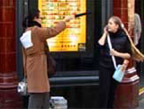
Town Crier
Mobile Phone Abusers Anonymous, a project by Hwa Young Jung, takes a critical look at mobile technology and how it influences social behaviour. She re-engineered a series of mobile phoness to challenge the idea of "being in touch".
One of MPAA performances is Town Crier. The Crier, equipped with micro-phone camera, transmits overheard mobile phone converstaions/visuals to the radio in the room. She picks conversations in public places to question the idea of inhabiting two spaces at once, and the effect on others who share our physical space. [blogged by Regine on we-make-money-not]
Posted by jo at 10:20 AM | Comments (0)
Spychips:

Track(ing) Your Every Move
"RFID, which stands for Radio Frequency IDentification, is a technology that uses computer chips smaller than a grain of sand to track items from a distance. And as this mind-blowing book explains, plans and efforts are being made now by global corporations and the U.S government to turn this advanced technology, these spychips, into a way to track our daily activities-and keep us all on Big Brother's short leash. Compiling massive amounts of research with firsthand knowledge, Spychips explains RFID technology and reveals the history and future of the master planners' strategies to imbed these trackers on everything-from postage stamps to shoes to people themselves-and spy on Americans without our knowledge or consent. It also urgently encourages consumers to take action now-to protect their privacy and civil liberties before it's too late." Spychips: How Major Corporations and Government Plan to Track Your Every Move with RFID by Katherine Albrecht, Liz McIntyre. Also see STOP RFID.
Posted by jo at 10:17 AM | Comments (0)
Transactions of CHI:
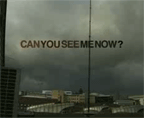
Can You See Me Now?
"We present a study of a mobile mixed reality game called Can You See Me Now? in which online players are chased through a virtual of a city by ‘runners’ (i.e., professional performers equipped with GPS and WiFi technologies) who have to run through the actual city streets in order to catch the players. We present an ethnographic study of the game as it toured through two different cities that draws upon video recordings of online players, runners, technical support crew, and also on system logs of text communication. Our study reveals the diverse ways in which online players experienced the uncertainties inherent in GPS and WiFi, including being mostly unaware of them, but sometimes seeing them as problems, or treating the as a designed feature of the game, and even occasionally exploiting them within gameplay. In contrast, the runners and technical crew were fully aware of these uncertainties and continually battled against them through an ongoing and distributed process of orchestration.
As a result, we encourage designers to deal with such uncertainties as a fundamental characteristic of location-based experiences rather than treating them as exceptions or bugs that might be ironed out in the future. We argue that designers should explicitly consider four potential states of being of a mobile participant – connected and tracked, connected but not tracked, tracked but not connected, and neither connected nor tracked. We then introduce five strategies that might be used to deal with uncertainty in these different states for different kinds of participant: remove it, hide it, manage it, reveal it and exploit it. Finally, we present proposals for new orchestration interfaces that reveal the ‘seams’ in the underlying technical infrastructure by visualizing the recent performance of GPS and WiFi and predicting the likely future performance of GPS." From Can You See Me Now? by Steve Benford, Andy Crabtree, Martin Flintham, Adam Drozd, Rob Anastasi and Mark Paxton + Nick Tandavanitj, Matt Adams and Ju Row-Farr
Posted by jo at 08:30 AM | Comments (0)
October 04, 2005
Ubiquitous Computing
![]()
Letter from Tokyo: Ubicomp 2005
"...The field of Ubiquitous Computing has gained strength as an often cited technology goal since Xerox PARC scientist Mark Weiser first defined it as a field in the late 1980s. Ubicomp is both a conference, and a discipline - and hence the term causes some confusion. 'Ubiquitous' (or 'pervasive') computing has been defined as 'technology that recedes into the background of our lives.' This excludes WIMP interfaces (acronym WIMP stands for Windows, Icons, Menus and Pointing device) and traditional desktops. But beyond that, there are no clear rules. Are mobile phones 'ubicomp?' Maybe. What about RFID? (Radio frequency identification, or RFID, is a generic term for technologies that use radio waves to automatically identify people or objects.) I'm defining these terms because Mark Weiser's ghost still hangs over the gathering more than five years after his death, both in the memory of people who knew him and in his inspirational words. The interpretation of those words, however, remains unsettled...
Ubicomp-the-conference and ubicomp-the-field are frustrating because they promise the impossible. The promise of computing technology dissolving into behavior, invisibly permeating the natural world around us cannot be reached. Technology is, of course, that which by definition is separate from the natural; it is explicitly designed that way. Technology only becomes truly invisible when, like the myriad of pens sold in Japan's department stores, it's no longer seen as technology at all. Deliberately creating something 'invisible' is self-defeating. I can think of few recent technologies as visible to the public as RFID, no matter how physically 'invisible' it might be." Read entire post [blogged by Elizabeth Goodman on Confectious]
Posted by jo at 04:36 PM | Comments (0)
Society for Literature, Science, and the Arts' Conference

Emergent Systems, Cognitive Environments
A few of the many papers being presented at the Society for Literature, Science, and the Arts' Emergent Systems, Cognitive Environments conference--Chicago IL, November 10-13, 2005:
A6. Roundtable: Thresholds of Performance--Organizer: Sha Xin Wei, Fine Arts and Computer Science, Concordia University:
"The panelists (Toni Dove, Kevin Quennesson, Tirtza Even) explore to what extent and how performance needs to be noticed, and how performance needs to be intended and posed to be noticed. What makes a movement a gesture rather than a tic? What happens when we interpose and mix systems of deferred agency, whether it's chorography of rehearsed human perfomers or a network of software video and audio processes? What sorts of entanglement pull people and performance out of the background of unmarked occasions into marked events? The panelists' works reveal multiple thresholds between object and substrate, between scripted and emergent event. We ask of the artists: What new forms of performance can we witness in collective or public spaces? How do such events--organized activity by analogy with organized sound--reshape our notions of performance as well as public space? What are the significances of such coordinated public gestures? How do "things" of "common concern" emerge from such actions? How do meanings and subjects unfold under the interweaving, resonances, or costructuration of performances in public?"
Markus Hallensleben, Modern German Literature, University of British Columbia, The Emergence of Tissue Engineering as Textual Figuration: Stelarc's Cooperation with Tissue Culture and Art:
"In his most recent project, the Australian based performance artist Stelarc (Stelios Arcadiou) describes plans to implant a third ear onto his body. I will portray his project, which is developed with the assistance of the Australian research and performance group Tissue Culture & Art, as an example of how techniques of tissue engineering can be applied to artwork. Since Stelarc's third ear will demonstrate the extension of the human body to a highly artificial but living sculpture, it critically mirrors scientific performances, and it reveals an aesthetic paradox of mythical ritual and objective norm in medical sciences. In his project of a third ear, Stelarc reflects the socio-communicative act of a medical experiment and the act of surgery as an aesthetic act of art performance. My analysis will give an answer to the questionable production and reception of the experiment by interpreting the "mouse with three ears," as artwork, even as text, not only because the term tissue comes, like text, from the Latin word texere, but because here we also find the performance of the metaphor (cognitive figure of thought). I will argue that--with the extension of the science to life creations--their performances also have to be seen like other performances based on text or body."
Mark Pizzato, Theatre and Film, UNC/Charlotte, Neurotheatre: Evolving Ghosts in the Human Brain:
"Current discoveries in cognitive neuroscience are changing our understanding of theatrical performance, as an emergent system inside the brain (along with Self and Other consciousness), shared between humans in particular cultural environments. This presentation is taken from my forthcoming book "Ghost Theatres, Movies, and the Brain" (palgrave Macmillan 2006). I will investigate the evolution of episodic, mimetic, myth-making, and theoretic cultures, from hominid to human (according to psychologist Merlin Donald), regarding the ghostly characters of Self and Other within the brain and in performance. How did the interior theatre of the human brain develop over millions of years--towards various cultural modes of mimetic and narrative performance, involving a common neuroanatomy (and its "inner environment" in Dennett's terms), yet distinctive traditions of stage and screen drama today? How are we transforming our cognitive environments and emotional drives, through the current "ghost in the machine" of the brain, expressed by performance technologies?"
Kris Paulsen, Rhetoric, University of California at Berkeley, The Telecrowd:
"In Sidney Lumet's 1976 film "Network," newscaster Howard Beale stirs his viewers in to a media-resistant rage. He compels his audience to scream from their windows, "I'm mad as hell and I'm not going to take it anymore." Suddenly, a crowd emerges. From windows of every apartment building, faces appear and call out to each other against the unidirectional television. A community of people existing in the same time but in separate spaces emerges. They are linked together by a medium that they all experience in the same time. Building from this image, I examine the telerobotic works of Ken Goldberg (Demonstrate, 2004) and Marie Sester (Access, 2003) in relation to Sartre and Merleau-Ponty's theories of the "presence of others." These philosophers will help us to conceptualize mediated environments that privilege real time over real space, specifically in relation to how we understand co-presence and the ethics of seeing and being seen."
John Bruni, South Dakota School of Mines and Technology, Towards an Ecology of Performance: Edith Wharton with Lynn Margulis and Dorion Sagan:
"While Margulis and Sagan's "What is Life?" describes life in the performative, as a becoming rather than a being, their work need not be limited to a debate about holistic naturalism. Their next book, "Acquiring Genomes," argues against the expressing of evolutionary theory through reductive language of economic competition. I wish to look at their work with ecosystems as laying the groundwork for redefining the importance of social environments. Their argument lends support to the shaping effects of environment on self-identity, a point that becomes even more pronounced when read through Judith Butler's theory of social performance. Using the novels of Edith Wharton as a stage upon which these themes become played out, my paper looks at how the reductive theory of evolution that Margulis and Sagan critique stems from an overemphasis on individualism in the twentieth century--the same critique which Butler politically and culturally employs. I hope to show how evolution, seen as a narrative which Wharton is deeply invested, can be seen in a new light; that read through Margulis, Sagan and Butler, a cultural application of evolution need not be read as a cariacature of "social Darwinist" thinking, but instead as a challenge to regard the social environments in which we live as modeled upon the dynamism of ecosystems."
Julia Kursell, Max Planck Institute for the History of Science, Molecular Musicology--Hearing with David Tudor:
"A Thousand Plateaus" begins with one page of music, entitled "piano piece for David Tudor." This music looks completely unfamiliar; the lines of the staves seem to be inextricably confused. Its composer, Sylvano Bussotti, insisted that the name in the title was not a dedication to the famous avant-garde pianist, but rather an indication of the instrument: Tudor was known to play what seemed unplayable. Whether composed for him or by him, what he played reconfigured instrument and player. It made the human disappear in a relation of instrumental parts that became indistinguishable. The sounds that would result from these configurations were unpredictable for the composer as well as for the listeners. Thereby interrupting the relation between notation and sound, the musical performance gave access to the "molecular content" of music: hearing could be heard. The role of this music in the philosophy of "A Thousand Plateaus," I will argue, was to contribute to a first formulation of a new science of hearing."
Talan Memmott, Dirty Code:
"10 lectures in 10 minutes: dirty code, that makes the harsh protocols, the reasoned syntax of code entirely unreasoned for the desiring machine, the immediate cyborg at the terminal...the extermintaion of terms, the execution as termination...move toward a taxonomadic circuit of, or "tweening," of identity--moving through, across, between various protocols; mostly hidden. It is the surface, though, that "matters"...the point, or place at which the contact is made, where one finds the meaningful product, the product that matters for oneself. This here, at the terminal, on the screen is still severe sublimation of what matters to the product, how it is made material--the relays that form the [spaceless] space between. What matters is the suspect materiality of what matters to the "I" that is the user--here and there. The ten lectures that make up this performance, will not be performed in order. The sequence of the lectures, the performance as a whole will be recombined on the fly, in the moment. The themes for the lectures will include such cryptic (or fantastical/phenomenological) subjects as technontology, [sur]faciality, narcisystems...Improvised diagrams, recursion, emergence, and the use of the neologisms all play a part in making the code of the performance dirty."
Alan Sondheim, Dirty Code:
"Code/program/operators on two levels--that of the performative or symbolic, and that of the referent. In "Dirty Code," as in life, the two are interwoven, 'messy'. It's this messiness that constitutes culture, art, as well as the problematic ideology of purity that underlies everything from Mecca through the Torah to Shinto. My performance exists in the space among codes, cultures, languages, bodies, problematizing these, attempting to rein in the symbolic veering out of control."
Ed Chang, University of Maryland, A Friendster Story: Social Network as Narrative:
"The proliferation of so-called social network applications, like Six Degrees, in the past and Friendster or Tribe.net, in the present, raises the immediate questions: Why is it suddenly important to identify, quantify, and digitize one's friendships, acquaintances, and connections? More importantly, why is it important to be able to see the network? It can be argued that the aggregation of these connections tells a story about cyberculture, about cyberidentity; it is a narrative that critiques and radicalizes cyberspace as a space, place, and temporality of inclusion and exclusion. How do these applications themselves succeed or fail at figuring, graphically and metaphorically, social connections? Finally, how do social networks map and configure self, geography, and conceptions of cyberspace as community?"
Dene Grigar, English, Texas Women's University, 'When Ghosts Will Die': Narrative Performance Through the Use of Emergent Technology:
"This presentation discusses "When Ghosts Will Die," a performance-installation that utilizes multi-sensory elemets such as sound, images, light, and text produced by motion-tracking technology and computers to tell the story about the dangers of nuclear proliferation. Inspired by Michael Frayn's play, "Copenhagen," it explores the use of non-linguistic elements in the service of telling stories. While motion-tracking systems have been used in surveillance and training, as well as in the development of virtual reality experiences, smart rooms, human computer interfaces, media arts performances and installations, health and therapy, and for enriching the ambience in computer and video game environments, spaces enhanced by motion-tracking technology have not yet been fully explored as potential for storytelling. The focus of this presentation, then, is to detail ways this emergent technology innovates narrative, particularly those entailing live performance."
See full program [PDF] [via ELO]
Posted by jo at 11:46 AM | Comments (0)
RFID is X-ray vision

The Demands of Sentient Computing
"ABSTRACT: Making RFID tags as ubiquitous as barcodes will enable machines to see and recognize any tagged object in their vicinity, better than they ever could with the smartest image processing algorithms. This opens many opportunities for "sentient computing" applications. However, in so far as this new capability has some of the properties of X-ray vision, it opens the door to abuses. To promote discussion, I won't elaborate on low level technological solutions; I shall instead discuss a simple security policy that addresses most of the privacy issues. Playing devil's advocate, I shall also indicate why it is currently unlikely that consumers will enjoy the RFID privacy that some of them vociferously demand." From RFID is X-ray vision by Frank Stajano, University of Cambridge Computer Laboratory.
Posted by jo at 08:50 AM | Comments (0)
Emotional Fractal
Posted by jo at 08:41 AM | Comments (0)
Field Works:
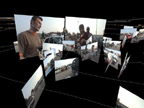
landscape + activity visualizations
"Currently close to my place in Geneva, there is an interesting art exhibition by MASAKI FUJIHATA called “Field Works” (at the Centre Saint Gervais). It happens to be close to locative media arty concepts:
Masaki Fujihata has worked for some fifteen years on new forms of visualizing knowledge, space and time. He is intrigued by the possibilities of recording three-dimensional data and has elaborated a complex yet ultra-lightweight electronic system that goes along with him in his travels around the globe, enabling him to capture in a surprising way the landscapes he has encountered. This equipment consists of a backpack topped by a GPS receiver and a wide-angle video camera to which are attached a directional microphone, a pocket computer, and an electronic compass.
Kitted out with his equipment, Fujihata records the regions he visits, inviting us to tag along with him on his singular walks. Each of the sites where these walks take place was chosen in terms of the possibility of developing a project there linked specifically with its geography and history. (…)
All of the material (images, interviews, spatial coordinates, camera positions) gathered in the course of these trips is brought together in a computer. At the editing stage Fujihata cuts and recomposes the itinerary along the route recorded by the GPS, attaching frames—their orientation and movements—to its tangled threads and thus staggering the shots throughout the space-time. Viewers can then see recreated on the projection screen the different views captured during the walk. These are exactingly restored to their spatiotemporel sequence thanks to the coordinates furnished by the GPS, which serves as a thread running through the reading.
This three-dimensional cartography introduces a topography that immerses viewers in the experience of a virtual excursion. They navigate in front of a screen, building other stories while following the GPS itinerary, which guides them through the twists and turns of a landscape that has been laid out by multiple points of views." [blogged by nicolas on pasta and vinegar]
Posted by jo at 08:30 AM | Comments (0)
October 03, 2005
aRt&D:
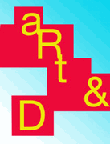
Research and Development in Art
aRt&D: Research and Development in Art lays open a new investigative field of art that emerged in the last few decades as a result of media and technology influences. aRt&D introduces the diversity of this new art domain to a broader audience. It is the first book that is entirely dedicated to artistic research and development.
In the past decades a new international trend has emerged within the arts, usually referred to as 'electronic', 'digital', or 'interactive' art. In the 1980s, artists mainly worked with radio and video, where in the last fifteen years digital media and network technologies have emerged as their instruments of choice. This new art domain is characterized by collaboration between artists, designers, engineers and scientists, who join forces in researching and experimenting with new opportunities for using technology for artistic ends.
aRt&D: Research and Development in Art not only provides a unique insight in the art practice through essays in which artists write about their personal experiences, it also develops a theoretical framework for these projects. The book contains contributions by the award-winning performance group Blast Theory, media artist Thecla Schiphorst, art critics Josephine Bosma and Rudolf Frieling, media theorist Andy Cameron, curators Mark Hansen and Inke Arns, philosopher Andrew Benjamin, and many others. Timothy Druckrey, expert in this field, evaluates the importance of artistic research and development so far. aRt&D positions itself as a pioneering work: it is the first book ever published that focuses in depth on interdisciplinary research and development from an artistic perspective.
Contributor: Matt Adams, Q.S. Serafijn, Andy Cameron, Aske Hopman, Zoltan Szegedy-Maszak, Marton Fernezelyi, Sara Diamond, Edwin van der Heide, Anne Nigten, Sher Doruff, Piet Vollaard, Josephine Bosma, Knowbotic Research, Mark B.N. Hansen, Thecla Schiphorst, Time's Up, Rudolf Frieling, David Link, Christa Sommerer, Laurent Mignonneau, Andrew Benjamin, Pascal Maresch, Inke Arns, Timothy Druckrey.
Published by: V2_Publishing, NAi Publishers [via]
Posted by jo at 12:08 PM | Comments (0)
Systems Esthetics
Technological Shifts
"A polarity is presently developing between the finite, unique work of high art, that is, painting or sculpture, and conceptions that can loosely be termed unobjects, these being either environments or artifacts that resist prevailing critical analysis. This includes works by some primary sculptors (though 0 some may reject the charge of creating environments), some gallery kinetic and luminous art, some outdoor works, happenings, and mixed media presentations. Looming below the surface of this dichotomy is a sense of radical evolution that seems to run counter to the waning revolution of abstract and nonobjective art. The evolution embraces a series of absolutely logical and incremental changes, wholly devoid of the fevered iconoclasm that accompanied the heroic period from 1907 to 1925. As yet the evolving esthetic has no critical vocabulary so necessary for its defense, nor for that matter a name or explicit cause.
In a way this situation might be likened to the "morphological development" of a prime scientific concept-as described by Thomas Kuhn in The Structure of Scientific Revolutions (1962). Kuhn sees science at any given period dominated by a single "major paradigm"; that is, a scientific conception of the natural order so pervasive and intellectually powerful that it dominates all ensuing scientific discovery. Inconsistent facts arising through experimentation are invariably labeled as bogus or trivial-until the emergence of a new and more encompassing general theory. Transition between major paradigms may best express the state of present art. Reasons for it lie in the nature of current technological shifts." From Systems Esthetics by Jack Burnham. Reprinted from Artforum (September, 1968). Copyright 1968 by Jack Burnham.
Posted by jo at 12:01 PM | Comments (0)
PLAN & Mixed Reality Laboratory
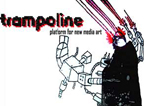
Discussion at Trampoline
The Pervasive and Locative Arts Network and Mixed Reality Lab, Nottingham University will be holding a presentation as part of TRAMPOLINE on Thursday 6th October at 8.30pm, Broadway Mezz Bar, Broadway Cinema, Nottingham. Representatives of PLAN and MRL Drew Hemment, Ben Russell and Steven Benford will be discussing their recent activities in encouraging discourse between artists, scientists and engineers in the field of pervasive and locative media. Come along to this discussion and find out more about the innovative research, development and artistic production which is being pursued in this area.
PLAN: A new international and interdisciplinary research network in pervasive media and locative media has been funded as part of the Engineering and Physical Sciences Research Council (EPSRC) Culture & Creativity programme. The network will bring together practicing artists, technology developers and ethnographers with the aim of advancing interdisciplinary understanding and building consortia for future collaborative projects. It will be of relevance to people working in the arts, games, education, tourism, heritage, science and engineering.
The network will stage three major gatherings. Each gathering will have a distinct form and focus: an initial workshop to launch the network and assess the state of the art; a technology summer camp for artists and technologists, including hands-on prototyping sessions using the facilities at Nottingham's Mixed reality Laboratory; and a major public conference and participatory exhibition as a central component of the Futuresonic 2006 festival in Manchester; as well as a supporting web site and other resources.
Mixed Reality Lab: The Mixed Reality Laboratory (MRL) is an interdisciplinary research initiative at the University of Nottingham. The MRL brings together leading researchers from the Schools of Computer Science, Engineering and Psychology to research mixed reality - new technologies that merge the physical and digital worlds. The MRL is focused on the development and application of mixed reality to visualisation, learning, knowledge management, control systems, ethnomethodological studies, leisure and co-operative work.
Posted by jo at 11:50 AM | Comments (0)
Videobrasil on-line

the most complete database on new media art in the 'Southern Cone'
English: The Videobrasil Cultural Association has put together, in over twenty years, one of the most important collections of electronic art in the Southern Hemisphere, which is now available in this open database to all interested people. Here, you will find information on works, artists, institutions, and collaborators, as well as details on its festivals and exhibitions. With Videobrasil on-line we carry out our diffusion project, and specially focus on the production of the southern circuit. Supported by Prince Claus Fund and SESC SP.
Portugues: Em mais de vinte anos, a Associação Cultural Videobrasil reuniu um dos mais importantes acervos de arte eletrônica do Hemisfério Sul, disponível agora neste banco de dados aberto a todos os interessados. Aqui, você encontrará informações sobre obras, artistas, instituições e colaboradores, além de dados sobre sus festivais e mostras. Com o Videobrasil on-line, levamos à frente nosso trabalho de difusão, com foco voltado principalmente para a produção do circuito sul. Apoio do Prince Claus Fund e SESC SP.
Español: En más de veinte años la Asociación Cultural Videobrasil reunió uno de los más importantes archivos de arte electrónico del Hemisferio Sur, disponible ahora mediante una base de datos online para todo el público interesado. Aquí se puede encontrar información de trabajos, artistas, instituciones y colaboradores, así como detalles de sus festivales y muestras. Mediante Videobrasil online se lleva a cabo un importante trabajo de difusión con foco principal en la producción del circuito sur. Apoyo de Prince Claus Fund y SESC.
Posted by jo at 10:43 AM | Comments (0)
Spinning the Web
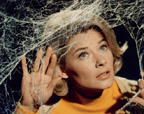
the eBay Connection
What exactly is “Schweinfurt Green,” and what does it have to do with Napoleon’s hair and 25 grams of “Vienna Black” pigment by Andreas Slominski? Or the two small red Sony batteries – what is the relation between them and the two dozen black-&-white amateur photographs of twins or the “Vasen Extasen” by artist couple Anna and Bernhard Blume? – These is the kind of question that arise when the world's online market-place eBay encounters a museum of modern art: The exhibition Spinning the Web – the eBay Connection presents objects that were bought by auction on eBay over a period of several months and juxtaposes them to artworks in the MMK’s collection.
eBay is not only a place where goods change hands, but also an Internet portal, a communications system, a search engine and a global network. Once you’re logged in, you can move by entering key words from one article to the next, just as if you were looking things up in an encyclopedia. This was the path taken
for selecting the objects for the exhibition, too: Depending on the variation and combination of key words, items relating to individual artworks were found as were artworks to fit the respective objects on offer in eBay. Some are clearly connected to each other, while for others the link is more a matter of association, but in all instances the new configurations bring added meaning to both the objects and the artworks. In other words, a track is laid that the viewers can but must not necessarily follow – and as you move down it, repeatedly new individual forms of signification can arise.
How does a museum change things that are placed within its walls? This has been one of the fundamental questions tackled by modern art ever since Marcel Duchamp submitted an urinal – placed flat on its back, signed R. Mutt and entitled ›Fountain‹ - for a non-juried exhibition in New York in 1917. And it is this issue that is being rejuvenated for this joint presentation of art and non-art here; and we are foregrounding the imaginative potential concealed behind the transformative powers of the museum as an institution. In this sense, Spinning the Web – the eBay Connection is a journey to things and through the worlds of the imagination, history and present. It is an exhibition about exhibiting itself: What is already innate in the combined presentation of MMK artworks is intensified and radicalized by the expansion to include non-artworks.
Sept. 24, 2005 - Jan. 29, 2006
Museum für Moderne Kunst
Domstrasse 10, 60311
Frankfurt am Main, Germany
Tues.-Sun. 10 am to 5 pm
Wed. 10 am to 8 pm, Mon. closed
Tel. +49 (0) 69 212 30447
Fax: +49 (0) 69 212 37882
Email: mmk@stadt-frankfurt.de
[via]
Posted by jo at 10:12 AM | Comments (0)
HOW DOES YOUR CITY AFFECT YOU?

Glowlab: Open Lab at Art Interactive
HOW DOES YOUR CITY AFFECT YOU? Glowlab: Open Lab--Cambridge, MA, is your playground during an eight-week psychogeography festival and exhibition at Art Interactive; October 14, 2005 – December 11, 2005.
Glowlab, a Brooklyn-based psychogeography network presents Open Lab at Art Interactive. During this festival and exhibition curated by Christina Ray, more than twenty artists will research the effects of the urban environment on emotion and behavior by leading a series of public events. Each weekend of this unique festival and exhibition, several Glowlab artists will be “in-residence” at Art Interactive to lead interactive public events in the neighborhood. These include a wearable trash workshop, a laughing bike tour, a lesson in text-messaging the sky, and an informal conversation with a suitcase. While artists lead projects in the neighborhood’s public spaces, the is transformed into a working lab complete with video and web-based works and project documentation in the form of maps, photos and other materials.
Posted by jo at 09:35 AM | Comments (0)
iGrid 2005

Eye-Popping Streaming Film Debuts
"What do high-definition video of seafloor volcanoes and avant-garde Japanese digital cinema have in common? They're both examples of the kinds of bandwidth-intensive information that can be streamed live from remote locations, over ultra-fast optical networks.
And both were demonstrated this week at iGrid 2005. The week-long computing conference, which showcases research in high-performance, multi-gigabit networks, was held at UC San Diego's new Calit2 (California Institute for Telecommunications and Information Technology) facility.
"When you can stream content this high-resolution, you can start thinking about movie theaters as a place where live events can be displayed -- sports, fashion, politics, anything," said Laurin Herr of Pacific Interface, an Oakland-based tech consulting firm that produced the demonstration. "What color film did to audiences used to viewing black and white, what stereo sound did to audiences used to hearing mono, high-definition digital cinema will do to us."" From Eye-Popping Streaming Film Debuts by Xeni Jardin, Wired.
Posted by jo at 08:58 AM | Comments (0)
Re=purpose of Information:
Art as Network
"This paper presents an analytic perspective on the nature of Art as Network. The network (internet and intranets) is described as having properties of a nonlinear complex system, which serve to enable a network semiotic enabled by entailment meshwork. The network semiotic includes the characteristics of hierarchical structure, tendency towards self-organization and chaotic attractors, resulting in the emergence of self-similar alternates which function as dissimulators of interaction and immediacy. Art as Network is an exploration of the pandemonium of agencies forming entailment meshwork.
Art as Network is intended as a subject of discourse, not declaration. Certainly, I do not suppose that the particular theoretical investigations that I have chosen to discuss herein are the only points where the discourse of Art as Network is possible. My emphasis on complexity and semiotics involving entailment mesh, nonlinear dynamics, self-organization, homogeneity, dissimulation and the notion of alternates, is to establish a framework in which are present domains from which the artist might experiment. From Re=purpose of Information: Art as Network by Joel Slayton, SWITCH, V:4 N:2
Posted by jo at 08:45 AM | Comments (0)
free103point9 and Rhizome

Open Call for Transmission Art Web Projects
free103point9 and Rhizome are pleased to announce a collaborative call for web-based works that explore transmission as a medium for creative expression. Projects should practically and/or conceptually incorporate transmission themes and tools. Applicants are encouraged to visit free103point9's online Study Center resource for historical, technical, and cultural reference materials on Transmission Art.
Projects should have been completed within the last year of the opening of the exhibition: January 7, 2006. Projects that are in-development at the time of submission will be considered as long as their completion date seems to fit realistically with the exhibition timeline. A modest artist fee will be provided in support of selected projects. We welcome a wide range of interpretations and ideas.
Selected projects will be included in an online exhibition featured by both free 103point9 and Rhizome websites January-March 2006. A live performance and/or presentation event will also take place during the duration of the exhibition.
Submission Deadline: October 31, 2005
Notification: November 14, 2005
Online Exhibition: January-March 2006
Presentation/Performance: March 2006
APPLICATION
Please include the following items in your application materials. Proposals should be emailed to opencall[at]rhizome.org no later than midnight October 31, 2005.
Questions regarding your proposal should be directed to:
Lauren Cornell (laurencornell @ rhizome.org) and
Galen Joseph-Hunter (gjh @ free103point9.org)
Name of Artist/Collective
Contact e-mail
Contact phone
CV/Resume
Artist Statement: Without exceeding 500 words, please describe your current artistic practice.
Proposed Project Narrative:Without exceeding 1000 words, please describe your project.
Project Timeline: Please outline your development strategy in order to meet a launch date of January 1st.
Work Samples: Please provide a list of URL references to previous work.
Panelists:
Lauren Cornell, Rhizome Executive Director
Francis Hwang, Rhizome Director of Technology
Galen Joseph-Hunter, free103point9 Executive Director
Tianna Kennedy, free103point9 NYC Project Coordinator
Tom Roe, free103point9 Program Director
About free103point9
free103point9 is a nonprofit media arts organization focused on establishing and cultivating the genre Transmiss ion Arts by promoting artists who explore ideas around transmission as a medium for creative expression. These investigations include practices in AM and FM radio, Citizen's Band, walkie-talkie, generative sound, and other broad and microcasting technologies utilizing the transmission spectrum. free103point9 programs include a performance / exhibition / transmission series, an online radio station, a distribution label, an education initiative, and most recently an artist-in-residency program, and forthcoming study center and archive at free103point9 Wave Farm, located on 30 idyllic acres in upstate New York, 120 miles north of New York City.
Founded in 1997 as a microcasting artist collective, free103point9's goals during the formative years were focused on the microradio movement fight for the public's access to its own airwaves. free103's mobile operations made airtime available to community voices, local bands, and most significantly to a group of under-served artists shaping conceptual works specifically for radio transmission.
About Rhizome
Rhizome.org is an online platform for the global new media art community. Our programs support the creation, presentation, discussion and preservation of contemporary art that uses new technologies in significant ways.
Rhizome was founded in 1996 as a mailing list for some of the first artists experimenting with making art online. Since that time, Rhizome has established itself as a central hub for the new media art field and come to offer a variety of resources and services including archives of art and critical writing, new media arts-related publications, an annual Commissions program and a youth outreach initiative. Rhizome became a n onprofit in 1998, and formed an affiliation with the New Museum of Contemporary Art in 2003.
Posted by jo at 08:36 AM | Comments (0)
October 02, 2005
Institute of Artificial Art Amsterdam

Interface
Arthur Elsenaar and Remko Scha cooperate in the "Institute of Artificial Art Amsterdam" (IAAA). They jointly developed a series of automatic performance-pieces, video-installations and audio-installations. At the 1997 Ars Electronica Festival they premiered Arthur and the Solenoids: an "algorithmic choreography" piece which displays computer-controlled motions of human facial muscles, accompanied by computer-controlled electric guitars. Their lectures on computer-controlled facial expression (with computer-voice "Huge Harry") were presented at many scientific conferences, theatre festivals and art exhibitions, including the Dutch Electronic Arts Festival, the Annual Meeting of the American Anthropological Association, and the Research Colloquium of the MIT Media Lab. Elsenaar and Scha also carry out experiments with automatic broadcast radio and with new forms of internet radio. Their theoretical and historical reflections on technological art were published in journals such as Mediamatic and Leonardo Music Journal. Read PDF. [originally posted by nick from Grand Text Auto, ReBlogged by Fede on Reblog]
Posted by jo at 10:18 AM | Comments (0)
FlirtSkirt
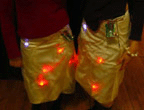
Clothing as Palette
FlirtSkirt by MICHAL BRIL and SONALI SRIDHAR: Explorations in wearable technologies began with our interest in arbitrary social interactions among people in public spaces. Instances of interaction seem to occur through body langauge, common interests and common brands. Some of our observations led us to see that the i-pod, when new in the market, called for the silent nod when you passed another person with white ear buds. Walking dogs are almost an instantaneous conversation starter, and people who might otherwise come from disconnected lives start a conversation on the same frequency. This struck us as a good starting point for our piece.
User A wears her skirt and turns it on and her skirt holds the colours that have been initialized. On reaching a particular distance from user B the outfits start communicating with each other. They recognize the initial colors, mix them and display the shared color on both outfits. In addition when in range the outfits dim. When user A and B have separated from each other and moved beyond the range of frequency, they leave with the shared color ready for interactions with new users.
Posted by jo at 09:56 AM | Comments (0)
October 01, 2005
Desert Rain

Orchestrating a Mixed Reality Performance
"Desert Rain is a game, a performance and an installation created by Blast Theory in collaboration with the Mixed Reality Lab at the University of Nottingham. Commissioned by Contemporary Archives in Nottingham, the ZKM (Centre for Art and Media) in Karlsruhe in association with DA2 in Bristol and the KTH (Royal Technical Institute) in Stockholm, the piece was premiered in 1999. To date it has been presented in Nottingham, Karlsruhe, London, Manchester, Stockholm, Rotterdam, Glasgow, Bristol, Prague and Middlesborough. Desert Rain was shortlisted for an Interactive Arts BAFTA in 2000.
This essay draws on ethnographic surveys using interviews, video recordings and direct observation to explore what techniques are used for orchestrating the participant's experience in Desert Rain." Chapter 12: Orchestrating a Mixed Reality Performance - Desert Rain by Boriana Koleva, Ian Taylor, Steve Benford, Mike Fraser, Chris Greenhalgh, Holger Schnädelbach, School of Computer Science, The University of Nottingham; Dirk vom Lehn, Christian Heath, The Management Centre, Kings College London; and Ju Row Farr, Matt Adams, Blast Theory UK, A Guide to Good Practice in Collaborative Working Methods and New Media Tools Creation.
Posted by jo at 11:15 AM | Comments (0)
TRANSMEDIA :29:59
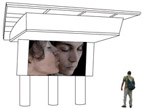
media art in public urban space
Year Zero One is pleased to present TRANSMEDIA :29:59, a year long exhibition on the pedestrian level video billboard at Yonge-Dundas Square in downtown Toronto. Launched August 1st 2005, TRANSMEDIA :29:59 features one minute video works 24/7 every half hour on the 29th and 59th minutes. Featured for the month of October is Risa Horowitz's 'Studiopace' & Honeybytes 'Bleury'.
Risa Horowitz's Studiopace is a 60 second video in honour of those thoughtful moments an artist has alone in studio, and the hustle and bustle of passersby at Yonge and Dundas in Toronto's downtown core. A bit of corresponding banality, of killing time, of getting somewhere on important business, of getting nowhere at all, and an homage to Bruce Nauman's old studio experiments conducted partially out of boredom and a love for absurd repetition.
Honeybyte's Bleury is a layering of two different video sequences, which juxtapose perceptions of the urban landscape and the innocent yet inquisitive eyes of children.The first sequence keeps in mind the site-specific nature of the work. It documents a night at the intersection of Ste. Catherine and Bleury streets in Montreal, where the commercial and entertainment districts collide. The sequence captures the aesthetic of Montreal's urban landscape. Lights, cars, billboards and people infuse the landscape and overwhelm the senses. The second sequence, which is layered over the first, is of school children in a garden looking deeply into the camera lens. Their gazes are filled with naivety, and yet seem to convey an energetic and mischievous curiosity
YEAR ZERO ONE is an on-line artist run centre which operates as a network for the dissemination of digital culture and new media through web based exhibitions, site-specific public art projects, an extensive media arts directory, and the Year0.
Posted by jo at 09:41 AM | Comments (0)

